Acquisitive Growth – Workshop 1 (Business Assessment)

The Appleton Greene Corporate Training Program (CTP) for Acquisitive Growth is provided by Mr. Chicles Certified Learning Provider (CLP). Program Specifications: Monthly cost USD$2,500.00; Monthly Workshops 6 hours; Monthly Support 4 hours; Program Duration 24 months; Program orders subject to ongoing availability.
If you would like to view the Client Information Hub (CIH) for this program, please Click Here
Learning Provider Profile

Mr Chicles is an approved Certified Learning Provider (CLP) at Appleton Greene who is a business leader and strategist with broad experience in the global multi-industrial, aerospace and defense sectors. He is a seasoned operational leader of global industrial businesses, leading transformational strategies in highly competitive markets.
As a senior, C-suite strategist for multiple major industrial corporations he has led multiple mergers, acquisitions, divestitures and restructurings, as well as corporate break-ups and spin-offs. He has a distinguished track record of successful transformations of complex organizations in dynamic and uncertain market conditions while engendering the trust and buy-in of employees, customers, vendors, owners, corporate leadership and boards of directors.
A highly engaged leader at the personal and team level he has demonstrated the ability to engender effective senior teams and boards. He’s also an active mentor, teacher and community leader.
Mr Chicles is an active board member with AES Seals, global leader in sustainable reliability engineering, and Micro Technologies Inc, an electronics and advanced manufacturing company. He is a principal partner with ProOrbis Enterprises®, a management science consultancy with premier clients such as the US Navy and PwC, as well as the principal of Xiphos Associates™, a management and M&A advisory. Recently, he served as Board Director and Chairman of Global Business Development with Hydro Inc. the largest independent pump and flow systems engineering services provider in the world.
He was President of ITT’s Industrial Process / Goulds Pumps business segment a global manufacturer of industrial pumps, valves, monitoring and control systems, and aftermarket services for numerous industries with $1.2 billion in revenue, 3,500 employees and 34 facilities in 17 countries. Preceding this role he served as Executive Vice President of ITT Corporation overseeing the creation of a newly conceived ITT Inc. following the break-up of the former ITT Corporation to establish its strategy and corporate functions such as HR, communications, IT and M&A, building the capabilities, policies and organizations for each.
He joined ITT Corporation’s executive committee as its strategy chief in 2006 and instituted disciplined strategic planning processes and developed robust acquisition pipelines to respond to rapidly changing markets. Created successful spin-offs of 2 new public corporations Exelis Inc. and Xylem Inc. ITT Corporation was named one of “America’s Most Respected Corporations” by Forbes for exemplary management and performance during his tenure there.
Before joining ITT, Mr Chicles served as Vice President of Corporate Business Development and head of mergers and acquisitions for American Standard / Trane Companies, where he initiated and closed numerous transactions and equity restructurings globally.
Additionally, he created and led the corporate real estate function which entailed more than 275 real estate transactions around the world.
He began his career at Owens Corning rising through the ranks in various operational roles to Vice President of Corporate Development.
Recently, he taught advanced enterprise strategy at Stevens Institute of Technology as an adjunct professor and still supports start-ups through the Stevens Venture Center. He continues to be active as the Founding Board Member with several successful start-up technology businesses and non-profit organizations. A community leader, Mr Chicles has held the role of President of the Greek Orthodox Cathedral in Tenafly, N.J., He also led trips abroad to Cambodia and Costa Rica to build sustainable clean-water solutions and affordable housing.
His formal education includes earning a Masters of Business Administration from The Wharton School at the University of Pennsylvania, and a Bachelors in Finance from Miami University.
MOST Analysis
Mission Statement
Assessments can be incredibly valuable tools for organizations of all sizes. A comprehensive assessment methodology can help you evaluate your organization across multiple dimensions. But what are business assessments, what do they entail, and what are the benefits? Business assessments can help you identify areas of improvement and potential acquisitive growth. By taking a comprehensive approach, you can get an accurate picture of your organization’s strengths and weaknesses. Assessments can also help you develop actionable plans to improve your business. At their core, business assessments are all about providing clarity. When you’re feeling overwhelmed by the day-to-day details of running a business, it can be difficult to step back and get a clear picture of where your company is headed. That’s where assessments come in. By taking a comprehensive look at your company’s strengths and weaknesses, you can develop a clear road map for success. Assessments are an essential part of any business plan. By evaluating your company’s strengths and weaknesses, you can develop a roadmap for growth. Furthermore, assessments can help identify areas where your company may be at risk. By addressing these risks early on, you can avoid potential problems down the road. In addition, assessments can help you benchmark your company’s performance against others in your industry. This benchmarking process can give you valuable insights into areas where your company may need to improve. Ultimately, regular business assessments are a crucial tool for any organization that is looking to grow and thrive.
Objectives
01. Current State: departmental SWOT analysis; strategy research & development. Time Allocated: 1 Month
02. Analysis Tools: departmental SWOT analysis; strategy research & development. Time Allocated: 1 Month
03. Identify Stakeholders: departmental SWOT analysis; strategy research & development. Time Allocated: 1 Month
04. Core Competencies: departmental SWOT analysis; strategy research & development. Time Allocated: 1 Month
05. Market Differentiation: departmental SWOT analysis; strategy research & development. Time Allocated: 1 Month
06. Mission/Vision Statement: departmental SWOT analysis; strategy research & development. Time Allocated: 1 Month
07. Mapping Future State: departmental SWOT analysis; strategy research & development. 1 Month
08. Set Department Objectives: departmental SWOT analysis; strategy research & development. Time Allocated: 1 Month
09. Prioritizing Tasks : departmental SWOT analysis; strategy research & development. Time Allocated: 1 Month
10. Set KPIs: departmental SWOT analysis; strategy research & development. Time Allocated: 1 Month
11. Create a Project Schedule: departmental SWOT analysis; strategy research & development. Time Allocated: 1 Month
12. Monitor Data over Time: departmental SWOT analysis; strategy research & development. Time Allocated: 1 Month
Strategies
01. Current State: Each individual department head to undertake departmental SWOT analysis; strategy research & development.
02. Analysis Tools: Each individual department head to undertake departmental SWOT analysis; strategy research & development.
03. Identify Stakeholders: Each individual department head to undertake departmental SWOT analysis; strategy research & development.
04. Core Competencies: Each individual department head to undertake departmental SWOT analysis; strategy research & development.
05. Market Differentiation: Each individual department head to undertake departmental SWOT analysis; strategy research & development.
06. Mission/Vision Statement: Each individual department head to undertake departmental SWOT analysis; strategy research & development.
07. Mapping Future State: Each individual department head to undertake departmental SWOT analysis; strategy research & development.
08. Set Department Objectives: Each individual department head to undertake departmental SWOT analysis; strategy research & development.
09. Prioritizing Tasks: Each individual department head to undertake departmental SWOT analysis; strategy research & development.
10. Set KPIs: Each individual department head to undertake departmental SWOT analysis; strategy research & development.
11. Create a Project Schedule: Each individual department head to undertake departmental SWOT analysis; strategy research & development.
12. Monitor Data over Time: Each individual department head to undertake departmental SWOT analysis; strategy research & development.
Tasks
01. Create a task on your calendar, to be completed within the next month, to analyze Current State.
02. Create a task on your calendar, to be completed within the next month, to analyze Analysis Tools.
03. Create a task on your calendar, to be completed within the next month, to analyze Identify Stakeholders.
04. Create a task on your calendar, to be completed within the next month, to analyze Core Competencies.
05. Create a task on your calendar, to be completed within the next month, to analyze Market Differentiation.
06. Create a task on your calendar, to be completed within the next month, to analyze Mission/Vision Statement.
07. Create a task on your calendar, to be completed within the next month, to analyze Mapping Future State.
08. Create a task on your calendar, to be completed within the next month, to analyze Set Department Objectives.
09. Create a task on your calendar, to be completed within the next month, to analyze Prioritizing Tasks.
10. Create a task on your calendar, to be completed within the next month, to analyze Set KPIs.
11. Create a task on your calendar, to be completed within the next month, to analyze Create a Project Schedule.
12. Create a task on your calendar, to be completed within the next month, to analyze Monitor Data over Time.
Introduction
Referring to the original application and executive summary in the ‘Acquisitive Growth’ Client Information Hub, the first order of business is the “Strategy Development” phase. This is meant to be a self-assessment and evaluation of current strategic context and situation from which to determine if and where acquisitions fit and support a business’s aspirations. A very effective methodology that I may have shared with you prior is to use AJ Laffley’s book “Playing to Win” whereby a company assesses “Where they play” ( the products, markets and segments), “How the win” (the competitive differentiation and value proposition they offer), “Capabilities” (what combinations of people, process and technologies are required) and “Systems” (those foundational elements that a business stands on such as footprint, IT Systems, management systems, talent processes, etc.). By evaluating these elements, a company can then perform a gap analysis and create a strategy to get from current state to the future state they wish to achieve. For example, if a company was successful in the US making differentiated products for a certain set of endmarkets and wanted to grow, they would evaluate first if they could achieve their goals organically. If they cannot, then the likely reason would be a lack in one of these elements such as: a) Need to access new market segments or geographies, or b) need leverage their particular capabilities in new markets or develop new capabilities and so on.
It is through this work that a company focuses their acquisitive growth strategies to in essence fill the strategic gaps they have which practically cannot be filled organically. For example, if a US-Based industrial product company had developed a set of unique products and services that are winning in their existing markets, but found that as their share grows and the markets cycle they have challenges achieving sustainable growth. Suppose then through their strategy work that they identify a new geography/market where they would be able to take their competitive advantage and grow a whole new area of revenues. This methodology or approach would help them Identify this opportunity and to focus on what they need to acquire – new products, channels to market, brand recognition, technical capabilities, etc. In this example, it might be to acquire a similar business into which they instill their capabilities. Or it might be a matter of just acquiring distribution channels that meet certain criteria that would enable them to enter and win in the new market by flowing their existing products through them. Another example might be that in order to penetrate this new market, new products might be needed which in turn could be the focus of acquisitions.
So as you can see, the upfront Business Assessment part of this program is internally focused to determine the acquisition strategy as opposed to externally focused on targets once the strategy is articulated.
In this workshop, you will learn how to carry out a successful business assessment which will in turn, prepare your organization for acquiring growth through an acquisition or merger. It is an in-depth process which will highlight your business’ strengths and weaknesses and highlight areas where inorganic growth may be more effective and fruitful compared to trying to grow organically.
Playing to Win: How Strategy Really Works
How Strategy Really Works is a book about strategy, written by A.G. Lafley, former CEO of Procter & Gamble, and Roger Martin, dean of the Rotman School of Management. The book covers the “transformation” of P&G under Lafley and the approach to strategy that informed it.
This method evolved from Monitor Company’s strategic practice and then became P& G’s standard operating procedure. Throughout their professional lives, they strove to create a solid framework for their strategic approach, a means of imparting the ideas to others, and a process for putting it into practice in an organization. At the end of the day, this is a tale of choices, including the decision to establish a discipline of strategic practice and thinking within an organization. Having a strategic mentality can only help you in the business evaluation phase of acquisitive growth since it enables you to spot change chances and equips you with the skills and knowledge you need to seize them. This, in turn, increases market share and profitability, and makes your business more durable. Knowing where to focus acquisitive growth is vital. A business assessment will highlight which areas and departments would benefit most from this kind of growth, as organic growth may not have been enough for your organization to grow at the rate in which you desired.
The “Playing To Win” Methodology
A corporation will invariably fall short of making the difficult decisions and substantial investments that would make winning even a remote possibility when it sets out to participate rather than win.
But if you play to win, you risk being in error.
The Playbook
A winning aspiration, where to play, how to win, core capabilities, and management systems are the five options listed by the author as a coordinated and integrated set of five alternatives. The strategic decision cascade, the cornerstone of strategy work, and the focus of this book are the five options.
Specifically, the answers to these five interconnected problems are found in strategy:
1. What winning goals do you have? The goal of your business and what makes it inspiring.
2. Where do you plan to play? A field of play where you can realize that goal.
3. How will you succeed? how you’ll triumph on the selected field of play.
4. What requirements must be met? the combination and arrangement of skills necessary to triumph in the selected manner.
5. What management techniques are necessary? systems and policies that support and empower capabilities and choices.
Later in the course, we’ll go into more detail on these ideas and demonstrate how to use them in your business evaluation procedure. The foundation for effective acquisitive growth is laid by this process, which can be used to any business or project and which identifies areas where your company might gain from M&A to remain competitive and fill a niche you might find difficult to fill on your own.
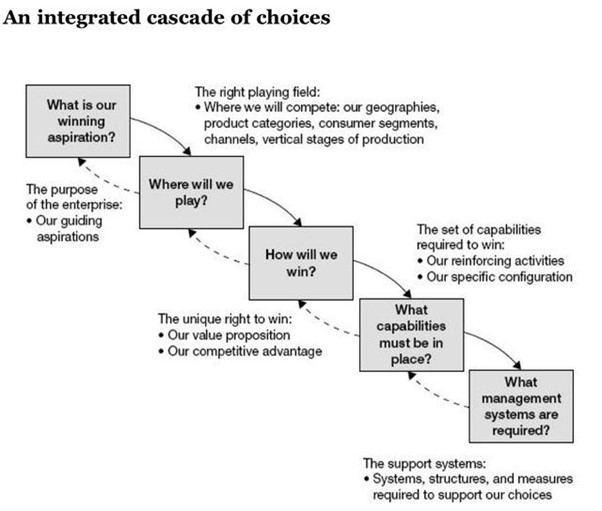
As you can imagine, in small organizations a single choice cascade might exist, whereas in large organizations multiple “levels of choices and interconnected cascades.” Nested cascades means that choice happens at almost every level in the organization.
Winning Aspirations
Statements concerning the ideal future are known as aspirations. Later on in the process of acquisitive growth, a corporation attaches certain precise benchmarks that track progress toward those goals to those ideals. Over time, aspirations can be adjusted and changed. Though they exist to consistently align business actions, aspirations shouldn’t vary day to day and should be made to persist for a while. Future mergers and acquisitions should support these goals.

M&A Failure: Daimler-Benz and Chrysler (1998)
MBA programmes frequently highlight the Daimler-Benz and Chrysler merger as the classic case study of how cultural differences would always result in a deal’s failure.
Some people have claimed that the two civilizations are too dissimilar to ever be combined.
Daimler-Benz made methodical decisions; Chrysler made creative, unstructured decisions. Daimler-Benz salaries were conservative; Chrysler salaries were much less so. And finally, there was the flat hierarchy that existed at Chrysler as opposed to the top-down structure at Daimler-Benz.
The result?
Within ten years, Daimler sold Cerberus Capital Management 80% of Chrysler for $7 billion, giving the cultural relativists a US$20 billion kick in the pants.
This M&A disaster is a prime illustration of how business disagreements may be disastrous. Always look to merge with or buy businesses that share your goals and beliefs in order to ensure a smooth and ultimately successful purchase.
Where to Play
Where to play and how to win define the precise actions of the organization—what the business will do, where it will do it, and how it will do it—in order to fulfill its goals. The winning aspiration broadly defines the scope of the firm’s operations.
The set of options that limit the field of competition is represented as where to play. The questions that need to be posed center on the markets, clients, consumers, channels, product categories, and vertical stage(s) of the industry in question where the company will compete. For instance, during your business evaluation, you might find that expanding through an acquisition or merger may enable you to enter the geographic regions needed for accelerated growth.
How to Win
The playing field is determined by where you play; the options for winning on that field are determined by how you play. It is the key to success in the targeted demographics, markets, channels, and so on. The decision of where to play is closely related to the decision of how to win. Keep in mind that the focus is on winning within the chosen where-to-play areas, not on winning overall.
A company must decide what will allow it to produce distinctive value and sustainably deliver that value to clients in a way that is different from the firm’s competitors in order to determine how to win during the business assessment phase. The exact way a company uses its advantages to provide higher value for a consumer or client, and as a result, superior returns for the firm, is what Michael Porter referred to as competitive advantage.
Excellent plans enable for a certain fit between where to play and how to win decisions that strengthens the business.
Core Capabilities
Two inquiries stem from and bolster the core of strategy: What competences must be there in order to succeed, and what management systems must be in place in order to support the strategic decisions?
Management Systems
The cascade’s last strategic decision is centered on management systems. These are the frameworks that encourage, underpin, and evaluate the approach. They must be specifically created to support the options and capabilities if they are to be truly effective.
Summing Up
During the phase of your business assessment, strategy is an iterative process in which all of the moving pieces impact one another.
Lafley and Martin claim that choosing where to play and working out how to win there is the essence of strategy.
What business are you in?
When asked what industry they are in, the majority of businesses would either describe their product line or the services they provide. For instance, many producers of mobile devices might claim to be in the business of producing smartphones. They probably wouldn’t claim to be in the business of facilitating communication at all times and all places. However, that is their actual line of work, and using a smartphone is merely one method.

Procter & Gamble’s Acquisition of Gillette
P&G announced its largest acquisition ever on January 28, 2005, when it agreed to pay $57 billion to acquire Gillette. A number of the top brands in the world were united in the deal. The biggest manufacturer of consumer goods in the world was P&G. P&G offered everything from Head & Shoulders shampoo to Crest toothpaste. Among Gillette’s top offerings were its renowned razors, Duracell batteries, Braun, and Oral-B dental care items.
The largest consumer goods corporation in the world was created as a result of the merger. The agreement provided P&G additional control over shelf space at supermarkets and other shops around the country as well as expensive real estate. In addition to more than 300 consumer brands like Ivory soap, Head & Shoulders shampoo, Pringles, Crest toothpaste, and Bounty paper towels, P&G has added Duracell batteries, Right Guard deodorant, and Gillette razors. For every share of Gillette common stock, P&G paid 0.975 shares of its own common stock. The acquisition valued Gillette at around $54 per share, or an 18% premium over its closing price, based on the stock’s closing price of $55.32 on January 28, 2005. After acquiring Gillette, P&G had 12 billion-dollar brands in the baby, family, and household divisions and 10 billion-dollar brands in the beauty and health categories. In markets and with clients where P&G brands are not yet completely entrenched, such as home improvement channels, P&G took advantage of Gillette’s robust in-store presence.
In the shorter time frame period, the cumulative returns were negative, but in the longer time window period, they were positive. From 10.7% in the pre-merger period to 13.6% in the post-merger period, the average net earnings margin increased.

The Business Assessment Phase
Organizations of all sizes can benefit greatly from doing business assessments. You can examine your organization across a number of dimensions with the use of a thorough assessment approach. But what exactly are business analyses, what do they entail, and what are the advantages?
What are Business Assessments?
You can use business assessments to find opportunities for organic or acquired growth as well as areas that need improvement. You may accurately determine the strengths and weaknesses of your firm by adopting a thorough strategy. You may create concrete plans to improve your firm with the aid of assessments.
Business assessments are really about giving clarity. It might be challenging to take a step back and obtain a clear image of where your organization is headed when you’re feeling overburdened by the day-to-day details of running a business. The assessments play a role in that. You may create a clear road map for success and identify areas where a merger or acquisition may be able to assist your business grow by conducting a thorough inventory of your company’s strengths and limitations.
What Do Business Assessments Entail?
Business evaluations generally focus on four important areas: operational efficiency, customer happiness, staff satisfaction, and financial health. You may find areas for development and implement the adjustments required to advance your company by carefully examining each of these areas.
Evaluations may be carried either internally or externally. Employees typically do internal assessments, whereas outside consultants typically conduct external assessments. Although external exams are frequently more thorough and offer an unbiased viewpoint, both kinds of assessments can be helpful.
Benefits of Business Assessments
A business evaluation is similar to a physical for your firm. It’s an opportunity to take a step back, assess the organization as a whole, and pinpoint any problematic areas that might be contributing to bottlenecks and stifling progress.
Like you wouldn’t wait years to visit the doctor, you shouldn’t wait years to get a company evaluation. Here are a few of the numerous advantages of this significant exercise:
1. Improved decision-making: When you have all the facts and figures in front of you, it’s easier to make informed decisions about where to invest your time and resources, and where you may benefit form M&A.
2. Greater clarity: A business assessment can help you to see your company more clearly, highlighting areas of strength and weakness that you may not have been aware of previously.
3. Improved Prioritization: Once you know where your company needs to improve, you can develop strategies for moving forward and achieving your goals.
4. Stronger relationships: Assessing your business can also help to strengthen relationships with employees, customers, and other key stakeholders. By openly discussing areas of concern, you can build trust and create a shared commitment to finding solutions.
5. Increased success: Ultimately, undergoing a business assessment can help you to achieve greater success. By taking a proactive approach to identifying and addressing problems, you can set your company on the path to long-term growth via acquisition or merger if you cannot solve these problems organically.

How Can Business Assessments Help My Organization Grow inorganically?
Every company plan must have assessments. You can create a roadmap for organic, or in this case, acquisitive growth by analyzing the strengths and limitations of your business. Assessments can also aid in locating potential risk areas for your business. You can prevent future issues by addressing these hazards right away.
Additionally, assessments can assist you in comparing the success of your business to that of others in your sector. This benchmarking technique might help you gain important insights into potential improvement areas for your business. In the end, regular business assessments are an essential tool for every company seeking to expand and prosper.
How Can I Make the Most of My Assessment Findings?
There isn’t a one-size-fits-all approach to company. Because every business is different, what works for one may not be effective for another. For this reason, it’s crucial to have a thorough evaluation of your company before making any significant choices regarding inorganic expansion. Every area of your organization, from your sales process to your customer experience activities, will be closely examined in a good business assessment. You will receive the data you require to make wise judgements from it.
How then can you maximize the results of your assessment? First, spend some time going over all of the assessment results. Don’t simply concentrate on the aspects of your organization that require improvement; also pay attention to the sections that are presently functioning well. This will serve as a fantastic springboard for transformation.
Make a plan of action based on your findings in the second place. Be clear about your goals and the path you’ll take to reach them.
Finally, put your plan into action and monitor your results. Review your results frequently, and correct as necessary. You can make sure your assessment is a beneficial tool for expanding your business by following these steps.
Business analyses can be quite helpful for businesses of all sizes. You may maximize the results of your evaluation and experience considerable growth for your business with proper planning and implementation.

Internal Analysis
An in-depth investigation of a company’s internal elements, including its resources, assets, and processes is known as an internal analysis. To develop a workable business strategy or business plan, firm decision-makers use internal analysis to precisely pinpoint areas for development or correction. In order to have a complete view of how the firm operates both as an independent unit and as a component of the larger competitive industry, individuals developing the company’s business plan frequently combine an internal analysis with an external study.
Before deciding on growth through acquisition, businesses can pick from a number of models for performing an internal analysis. To find out important details about the internal business processes, resources, and structures, each employs slightly different techniques, strategies, and objectives. The following are a few of the most typical illustrations of internal analytical frameworks:
● Gap analysis: A gap analysis identifies the gap between a business goal and the current state of operations. Companies use gap analyses when they need to identify weaknesses in the business.
● Strategy evaluation: A strategy evaluation is an ongoing internal assessment tool used at regular intervals to establish if a company is meeting its objectives as outlined in a business strategy or plan.
● SWOT analysis: A SWOT (Strengths, Weaknesses, Opportunities and Threats) analysis helps to give companies a broad overview of all internal functions. SWOT analyses are ideal for evaluating the full range of a company’s abilities.
● VRIO analysis: A VRIO (Valuable, Rare, Inimitable and Organized) analysis helps organize business resources. It is ideal for assessing and categorizing a company’s resources.
● OCAT: An OCAT (Organizational Capacity Assessment Tool) assesses internal performance in a variety of specific dimensions. Companies can use the OCAT to establish specific areas of strength or growth.
● McKinsey 7S framework: The seven S’s are strategy, structure, systems, shared values, skills, style and staff. The McKinsey 7S framework ensures that businesses align these seven elements for maximum success.
● Core competencies analysis: The core competencies analysis identifies the unique combination of qualities that separates the business from competitors. It’s best used when determining ways to improve business operations over a direct competitor.
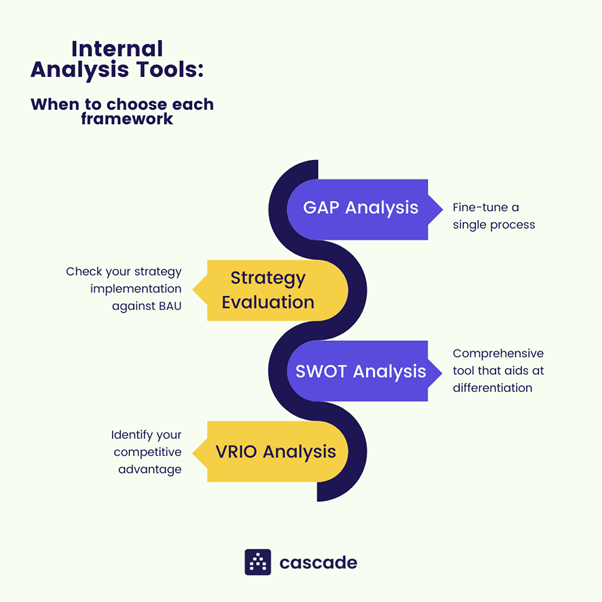
Why is an internal analysis important?
Internal analyses help business leaders identify ways in which they can improve company functions. A few of the most important reasons to conduct an internal analysis include identifying:
● Company strengths
● Structural weaknesses
● Business opportunities
● Possible threats
● Viability in the marketplace
Company strengths
The caliber of the workforce, the accessibility of critical resources, or customer brand familiarity are examples of strengths. Companies can boost their overall success and viability by focusing on their strengths, which can be found utilizing an internal study.
Structural weaknesses
A company’s deficiencies may include things like ineffective training, outdated technology, or inadequate interdepartmental communication, which can be discovered through internal analysis. Weaknesses may have modest effects on the business, such impeding the flow of internal information, or serious ones, like financial losses.
Business opportunities
The ability to spot business prospects is another advantage of conducting an internal study. Opportunities for expansion on both an internal and external level typically exist for businesses. Examples can be bringing a new product to market or modernizing the computer system.
Possible threats
Threats frequently originate from outside sources. However, detecting external risks as part of an internal analysis can assist businesses in preparing for them by maximizing operational strengths, strengthening operational weaknesses, and generating fresh growth prospects.
Viability in the marketplace
The ability to distinguish the business from rivals by identifying a specific niche within the bigger market is one of the most beneficial outcomes of an internal study. This is frequently the long-term objective of performing an internal analysis.
How to conduct an internal analysis
To conduct a successful internal analysis and enhance business functionality, follow these steps:
1. Set your objective
2. Choose a framework
3. Conduct research
4. Follow the framework
5. Set your priorities
6. Apply the findings
1. Set your objective
Establish a purpose or justification for conducting an internal analysis before you begin. For instance, one goal would be to look for fresh, innovative company prospects. Another option would be to cut internal costs. By deciding what you intend to learn from the internal study before you start, you should be able to collect the most relevant data and, as a result, determine which departments would gain from an acquisition or merger.
2. Choose a framework
Pick a framework for internal analysis to apply. While some frameworks concentrate on the growth of the business or its internal structures, others are better at uncovering internal flaws. Look over the available frameworks and pick one that best suits the demands of your business and will enable you to achieve your goal.
3. Conduct research
Obtain information on resources, skills, and potential growth areas from all internal sources. Employee interviews, an examination of the company’s finances, and equipment evaluations may all be included in the research process.
4. Follow the framework
To parse the data, employ the chosen framework. If you’re utilizing a SWOT analysis, for instance, make four distinct lists with each of the SWOT elements serving as the headline. List your research’s strengths, shortcomings, opportunities, and threats in a logical manner.
5. Set your priorities
Review the finished framework and contrast your conclusions with the goal you set out to achieve. Find information that will enable you to decide how to accomplish your goal. If, for instance, you wanted to improve technological capabilities, you may look at what equipment needs to be updated, what employees believe would be more useful for their employment, and what resources are available to meet those demands.
6. Apply the findings
Utilize the results to put a plan in place to achieve the goal. Put new machinery in place of the outdated equipment, using the same example as step 5. To guarantee that staff use the new asset properly and to its fullest potential, provide training.
We will discuss these points in more detail later in the workshop.
Executive Summary
Chapter 1: Current State
Without a better understanding of your own current state, you risk a catastrophic failure with the potential to threaten the existence of both the acquirer and the target—and the financial safety of clients. Do you have the time, resources, people, and infrastructures in place to handle such a move? What are you offering your current clients that potential clients aren’t receiving? Do these offerings have the ability to scale if you bring over more accounts?
You need to determine the feasibility of maintaining your current level of service while also managing newly acquired clients, since they will most likely expect those same services. By taking a closer look at your own business, you are more likely to identify any potential issues before they arise, which puts you in a better position to decide if pursuing an acquisition is the right move.
Researching and evaluating the internal and external elements that have an impact on the firm are necessary for developing an effective business growth strategy. Businesses can identify prospects for growth and competitive advantage by doing an internal review of their current situation. An detailed understanding of the internal workings of the business is necessary to conduct an internal analysis. In this course manual, we define a current state analysis, discuss its significance, and demonstrate how to conduct one.
What is current state analysis?
The management technique of current state analysis, also known as as-is process analysis, is used to identify and assess a company’s processes and workflows. As-is diagrams, which describe an organization’s current procedures, are also used in these assessments. By assessing your current functions for effectiveness, efficiency, dependability, and customer satisfaction, as-is procedures assist you figure out how to improve your company duties. The goal is to determine the advantages, disadvantages, opportunities, and threats of each process. You can then evaluate where a merger or acquisition might help speed growth after these have been identified.
Either the entire organization or a single team procedure is the focus of a present status analysis. The secret is to perform data-driven, observational, and analytical research. Additionally, measurements allow you to assess how well a company is fulfilling its obligations and what modifications are necessary.
Process analysis of current and future states
While the as-is processes analysis depicts the state of your operations at the moment, the future state processes analysis demonstrates the organization’s potential. A tool for enhancing the current procedure is future analysis. Starting with an analysis of what is happening in the organization right now and ending with how you want it to look in the future, the process management strategy is composed. You must take into account business objectives, the interactions between your processes, and stakeholder relations when performing these studies.
You utilize the as-is diagram in these discussions to suggest changes to the business’s present procedures. You can determine whether problems within particular processes have an impact on other sections of the business by understanding how processes interact.
As-is process analysis advantages
An organization’s operations can be built on a solid foundation thanks to a present state process analysis, which also adds to management strategies and enhances workflow. You might provide remedies for problems identified through the process analysis of the situation as-is if you want to show that you have great management and leadership skills. To establish your priorities, you might assess the company’s state and contrast it with your objectives. You can also talk about problems with your managers or superiors. Think about creating a to-be diagram that illustrates the potential of your future workflows. You can choose which departments can develop organically and which would benefit from acquisition-driven expansion by identifying the company’s vulnerabilities.

Chapter 2: Analysis Tools
To identify the key details about the organization’s structure, resources, and processes, growing enterprises and companies employ a variety of analysis methods, strategies, objectives, and frameworks. These methods can be used to identify weak spots or problem areas in your company where inorganic development can be advantageous. The following are some of the key internal analysis tools:
Gap Analysis
The gap analysis, as the name suggests, identifies the discrepancy between the company’s current activities and its ambitions. Gap analyses are performed in order to identify the weak areas of the business. However, it enables management to assess if the organization is operating at peak efficiency by identifying underperforming areas like production, planning, and resource allocation.
Strategy Evaluation
The results and application of strategic plans are covered in the strategy review. Regular strategy appraisal during or after execution is important for the company. For instance, you can assess your company’s success every quarter, every six months, and every year, or after implementation. It involves looking at the company’s objectives and determining whether they have been met or not.
Swot Analysis
A well-known and popular method for doing business analyses, the SWOT analysis provides both internal and external examination of the company. The four primary components of a swot analysis are strengths, weaknesses, opportunities, and threats.
You can use a swot analysis to identify possible market possibilities and learn how to take advantage of them. Additionally, it enables you to identify and eliminate internal flaws to lessen the likelihood of an attack.
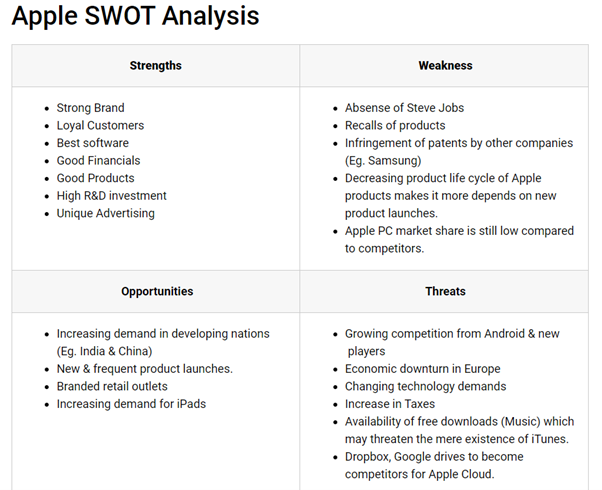
Swot analysis, for instance, enables you to identify your company’s advantages, such as its organizational strengths and talented workforce. Its dependence on limited raw materials and troubled supply chains is a drawback. For instance, while Amazon’s expansion threatens your company, it also gives you a chance to take advantage of the low loan rate environment.
VRIO Analysis
An excellent method for examining an organization’s internal environment is VRIO analysis. Here, you examine numerous internal resources of the business and classify each one according to how it benefits the business.
For instance, you should think about employing the VRIO analysis tool if you intend to develop a strategy to get a competitive edge.
McKinsey 7S Framework
A well-known technique for businesses planning to synchronize their departments and procedures is the McKinsey 7S framework. This framework can be used to calculate the difference between the present situation and the one that is being suggested for the future. It enables you to research seven internal company factors that you may use to help the business reach its objectives. The list is as follows:
● Staff
● Style
● Skill
● Shared values
● System
● Structure
● Strategy
Core Competency Analysis
The core competence analysis tool aids organizations in formulating a plan to obtain a competitive edge. It enables you to identify your core capabilities, such as abilities, expertise, and resources, which are bringing distinctive value to the consumers. Following that, you can create a strategy based on the major areas where your business excels and the products and services it provides to clients.
What distinguishes internal from external analyses?
The area of focus is what distinguishes internal analysis from external analysis. The focus of external analysis is on how external factors such in advantages of outside analysis
A corporation can gain a lot by doing an external analysis. Here are a few typical advantages:
1. Promotes expansion of businesses into new markets
External analyses help firms by motivating them to take initiative in how they run their businesses. For instance, a retail shop may opt to expand its business model to include the sale of free trade products if it notices a public trend toward free trade clothes.
2. Aids in preparing for and adjusting to change
Businesses can adapt to industry changes that might help them survive with the aid of external analysis. For instance, a catering business modifies how it stores its food goods to conform to new FDA guidelines. They can continue to operate as a catering service thanks to this.
3. Offers chances to beat out the competition
Businesses might find operational aspects they could change or enhance to differentiate themselves from rivals in their industry by doing an external analysis. A staffing solutions company, for instance, notes that they offer the same staffing solutions as their rivals: marketing, business management, and IT industry trends have an impact on a business and its success.
In course manual 2, these analytical tools will be covered in greater detail.

Chapter 3: Identify Stakeholders
A significant stakeholder is crucial in the business evaluation phase since they are crucial to a company’s long-term development. A company’s key stakeholders can aid in decision-making, risk management, and business expansion. Knowing who your main stakeholders are and how to identify them is crucial. In this course manual, we go through the definition of important stakeholders, how to spot them, and the advantages they might provide to your company as you perhaps gear up for acquisition expansion.
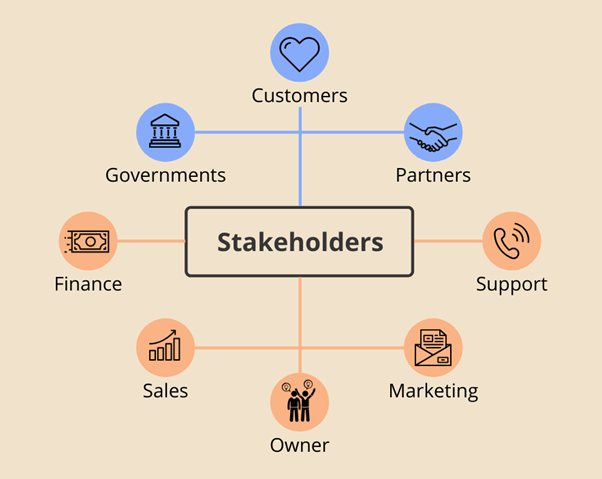
Who are a company’s major stakeholders?
The most important stakeholders in a specific firm are the primary stakeholders in a corporation. Any professional who is impacted by a company’s operations, initiatives, and successes is a stakeholder. The kind and degree of interest that stakeholders have in a company varies.
One of the most crucial stakeholders for a firm is a major stakeholder.
Since they are most impacted by a company’s operations, key stakeholders are keenly interested in its success. Similar to this, a company’s success and expansion frequently depend on its major stakeholders.
What functions do major stakeholders play in a company?
The function of a major stakeholder inside a company is dependent on a variety of variables. The duties of important parties may include:
• Providing financial support to your business
• Helping with business initiatives or assignments
• Asking for updates on your business’s current projects or recent developments
• Contributing during planning or company leadership meetings
The precise relationship a stakeholder has with your company is one of the important elements that defines whether or not they are a critical stakeholder. Customers, staff members, investors, managers, and other people with an interest in the success of your firm can all be stakeholders.
Participants in M&As and the Parts They Play
The M&A process demands that the proper people be in the right places at the right times, just like any significant production. Veteran deal makers are aware that involving the appropriate stakeholders at the right time can significantly affect the M&A process and perhaps even the deal’s final worth.
Determining who should do what and when can be a difficult task for small and medium organizations that don’t usually engage in merger and acquisition activities. But it’s important to get this step of the process perfect from the beginning. Fortunately, SMBs can benefit from deal makers’ prior expertise to better understand what to do and when.
It’s crucial to realize that no two negotiations are the same before we begin. There is no magic solution that can guarantee that your transaction will go through smoothly and according to schedule. The M&A process will be impacted by your sector, the economy as a whole, the type and complexity of the deal, and other factors. Although it is not a guarantee, putting the relevant stakeholders in the proper place can assist ensure your deal is completed smoothly.

Chapter 4: Core Competencies
A company’s competitive edge in the market is derived from its core capabilities, which set it apart from its rivals. Instead of physical or monetary assets, a company’s set of abilities or knowledge in a particular field is typically referred to as its core competency. The strategic strength of an organization is its core competency. Honda’s engine and propulsion systems, for instance, are a key strategic advantage. Sony’s primary area of expertise is miniaturization. The areas of logistics and customer support are fundamental competencies for Federal Express.
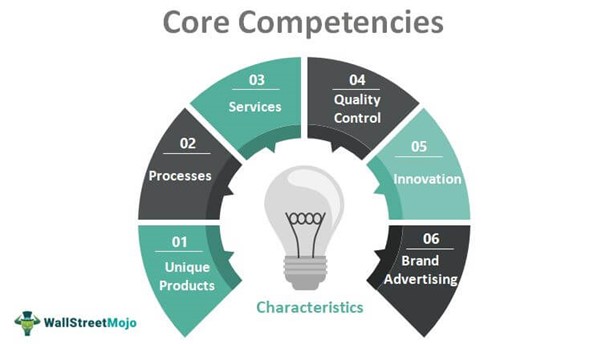
To identify a core skill, one can use the following three tests:
• A core competency can lead to the development of new products and services and must provide potential access to a wide variety of markets.
• It must make a significant contribution to the perceived benefits of the end product.
• It should be difficult for competitors to imitate. In many industries, such competencies are likely to be unique.
The management industry helped to develop the idea of core competencies. In “The Core Competence of the Corporation,” a 1990 Harvard Business Review article, C.K. Prahalad and Gary Hamel proposed the idea. A core competency is defined as “an area of specialized expertise that is the result of harmonizing complex streams of technology and work activity.” according to what they wrote. They used Honda as an illustration, pointing out how its skill in engines allowed it to create a number of highly appreciated items, including lawn mowers, snowblowers, and cars.
The long-term competitive advantage of your business is maintained in part by identifying and growing your core talents. Concentrating on your advantages can make your deficiencies more apparent and help you identify areas where a merger or acquisition could speed up your growth.
Determine the underlying knowledge, expertise, experience, technology, or method that enables your business to offer its distinct range of goods and services when defining the core competences of your organization. Analyze how your company’s key competencies can be used to build strategic responsiveness and create a competitive advantage. High-performing businesses improve their current core skills and create new ones to penetrate upcoming markets. When a business is operating at this level, it understands the requirements and desires of its clients in present and emerging markets and builds the skills required to satisfy those desires.
Apple’s process for creating products makes it special. With the iPod, Apple merged the features of MP3 players and jukebox software, which can both organize and store a huge number of music in an easy-to-use format. The iPod’s groundbreaking design and shift in customer expectations were largely attributed to its simplicity.
Leadership in the company should be mindful that even the most effective strategies will eventually fall short if they are not regularly reviewed and updated to reflect shifting market conditions.
Greater financial stability results from mergers and acquisitions for both participating businesses. A higher market share, more sway over consumers, and a lessened danger from competitors can all result from having more economic power. Larger businesses typically present more difficult competition.

Chapter 5: Market Differentiation
Trying to fit in with the crowd should be your last priority when conducting business. Your company has to stand out in a fiercely competitive market. Because of this, differentiation in business is essential for expansion.
Business differentiation definition
In essence, differentiation in business relates to the idea of distinguishing your business from the competitors by a particular feature, such your distribution system or pricing point. It offers your clients a higher level of value and aids in the market differentiation of your business. Any differentiation strategy’s primary goal is to boost your company’s competitive advantage as a result.
The value of differentiation in the corporate world
Differentiation is crucial to business success because it enables organizations to carve out distinctive niches in cutthroat markets or industries. It’s a common goal of business leaders to build organizations that mean everything to everyone, yet this is almost unattainable. Instead, developing a more concentrated path for your company can be quite advantageous and offer the following advantages:
• Compete without lowering prices – Differentiation strategies in business can give you a way to compete against other firms without getting into a price war. Whether you’re making a commitment to ethical business practices or focusing on high-quality products that are built to last, you’ll have a USP that other companies won’t that doesn’t simply involve lowering your prices until you’re dealing with unsustainable, razor-thin margins.
• Develop unique products – In addition, differentiation in business can help you build a unique product/service, even if there isn’t much to distinguish your products from your competitors. For example, bottled water companies (which largely produce the same product), can distinguish themselves from the competition and develop brand loyalists through differentiation strategies, such as focusing on a lower price-point, advertising the fact that the business is family owned, and so on.
• Increase customer loyalty – The importance of differentiation in business also extends to customer loyalty. By improving the perceived quality of your products, you can increase brand loyalty even at a higher price-point, which can help your business to prosper.

Chapter 6: Mission/Vision Statement
Successful Acquisitions Align With a Company’s Mission and Vision
The transaction itself does not mark the beginning and finish of a business purchase. Planning is the first step in creating a successful mergers and acquisitions (M&A) strategy, and planning should take place well before any conversations with possible targets. Additionally, the planning process must be exhaustive and entirely truthful.
Any planning done for the purpose of a potential purchase should be in line with your company’s strategic plan if one exists. If it doesn’t, you should either modify your strategic strategy accordingly, or if you are unable or unable to do so, you should reevaluate the acquisition concept altogether. Do your company’s mission and vision statements exist as well? If so, go back and check to see if they still appropriately reflect your growth goals. Create your purpose and vision statements right away if you don’t already have them. Let’s examine both.
Mission Statement
Your company’s mission statement outlines what it does and explains why it exists. You and your leadership team can decide whether a potential acquisition could further that larger goal and how that might happen by having a thorough understanding of it. The effects of such a purchase could be far-reaching—and typically detrimental—if it caused your business to stray from its goals.
Vision Statement
What you intend to be in the future as the acquiring firm must be reflected in your vision statement. It should concentrate on your company’s long-term goals. You won’t truly know what kind of acquisition is necessary (if any) without a vision statement.
You (the owner), your management team, and your advisors will have the necessary background information and resources to start reviewing target companies and assessing the degree to which they complement your company in relation to these statements once your company’s mission and vision statements have been developed or refined.
This leads to the creation of a Target Value Statement, the following step in the M&A strategy process.
You and your team will do some basic investigation once you’ve chosen a possible target firm. It’s alright. However, the value proposition of the target to your company (i.e., the acquirer) must be identified and articulated before due diligence is started, before the economics of a transaction are discussed internally or between the parties, and certainly before a letter of intent (LOI) is drafted (let alone signed).
You and your team must respond to a few fundamental inquiries, such as, but not limited to:
• What value will the transaction bring to your company?
• Will it expand your footprint?
• Will it help you sell new products to your existing customers/clients?
• Does the target company have a loyal base of its own existing customers/clients?
• To what extent would the acquisition open new channels or markets to your company—assuming such opportunities represent appropriate fits?
• How would you qualitatively characterize the target company’s culture? Do you envision a smooth transition post-acquisition, and how well do you really believe each company’s culture will mesh?
The target value statement is built on the responses to these and other crucial questions. You and your team must then ask the most crucial question after it has been finalized in writing (it might be a statement, a summary, a list of value points, or whatever format best suits your approach).
Does this value statement support the mission and vision statements of your business?
If so, greater thought should be given to the target company. If it doesn’t, you should end your investigation into that company and go on to find another acceptable target.
There are several reasons why businesses explore acquisitions. It makes sense to at least investigate a strategic or financial acquisition if it creates new growth opportunities or opens doors to potentially important customers/clients, especially given the current low cost of capital and the rapidly accelerating speed of technical innovation.
Your first order of business must be assessing prospects in relation to your company’s purpose and vision statements, regardless of the factors that may be important to you and your team. Does the objective match the target? Will it assist you in realizing your goals? You must respond to these queries right away. This is the starting point for all further inquiries, actions, and choices.

Chapter 7: Mapping Future State
When you’re trying to determine the business needs for a project or a product, or when you’re trying to sketch out a particular solution for your clients, future state process mapping is one of the most crucial activities you should be carrying out. And one of the causes.
Because it provides a visual depiction of what the future state of your customers’ environment will look like, future state process mapping is incredibly powerful. So, in essence, when you create a process map in this manner, what you’re telling your client is that in the future, you’ll have specific individuals or positions, as well as specific divisions, involved in particular types of that process.
Additionally, certain tasks must be completed in a particular order for their respective parts of the organization to function successfully. It also makes it extremely simple for them to decide once you’ve painted that kind of a picture for your customers, making choices based on their needs in terms of business.
For the requirements process, future state process mapping is crucial, which is why it should be done. Now, the majority of employers who employ business analysts may not necessarily understand the relationship between process mapping and requirements, and the majority of business analysts who engage in process mapping may not always be aware of the best way to translate their process maps into business requirements.

Chapter 8: Set Department Objectives
Setting OKR objectives must be done in a way that benefits your company. They’re not meant to be forced or overly complicated. Instead, by tying your teams to the main business objectives, employing OKRs is just a goal-setting process. Every organisation has different needs, thus each one will apply OKRs in a special and efficient way.
However, for OKRs to function properly, a few fundamental principles must be followed. Setting goals exclusively at the individual level will not promote the attainment of top-level objectives because they are meant to achieve company-wide alignment. Because of this, many executives believe that the best way to use OKRs is to first establish corporate objectives. This promotes alignment at all levels.
Setting team and department-level objectives.
Keep in mind that not every top business OKR needs to be reflected in every objective when developing goals for your team or department. However, team and department OKRs should in some way, shape, or form contribute to the primary corporate objectives. During the business assessment stage of acquisitive expansion, team leaders should get together to discuss goals before starting to set departmental OKRs. Keep in mind the major business priorities and enquire:
● Are the team or departmental objectives somehow connected with our top company goals?
● Do the team or departmental OKRs make it more likely that the company will achieve its overarching goals?
● Are there more than 3-5 objectives listed here?
OKRs should not simply list all of the tasks that teams will do during the quarter since they are not meant to serve as a checklist. Teams will be forced to concentrate on tasks rather than what the firm wants to accomplish if OKRs are approached as a to-do list. Instead, let the team’s desired outcome be guided by the objectives. The best way to achieve the goals can then be decided by the teams themselves.
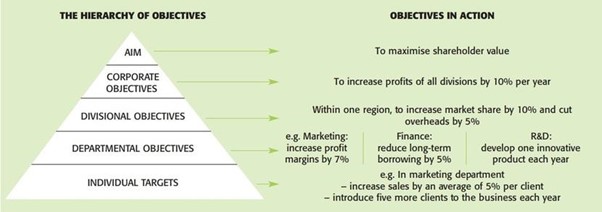
Examples of team and departmental objectives.
Here are just a few team or departmental objectives for reference:
● Marketing: Launch the new monthly newsletter successfully
● Sales: Grow our sales in the Central region
● HR: Improve employee retention
● Engineering: Build a world-class engineering team
● Operations: Improve our IT and infrastructure
Remember that the goals listed here, like with all OKRs, should be complemented with important outcomes that adhere to SMART goal-setting standards.
Setting particular departmental goals will help you concentrate on areas that may have been neglected in the past but are essential for business expansion. If you find that you lack the manpower or resources to accomplish these goals organically, an acquisition or merger could fill the gaps and promote long-term growth.

Chapter 9: Prioritizing Tasks
Six steps to help you get organized instead of overwhelmed
When conducting your business evaluation, it might be helpful to divide large tasks into smaller, more manageable components. You may stay away from tension and procrastination by doing this. When they wait until the very last minute, those who procrastinate frequently complain that they feel overwhelmed and the task appears impossible. The work is more doable and less scary when priorities are established and the larger project is divided into smaller tasks.
Here are six suggestions for segmenting tasks:
1. Look at the big picture. Make sure you understand what the end product is supposed to look like.
2. Examine the parts of the task. Figure out step-by-step what you need to do because it’s not going to happen through magic.
3. Think about the logical order of completing the pieces. What should you do first, second, third, etc.?
4. Create a timeline for completing your tasks. Having a deadline will make you more focused for each task.
5. Have a plan to help you stay on track. Put the time you will spend on the project into your schedule so that you can set aside the time for it. Stick with this plan. A plan is only good if you see it through.
6. Complete your task early enough to have some time left for a final review.
Professionals must break down projects into discrete tasks in order to fulfill deadlines because they frequently work on multiple projects each day. When doing an internal business review, dividing down duties will assure efficiency and help you get to the point where you can decide whether acquiring new businesses will be advantageous for your company. In this course manual, we explain why it’s crucial to break projects down into tasks, demonstrate how to do it in five steps, and offer you some advice on how to accomplish it.
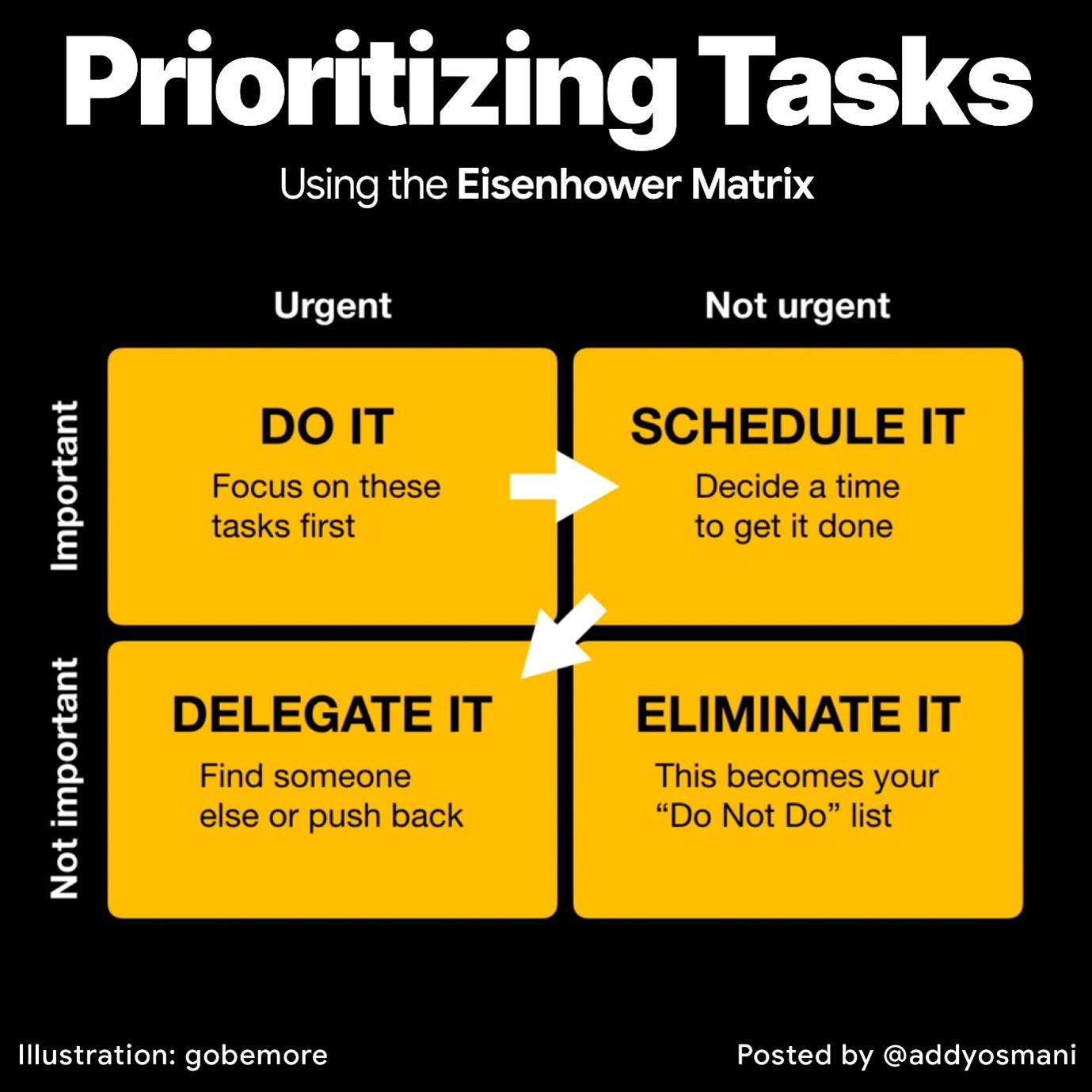
Why is it crucial to divide projects into separate tasks?
It may be beneficial to break your project into tasks depending on its size and complexity. Other advantages are that it:
Generates a prioritized workflow
The workflow of your jobs should be prioritized if you want to finish a project as soon as possible. The efficiency of a project can be improved at each stage of the process by identifying its major components. For instance, doing things that are more important first may give you more time to review and make changes before deciding what to do.
Promotes better performance
By breaking projects down into smaller jobs, professionals can avoid getting tired and keep motivated. A business assessment can be completed more quickly and successfully if you break up the work into manageable chunks. This will allow you to take breaks and unwind as you go.
Helps team collaboration
Allocating each assignment to a different team member or colleague can help professionals fulfill deadlines more successfully when working on a huge project, such as an internal assessment. A team leader might, for instance, designate a teammate to a particular project phase where they may have more expertise than another team member. This can assure good quality while enabling each team member to use their skills to the fullest.

Chapter 10: Set KPIs
Effective KPIs are crucial measures to use to make sure you can achieve any business goal. To improve corporate performance, the value of effective KPIs cannot be overstated.
The most frequent error businesses make when beginning to measure their KPIs is attempting to measure too much. The issue with this strategy is that you can’t tell whether you’re making progress if you don’t know which KPI to assess. You can never determine if you’re successful or failing if you don’t know what you’re attempting to accomplish.
KPIs are more than just the numbers and measurements you share on a weekly basis; they give you insight into the performance and overall health of your company, allowing you to make crucial changes to your execution in order to meet your strategic objectives. You can get outcomes more quickly and determine which areas of your business will benefit from an acquisition or merger by knowing and measuring the proper KPIs. A key performance indicator is a quantifiable number that shows how well a business is doing in relation to its major business objectives, quarterly goals, and business objectives, as well as the development of your 3-5 year plan for acquisition-led growth.
The Importance of KPIs
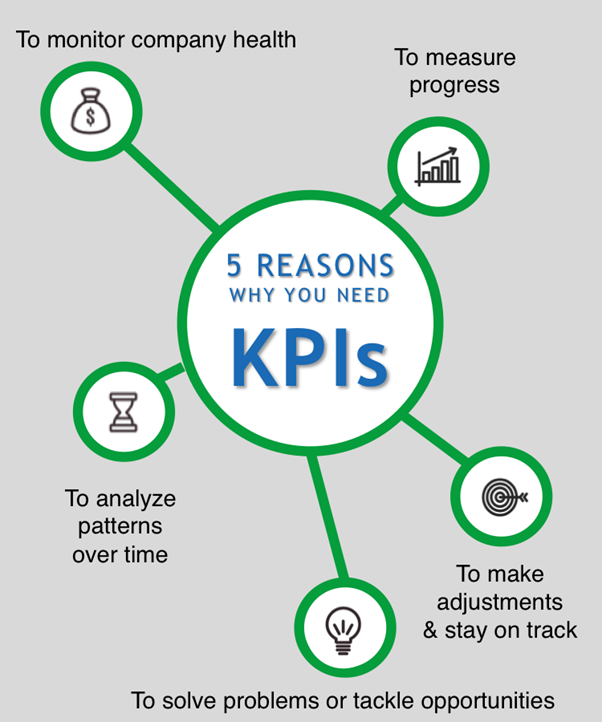
KPIs to Monitor Company Health
KPIs serve as an indicator of a company’s health. To monitor the vital indicators of your business, you only need a small number of KPIs. Only measure the things you wish to alter so you can direct your energy in the right directions. We’ve discovered that it’s crucial to track a few KPIs for each of the four areas of revenue, processes, customers, and employees. These are covered by the business strategy, customer satisfaction, business processes, and human resources disciplines. Make sure you select the appropriate KPIs for your company before worrying about who will be responsible for them (leadership accountability.)
KPIs to Measure Progress Over Time
An organization’s key performance indicator (KPI) is any measurable outcome that shows whether it is accomplishing its goals. It could be anything, including revenue, gross margin, the number of sites and staff, customer satisfaction, the calibre of the product, employee productivity, and more. Each quarter, you establish these KPIs for your team and yourself so that you can assess your progress. After then, you keep tabs on them once a week to check if they’re heading in the right way. If not, change your course of action accordingly, and let other departments know if you veer off course.
KPIs to Make Adjustments and Stay on Track
You should track your leading indicator KPIs in addition to your present performance to determine how near you are to attaining your objectives. You can determine whether you are on pace to achieve your goals using these measurements. Then, you can modify your plan as necessary. For instance, you can opt to prioritise marketing initiatives over product development if you see a decline in sales. Leading indicators have the ability to be measured and are subject to direct control. They are useful KPIs to have on your dashboard to maintain the progress of your projects.
KPIs to Solve Problems or Tackle Opportunities
Utilize a dashboard that combines KPIs so that you have the necessary data at hand to address issues or seize opportunities. Say your sales are suffering. Choose a few KPIs that can assist you change the situation (perhaps the number of outgoing calls, appointments kept, or trade shows attended). Put them on a dashboard and keep an eye on them each week to see whether you’ve discovered the appropriate lever to increase your sales predictability. Or, let’s say you have a fantastic concept for a brand-new item. Before launching it on a big scale, you may test it out with a small number of clients and use KPIs to validate your business model. You might track the number of interested consumers, funding for the new product, NPS score, implementation time, number of defects, etc.
KPIs to Analyze Patterns Over Time
You can start to see trends in your data if you measure the same KPIs from quarter to quarter. These patterns can benefit your business in a plethora of ways. Perhaps you can anticipate when business will be slow and use that period to implement a system update or company-wide training programme. Perhaps it is obvious to you that your sales manager consistently predicts that you will close 5 deals either above or below where you typically do at the end of the quarter. If you can identify team members who consistently perform below or above average on their KPIs, you may utilise this information to discuss any negative or positive repercussions.
The balanced scorecard is followed by a variety of KPIs on an effective KPI dashboard. To track your company’s progress toward its crucial goals and objectives, you must make sure that you are covering all the vital parts of your organisation. Since each of the following categories has at least two KPIs (including one leading indicator KPI), the top companies always have them:
● Financial Perspective
– Net Profit
– Net Profit Margin
– Revenue
● Internal Business Perspective (Operational KPIs)
– Revenue Per Employee
– Capacity Utilization
● Customer Perspective
– NPS (Net Promoter Score)
– Repeat Customers
● Employee Perspective
– Employee NPS
– Turnover Rate

Chapter 11: Create a Project Schedule
When deadlines and objectives are clearly in your line of sight, it is harder to forget about them. Your project tasks are mapped on a timetable by project schedules, so you always know what follows next. We’ll go over the seven phases to making a project schedule in this course manual and provide some templates to help you get started.
At work, a possible M&A project frequently heralds the start of a new journey replete with participants, deadlines, deliverables, and tools. However, you’ll need a project plan to get you there whether your project is a new product launch, a vendor event, the annual editorial calendar, or even employee onboarding.
To keep your team on track, understand who is responsible for what by when, and see how everything fits together, you must have the authority to design a project calendar with precise plans, procedures, and responsibilities. A well-written project schedule will improve efficiency, accountability, and clarity even though it could take some time initially. And everyone loves hearing those three words. Additionally, you’ll be able to reduce the use of tools that are meant to make project management easier but really make it tougher.
What is a project schedule?
A project schedule gives you a broad overview of your project, outlining the timetable, tasks, dependencies, and team members that will be working on it. In essence, a project schedule ought to be able to inform you of all the information you require about your project at a look. You can track project progress in real-time and make sure you’re on the right track for success by describing all the major components and high-level specifics of your project.
Connecting the dots of your project schedule
A work breakdown structure (WBS) is frequently used by project managers to give the project schedule life. Work breakdown frameworks make it easier to organise and distribute work among team members. The WBS is a visual structure of your task list that shows the dependencies between each task so you can see how they relate to one another. The parent task will be at the top level, followed by dependent tasks at the following level, and so forth.

Chapter 12: Monitor Data Over Time
The Importance of Business Monitoring and Reporting
Many businesses must maintain consistent business reporting and monitoring since the board may insist on seeing weekly, monthly, quarterly, or annual reports to understand how the company is doing. Business monitoring and reporting can save time and money in a variety of business sectors, including eCommerce and the service sector. In the long run, these reviews can also improve your processes.
Management Insight
Business reports compile a lot of data about your organisation, which can give managers vital data. There will also be insights on growth, spending, and earnings that may be used to make budgets, marketing strategies, and projections for the future.
Business reports will also be used by management to monitor expansion and the development of the company, spot patterns, and pinpoint any abnormalities that may need further investigation. If you have a complete and trustworthy set of data about your company, you may routinely consult it and provide it to possible investors, for instance.
Identify Problems
Regular reporting and monitoring should assist you identify any potential problems in your company before they have a chance to get worse. If your firm simply generates an annual report, then issues and anomalies may be easily overlooked and may be costing your company money and time without your knowing. Monitoring a problematic location and comparing data gathered over time should help identify any causes or the origins of any problems. This can then be utilised to offer a fix or suggest methods to improve, such as buying a company that has expertise effectively resolving the problems you’ve found challenging to resolve naturally.
Highlight Opportunities
Monitoring and reporting over time might spot potential expansion chances in addition to revealing issues inside the company. Reports are a useful tool for keeping track of previous activity and instances where expansion has been successful. These can be used to identify potential areas for future growth, as well as what has already worked effectively and what needs to be improved. Regularly observing and analysing competitors might also help with this.
Transparency
Many publicly traded firms are required by law to submit an annual report in order to disclose financial information and ownership details to stockholders, the government, and other parties. More frequent reporting can provide more openness throughout the year, potentially improving the company’s appeal to investors. It makes it simple to compare companies operating in the same industry and compare their performance to one another.
Set Goals
Reporting on business performance makes it possible to compare performance over various time periods. The reporting goals should be in line with the KPIs because these can show if the reporting goals have been fulfilled, surpassed, or not. Whatever the outcomes, recognising performance trends and the state of the business can subsequently be utilised to define new objectives. This could be for making broad decisions about budgets or coming up with future strategies for acquisitive expansion.
Monitor Partners
In addition to your own company, it’s critical to track and evaluate the performance of any business partners you rely on to make sure they’re making the most use of your time and money. To give customers responsibility and transparency, online retailers and eCommerce companies frequently use parcel tracking systems. However, businesses can also employ parcel monitoring to evaluate and review the performance of their delivery partners.
Curriculum
Acquisitive Growth – Workshop 1 – Business Assessment
- Current State
- Analysis Tools
- Identify Stakeholders
- Core Competencies
- Market Differentiation
- Mission/Vision Statement
- Mapping Future State
- Set Department Objectives
- Prioritizing Tasks
- Set KPIs
- Create a Project Schedule
- Monitor Data over Time
Distance Learning
Introduction
Welcome to Appleton Greene and thank you for enrolling on the Acquisitive Growth corporate training program. You will be learning through our unique facilitation via distance-learning method, which will enable you to practically implement everything that you learn academically. The methods and materials used in your program have been designed and developed to ensure that you derive the maximum benefits and enjoyment possible. We hope that you find the program challenging and fun to do. However, if you have never been a distance-learner before, you may be experiencing some trepidation at the task before you. So we will get you started by giving you some basic information and guidance on how you can make the best use of the modules, how you should manage the materials and what you should be doing as you work through them. This guide is designed to point you in the right direction and help you to become an effective distance-learner. Take a few hours or so to study this guide and your guide to tutorial support for students, while making notes, before you start to study in earnest.
Study environment
You will need to locate a quiet and private place to study, preferably a room where you can easily be isolated from external disturbances or distractions. Make sure the room is well-lit and incorporates a relaxed, pleasant feel. If you can spoil yourself within your study environment, you will have much more of a chance to ensure that you are always in the right frame of mind when you do devote time to study. For example, a nice fire, the ability to play soft soothing background music, soft but effective lighting, perhaps a nice view if possible and a good size desk with a comfortable chair. Make sure that your family know when you are studying and understand your study rules. Your study environment is very important. The ideal situation, if at all possible, is to have a separate study, which can be devoted to you. If this is not possible then you will need to pay a lot more attention to developing and managing your study schedule, because it will affect other people as well as yourself. The better your study environment, the more productive you will be.
Study tools & rules
Try and make sure that your study tools are sufficient and in good working order. You will need to have access to a computer, scanner and printer, with access to the internet. You will need a very comfortable chair, which supports your lower back, and you will need a good filing system. It can be very frustrating if you are spending valuable study time trying to fix study tools that are unreliable, or unsuitable for the task. Make sure that your study tools are up to date. You will also need to consider some study rules. Some of these rules will apply to you and will be intended to help you to be more disciplined about when and how you study. This distance-learning guide will help you and after you have read it you can put some thought into what your study rules should be. You will also need to negotiate some study rules for your family, friends or anyone who lives with you. They too will need to be disciplined in order to ensure that they can support you while you study. It is important to ensure that your family and friends are an integral part of your study team. Having their support and encouragement can prove to be a crucial contribution to your successful completion of the program. Involve them in as much as you can.
Successful distance-learning
Distance-learners are freed from the necessity of attending regular classes or workshops, since they can study in their own way, at their own pace and for their own purposes. But unlike traditional internal training courses, it is the student’s responsibility, with a distance-learning program, to ensure that they manage their own study contribution. This requires strong self-discipline and self-motivation skills and there must be a clear will to succeed. Those students who are used to managing themselves, are good at managing others and who enjoy working in isolation, are more likely to be good distance-learners. It is also important to be aware of the main reasons why you are studying and of the main objectives that you are hoping to achieve as a result. You will need to remind yourself of these objectives at times when you need to motivate yourself. Never lose sight of your long-term goals and your short-term objectives. There is nobody available here to pamper you, or to look after you, or to spoon-feed you with information, so you will need to find ways to encourage and appreciate yourself while you are studying. Make sure that you chart your study progress, so that you can be sure of your achievements and re-evaluate your goals and objectives regularly.
Self-assessment
Appleton Greene training programs are in all cases post-graduate programs. Consequently, you should already have obtained a business-related degree and be an experienced learner. You should therefore already be aware of your study strengths and weaknesses. For example, which time of the day are you at your most productive? Are you a lark or an owl? What study methods do you respond to the most? Are you a consistent learner? How do you discipline yourself? How do you ensure that you enjoy yourself while studying? It is important to understand yourself as a learner and so some self-assessment early on will be necessary if you are to apply yourself correctly. Perform a SWOT analysis on yourself as a student. List your internal strengths and weaknesses as a student and your external opportunities and threats. This will help you later on when you are creating a study plan. You can then incorporate features within your study plan that can ensure that you are playing to your strengths, while compensating for your weaknesses. You can also ensure that you make the most of your opportunities, while avoiding the potential threats to your success.
Accepting responsibility as a student
Training programs invariably require a significant investment, both in terms of what they cost and in the time that you need to contribute to study and the responsibility for successful completion of training programs rests entirely with the student. This is never more apparent than when a student is learning via distance-learning. Accepting responsibility as a student is an important step towards ensuring that you can successfully complete your training program. It is easy to instantly blame other people or factors when things go wrong. But the fact of the matter is that if a failure is your failure, then you have the power to do something about it, it is entirely in your own hands. If it is always someone else’s failure, then you are powerless to do anything about it. All students study in entirely different ways, this is because we are all individuals and what is right for one student, is not necessarily right for another. In order to succeed, you will have to accept personal responsibility for finding a way to plan, implement and manage a personal study plan that works for you. If you do not succeed, you only have yourself to blame.
Planning
By far the most critical contribution to stress, is the feeling of not being in control. In the absence of planning we tend to be reactive and can stumble from pillar to post in the hope that things will turn out fine in the end. Invariably they don’t! In order to be in control, we need to have firm ideas about how and when we want to do things. We also need to consider as many possible eventualities as we can, so that we are prepared for them when they happen. Prescriptive Change, is far easier to manage and control, than Emergent Change. The same is true with distance-learning. It is much easier and much more enjoyable, if you feel that you are in control and that things are going to plan. Even when things do go wrong, you are prepared for them and can act accordingly without any unnecessary stress. It is important therefore that you do take time to plan your studies properly.
Management
Once you have developed a clear study plan, it is of equal importance to ensure that you manage the implementation of it. Most of us usually enjoy planning, but it is usually during implementation when things go wrong. Targets are not met and we do not understand why. Sometimes we do not even know if targets are being met. It is not enough for us to conclude that the study plan just failed. If it is failing, you will need to understand what you can do about it. Similarly if your study plan is succeeding, it is still important to understand why, so that you can improve upon your success. You therefore need to have guidelines for self-assessment so that you can be consistent with performance improvement throughout the program. If you manage things correctly, then your performance should constantly improve throughout the program.
Study objectives & tasks
The first place to start is developing your program objectives. These should feature your reasons for undertaking the training program in order of priority. Keep them succinct and to the point in order to avoid confusion. Do not just write the first things that come into your head because they are likely to be too similar to each other. Make a list of possible departmental headings, such as: Customer Service; E-business; Finance; Globalization; Human Resources; Technology; Legal; Management; Marketing and Production. Then brainstorm for ideas by listing as many things that you want to achieve under each heading and later re-arrange these things in order of priority. Finally, select the top item from each department heading and choose these as your program objectives. Try and restrict yourself to five because it will enable you to focus clearly. It is likely that the other things that you listed will be achieved if each of the top objectives are achieved. If this does not prove to be the case, then simply work through the process again.
Study forecast
As a guide, the Appleton Greene Acquisitive Growth corporate training program should take 12-18 months to complete, depending upon your availability and current commitments. The reason why there is such a variance in time estimates is because every student is an individual, with differing productivity levels and different commitments. These differentiations are then exaggerated by the fact that this is a distance-learning program, which incorporates the practical integration of academic theory as an as a part of the training program. Consequently all of the project studies are real, which means that important decisions and compromises need to be made. You will want to get things right and will need to be patient with your expectations in order to ensure that they are. We would always recommend that you are prudent with your own task and time forecasts, but you still need to develop them and have a clear indication of what are realistic expectations in your case. With reference to your time planning: consider the time that you can realistically dedicate towards study with the program every week; calculate how long it should take you to complete the program, using the guidelines featured here; then break the program down into logical modules and allocate a suitable proportion of time to each of them, these will be your milestones; you can create a time plan by using a spreadsheet on your computer, or a personal organizer such as MS Outlook, you could also use a financial forecasting software; break your time forecasts down into manageable chunks of time, the more specific you can be, the more productive and accurate your time management will be; finally, use formulas where possible to do your time calculations for you, because this will help later on when your forecasts need to change in line with actual performance. With reference to your task planning: refer to your list of tasks that need to be undertaken in order to achieve your program objectives; with reference to your time plan, calculate when each task should be implemented; remember that you are not estimating when your objectives will be achieved, but when you will need to focus upon implementing the corresponding tasks; you also need to ensure that each task is implemented in conjunction with the associated training modules which are relevant; then break each single task down into a list of specific to do’s, say approximately ten to do’s for each task and enter these into your study plan; once again you could use MS Outlook to incorporate both your time and task planning and this could constitute your study plan; you could also use a project management software like MS Project. You should now have a clear and realistic forecast detailing when you can expect to be able to do something about undertaking the tasks to achieve your program objectives.
Performance management
It is one thing to develop your study forecast, it is quite another to monitor your progress. Ultimately it is less important whether you achieve your original study forecast and more important that you update it so that it constantly remains realistic in line with your performance. As you begin to work through the program, you will begin to have more of an idea about your own personal performance and productivity levels as a distance-learner. Once you have completed your first study module, you should re-evaluate your study forecast for both time and tasks, so that they reflect your actual performance level achieved. In order to achieve this you must first time yourself while training by using an alarm clock. Set the alarm for hourly intervals and make a note of how far you have come within that time. You can then make a note of your actual performance on your study plan and then compare your performance against your forecast. Then consider the reasons that have contributed towards your performance level, whether they are positive or negative and make a considered adjustment to your future forecasts as a result. Given time, you should start achieving your forecasts regularly.
With reference to time management: time yourself while you are studying and make a note of the actual time taken in your study plan; consider your successes with time-efficiency and the reasons for the success in each case and take this into consideration when reviewing future time planning; consider your failures with time-efficiency and the reasons for the failures in each case and take this into consideration when reviewing future time planning; re-evaluate your study forecast in relation to time planning for the remainder of your training program to ensure that you continue to be realistic about your time expectations. You need to be consistent with your time management, otherwise you will never complete your studies. This will either be because you are not contributing enough time to your studies, or you will become less efficient with the time that you do allocate to your studies. Remember, if you are not in control of your studies, they can just become yet another cause of stress for you.
With reference to your task management: time yourself while you are studying and make a note of the actual tasks that you have undertaken in your study plan; consider your successes with task-efficiency and the reasons for the success in each case; take this into consideration when reviewing future task planning; consider your failures with task-efficiency and the reasons for the failures in each case and take this into consideration when reviewing future task planning; re-evaluate your study forecast in relation to task planning for the remainder of your training program to ensure that you continue to be realistic about your task expectations. You need to be consistent with your task management, otherwise you will never know whether you are achieving your program objectives or not.
Keeping in touch
You will have access to qualified and experienced professors and tutors who are responsible for providing tutorial support for your particular training program. So don’t be shy about letting them know how you are getting on. We keep electronic records of all tutorial support emails so that professors and tutors can review previous correspondence before considering an individual response. It also means that there is a record of all communications between you and your professors and tutors and this helps to avoid any unnecessary duplication, misunderstanding, or misinterpretation. If you have a problem relating to the program, share it with them via email. It is likely that they have come across the same problem before and are usually able to make helpful suggestions and steer you in the right direction. To learn more about when and how to use tutorial support, please refer to the Tutorial Support section of this student information guide. This will help you to ensure that you are making the most of tutorial support that is available to you and will ultimately contribute towards your success and enjoyment with your training program.
Work colleagues and family
You should certainly discuss your program study progress with your colleagues, friends and your family. Appleton Greene training programs are very practical. They require you to seek information from other people, to plan, develop and implement processes with other people and to achieve feedback from other people in relation to viability and productivity. You will therefore have plenty of opportunities to test your ideas and enlist the views of others. People tend to be sympathetic towards distance-learners, so don’t bottle it all up in yourself. Get out there and share it! It is also likely that your family and colleagues are going to benefit from your labors with the program, so they are likely to be much more interested in being involved than you might think. Be bold about delegating work to those who might benefit themselves. This is a great way to achieve understanding and commitment from people who you may later rely upon for process implementation. Share your experiences with your friends and family.
Making it relevant
The key to successful learning is to make it relevant to your own individual circumstances. At all times you should be trying to make bridges between the content of the program and your own situation. Whether you achieve this through quiet reflection or through interactive discussion with your colleagues, client partners or your family, remember that it is the most important and rewarding aspect of translating your studies into real self-improvement. You should be clear about how you want the program to benefit you. This involves setting clear study objectives in relation to the content of the course in terms of understanding, concepts, completing research or reviewing activities and relating the content of the modules to your own situation. Your objectives may understandably change as you work through the program, in which case you should enter the revised objectives on your study plan so that you have a permanent reminder of what you are trying to achieve, when and why.
Distance-learning check-list
Prepare your study environment, your study tools and rules.
Undertake detailed self-assessment in terms of your ability as a learner.
Create a format for your study plan.
Consider your study objectives and tasks.
Create a study forecast.
Assess your study performance.
Re-evaluate your study forecast.
Be consistent when managing your study plan.
Use your Appleton Greene Certified Learning Provider (CLP) for tutorial support.
Make sure you keep in touch with those around you.

Tutorial Support
Programs
Appleton Greene uses standard and bespoke corporate training programs as vessels to transfer business process improvement knowledge into the heart of our clients’ organizations. Each individual program focuses upon the implementation of a specific business process, which enables clients to easily quantify their return on investment. There are hundreds of established Appleton Greene corporate training products now available to clients within customer services, e-business, finance, globalization, human resources, information technology, legal, management, marketing and production. It does not matter whether a client’s employees are located within one office, or an unlimited number of international offices, we can still bring them together to learn and implement specific business processes collectively. Our approach to global localization enables us to provide clients with a truly international service with that all important personal touch. Appleton Greene corporate training programs can be provided virtually or locally and they are all unique in that they individually focus upon a specific business function. They are implemented over a sustainable period of time and professional support is consistently provided by qualified learning providers and specialist consultants.
Support available
You will have a designated Certified Learning Provider (CLP) and an Accredited Consultant and we encourage you to communicate with them as much as possible. In all cases tutorial support is provided online because we can then keep a record of all communications to ensure that tutorial support remains consistent. You would also be forwarding your work to the tutorial support unit for evaluation and assessment. You will receive individual feedback on all of the work that you undertake on a one-to-one basis, together with specific recommendations for anything that may need to be changed in order to achieve a pass with merit or a pass with distinction and you then have as many opportunities as you may need to re-submit project studies until they meet with the required standard. Consequently the only reason that you should really fail (CLP) is if you do not do the work. It makes no difference to us whether a student takes 12 months or 18 months to complete the program, what matters is that in all cases the same quality standard will have been achieved.
Support Process
Please forward all of your future emails to the designated (CLP) Tutorial Support Unit email address that has been provided and please do not duplicate or copy your emails to other AGC email accounts as this will just cause unnecessary administration. Please note that emails are always answered as quickly as possible but you will need to allow a period of up to 20 business days for responses to general tutorial support emails during busy periods, because emails are answered strictly within the order in which they are received. You will also need to allow a period of up to 30 business days for the evaluation and assessment of project studies. This does not include weekends or public holidays. Please therefore kindly allow for this within your time planning. All communications are managed online via email because it enables tutorial service support managers to review other communications which have been received before responding and it ensures that there is a copy of all communications retained on file for future reference. All communications will be stored within your personal (CLP) study file here at Appleton Greene throughout your designated study period. If you need any assistance or clarification at any time, please do not hesitate to contact us by forwarding an email and remember that we are here to help. If you have any questions, please list and number your questions succinctly and you can then be sure of receiving specific answers to each and every query.
Time Management
It takes approximately 1 Year to complete the Acquisitive Growth corporate training program, incorporating 12 x 6-hour monthly workshops. Each student will also need to contribute approximately 4 hours per week over 1 Year of their personal time. Students can study from home or work at their own pace and are responsible for managing their own study plan. There are no formal examinations and students are evaluated and assessed based upon their project study submissions, together with the quality of their internal analysis and supporting documents. They can contribute more time towards study when they have the time to do so and can contribute less time when they are busy. All students tend to be in full time employment while studying and the Acquisitive Growth program is purposely designed to accommodate this, so there is plenty of flexibility in terms of time management. It makes no difference to us at Appleton Greene, whether individuals take 12-18 months to complete this program. What matters is that in all cases the same standard of quality will have been achieved with the standard and bespoke programs that have been developed.
Distance Learning Guide
The distance learning guide should be your first port of call when starting your training program. It will help you when you are planning how and when to study, how to create the right environment and how to establish the right frame of mind. If you can lay the foundations properly during the planning stage, then it will contribute to your enjoyment and productivity while training later. The guide helps to change your lifestyle in order to accommodate time for study and to cultivate good study habits. It helps you to chart your progress so that you can measure your performance and achieve your goals. It explains the tools that you will need for study and how to make them work. It also explains how to translate academic theory into practical reality. Spend some time now working through your distance learning guide and make sure that you have firm foundations in place so that you can make the most of your distance learning program. There is no requirement for you to attend training workshops or classes at Appleton Greene offices. The entire program is undertaken online, program course manuals and project studies are administered via the Appleton Greene web site and via email, so you are able to study at your own pace and in the comfort of your own home or office as long as you have a computer and access to the internet.
How To Study
The how to study guide provides students with a clear understanding of the Appleton Greene facilitation via distance learning training methods and enables students to obtain a clear overview of the training program content. It enables students to understand the step-by-step training methods used by Appleton Greene and how course manuals are integrated with project studies. It explains the research and development that is required and the need to provide evidence and references to support your statements. It also enables students to understand precisely what will be required of them in order to achieve a pass with merit and a pass with distinction for individual project studies and provides useful guidance on how to be innovative and creative when developing your Unique Program Proposition (UPP).
Tutorial Support
Tutorial support for the Appleton Greene Acquisitive Growth corporate training program is provided online either through the Appleton Greene Client Support Portal (CSP), or via email. All tutorial support requests are facilitated by a designated Program Administration Manager (PAM). They are responsible for deciding which professor or tutor is the most appropriate option relating to the support required and then the tutorial support request is forwarded onto them. Once the professor or tutor has completed the tutorial support request and answered any questions that have been asked, this communication is then returned to the student via email by the designated Program Administration Manager (PAM). This enables all tutorial support, between students, professors and tutors, to be facilitated by the designated Program Administration Manager (PAM) efficiently and securely through the email account. You will therefore need to allow a period of up to 20 business days for responses to general support queries and up to 30 business days for the evaluation and assessment of project studies, because all tutorial support requests are answered strictly within the order in which they are received. This does not include weekends or public holidays. Consequently you need to put some thought into the management of your tutorial support procedure in order to ensure that your study plan is feasible and to obtain the maximum possible benefit from tutorial support during your period of study. Please retain copies of your tutorial support emails for future reference. Please ensure that ALL of your tutorial support emails are set out using the format as suggested within your guide to tutorial support. Your tutorial support emails need to be referenced clearly to the specific part of the course manual or project study which you are working on at any given time. You also need to list and number any questions that you would like to ask, up to a maximum of five questions within each tutorial support email. Remember the more specific you can be with your questions the more specific your answers will be too and this will help you to avoid any unnecessary misunderstanding, misinterpretation, or duplication. The guide to tutorial support is intended to help you to understand how and when to use support in order to ensure that you get the most out of your training program. Appleton Greene training programs are designed to enable you to do things for yourself. They provide you with a structure or a framework and we use tutorial support to facilitate students while they practically implement what they learn. In other words, we are enabling students to do things for themselves. The benefits of distance learning via facilitation are considerable and are much more sustainable in the long-term than traditional short-term knowledge sharing programs. Consequently you should learn how and when to use tutorial support so that you can maximize the benefits from your learning experience with Appleton Greene. This guide describes the purpose of each training function and how to use them and how to use tutorial support in relation to each aspect of the training program. It also provides useful tips and guidance with regard to best practice.
Tutorial Support Tips
Students are often unsure about how and when to use tutorial support with Appleton Greene. This Tip List will help you to understand more about how to achieve the most from using tutorial support. Refer to it regularly to ensure that you are continuing to use the service properly. Tutorial support is critical to the success of your training experience, but it is important to understand when and how to use it in order to maximize the benefit that you receive. It is no coincidence that those students who succeed are those that learn how to be positive, proactive and productive when using tutorial support.
Be positive and friendly with your tutorial support emails
Remember that if you forward an email to the tutorial support unit, you are dealing with real people. “Do unto others as you would expect others to do unto you”. If you are positive, complimentary and generally friendly in your emails, you will generate a similar response in return. This will be more enjoyable, productive and rewarding for you in the long-term.
Think about the impression that you want to create
Every time that you communicate, you create an impression, which can be either positive or negative, so put some thought into the impression that you want to create. Remember that copies of all tutorial support emails are stored electronically and tutors will always refer to prior correspondence before responding to any current emails. Over a period of time, a general opinion will be arrived at in relation to your character, attitude and ability. Try to manage your own frustrations, mood swings and temperament professionally, without involving the tutorial support team. Demonstrating frustration or a lack of patience is a weakness and will be interpreted as such. The good thing about communicating in writing, is that you will have the time to consider your content carefully, you can review it and proof-read it before sending your email to Appleton Greene and this should help you to communicate more professionally, consistently and to avoid any unnecessary knee-jerk reactions to individual situations as and when they may arise. Please also remember that the CLP Tutorial Support Unit will not just be responsible for evaluating and assessing the quality of your work, they will also be responsible for providing recommendations to other learning providers and to client contacts within the Appleton Greene global client network, so do be in control of your own emotions and try to create a good impression.
Remember that quality is preferred to quantity
Please remember that when you send an email to the tutorial support team, you are not using Twitter or Text Messaging. Try not to forward an email every time that you have a thought. This will not prove to be productive either for you or for the tutorial support team. Take time to prepare your communications properly, as if you were writing a professional letter to a business colleague and make a list of queries that you are likely to have and then incorporate them within one email, say once every month, so that the tutorial support team can understand more about context, application and your methodology for study. Get yourself into a consistent routine with your tutorial support requests and use the tutorial support template provided with ALL of your emails. The (CLP) Tutorial Support Unit will not spoon-feed you with information. They need to be able to evaluate and assess your tutorial support requests carefully and professionally.
Be specific about your questions in order to receive specific answers
Try not to write essays by thinking as you are writing tutorial support emails. The tutorial support unit can be unclear about what in fact you are asking, or what you are looking to achieve. Be specific about asking questions that you want answers to. Number your questions. You will then receive specific answers to each and every question. This is the main purpose of tutorial support via email.
Keep a record of your tutorial support emails
It is important that you keep a record of all tutorial support emails that are forwarded to you. You can then refer to them when necessary and it avoids any unnecessary duplication, misunderstanding, or misinterpretation.
Individual training workshops or telephone support
Please be advised that Appleton Greene does not provide separate or individual tutorial support meetings, workshops, or provide telephone support for individual students. Appleton Greene is an equal opportunities learning and service provider and we are therefore understandably bound to treat all students equally. We cannot therefore broker special financial or study arrangements with individual students regardless of the circumstances. All tutorial support is provided online and this enables Appleton Greene to keep a record of all communications between students, professors and tutors on file for future reference, in accordance with our quality management procedure and your terms and conditions of enrolment. All tutorial support is provided online via email because it enables us to have time to consider support content carefully, it ensures that you receive a considered and detailed response to your queries. You can number questions that you would like to ask, which relate to things that you do not understand or where clarification may be required. You can then be sure of receiving specific answers to each individual query. You will also then have a record of these communications and of all tutorial support, which has been provided to you. This makes tutorial support administration more productive by avoiding any unnecessary duplication, misunderstanding, or misinterpretation.
Tutorial Support Email Format
You should use this tutorial support format if you need to request clarification or assistance while studying with your training program. Please note that ALL of your tutorial support request emails should use the same format. You should therefore set up a standard email template, which you can then use as and when you need to. Emails that are forwarded to Appleton Greene, which do not use the following format, may be rejected and returned to you by the (CLP) Program Administration Manager. A detailed response will then be forwarded to you via email usually within 20 business days of receipt for general support queries and 30 business days for the evaluation and assessment of project studies. This does not include weekends or public holidays. Your tutorial support request, together with the corresponding TSU reply, will then be saved and stored within your electronic TSU file at Appleton Greene for future reference.
Subject line of your email
Please insert: Appleton Greene (CLP) Tutorial Support Request: (Your Full Name) (Date), within the subject line of your email.
Main body of your email
Please insert:
1. Appleton Greene Certified Learning Provider (CLP) Tutorial Support Request
2. Your Full Name
3. Date of TS request
4. Preferred email address
5. Backup email address
6. Course manual page name or number (reference)
7. Project study page name or number (reference)
Subject of enquiry
Please insert a maximum of 50 words (please be succinct)
Briefly outline the subject matter of your inquiry, or what your questions relate to.
Question 1
Maximum of 50 words (please be succinct)
Maximum of 50 words (please be succinct)
Question 3
Maximum of 50 words (please be succinct)
Question 4
Maximum of 50 words (please be succinct)
Question 5
Maximum of 50 words (please be succinct)
Please note that a maximum of 5 questions is permitted with each individual tutorial support request email.
Procedure
* List the questions that you want to ask first, then re-arrange them in order of priority. Make sure that you reference them, where necessary, to the course manuals or project studies.
* Make sure that you are specific about your questions and number them. Try to plan the content within your emails to make sure that it is relevant.
* Make sure that your tutorial support emails are set out correctly, using the Tutorial Support Email Format provided here.
* Save a copy of your email and incorporate the date sent after the subject title. Keep your tutorial support emails within the same file and in date order for easy reference.
* Allow up to 20 business days for a response to general tutorial support emails and up to 30 business days for the evaluation and assessment of project studies, because detailed individual responses will be made in all cases and tutorial support emails are answered strictly within the order in which they are received.
* Emails can and do get lost. So if you have not received a reply within the appropriate time, forward another copy or a reminder to the tutorial support unit to be sure that it has been received but do not forward reminders unless the appropriate time has elapsed.
* When you receive a reply, save it immediately featuring the date of receipt after the subject heading for easy reference. In most cases the tutorial support unit replies to your questions individually, so you will have a record of the questions that you asked as well as the answers offered. With project studies however, separate emails are usually forwarded by the tutorial support unit, so do keep a record of your own original emails as well.
* Remember to be positive and friendly in your emails. You are dealing with real people who will respond to the same things that you respond to.
* Try not to repeat questions that have already been asked in previous emails. If this happens the tutorial support unit will probably just refer you to the appropriate answers that have already been provided within previous emails.
* If you lose your tutorial support email records you can write to Appleton Greene to receive a copy of your tutorial support file, but a separate administration charge may be levied for this service.

How To Study
Your Certified Learning Provider (CLP) and Accredited Consultant can help you to plan a task list for getting started so that you can be clear about your direction and your priorities in relation to your training program. It is also a good way to introduce yourself to the tutorial support team.
Planning your study environment
Your study conditions are of great importance and will have a direct effect on how much you enjoy your training program. Consider how much space you will have, whether it is comfortable and private and whether you are likely to be disturbed. The study tools and facilities at your disposal are also important to the success of your distance-learning experience. Your tutorial support unit can help with useful tips and guidance, regardless of your starting position. It is important to get this right before you start working on your training program.
Planning your program objectives
It is important that you have a clear list of study objectives, in order of priority, before you start working on your training program. Your tutorial support unit can offer assistance here to ensure that your study objectives have been afforded due consideration and priority.
Planning how and when to study
Distance-learners are freed from the necessity of attending regular classes, since they can study in their own way, at their own pace and for their own purposes. This approach is designed to let you study efficiently away from the traditional classroom environment. It is important however, that you plan how and when to study, so that you are making the most of your natural attributes, strengths and opportunities. Your tutorial support unit can offer assistance and useful tips to ensure that you are playing to your strengths.
Planning your study tasks
You should have a clear understanding of the study tasks that you should be undertaking and the priority associated with each task. These tasks should also be integrated with your program objectives. The distance learning guide and the guide to tutorial support for students should help you here, but if you need any clarification or assistance, please contact your tutorial support unit.
Planning your time
You will need to allocate specific times during your calendar when you intend to study if you are to have a realistic chance of completing your program on time. You are responsible for planning and managing your own study time, so it is important that you are successful with this. Your tutorial support unit can help you with this if your time plan is not working.
Keeping in touch
Consistency is the key here. If you communicate too frequently in short bursts, or too infrequently with no pattern, then your management ability with your studies will be questioned, both by you and by your tutorial support unit. It is obvious when a student is in control and when one is not and this will depend how able you are at sticking with your study plan. Inconsistency invariably leads to in-completion.
Charting your progress
Your tutorial support team can help you to chart your own study progress. Refer to your distance learning guide for further details.
Making it work
To succeed, all that you will need to do is apply yourself to undertaking your training program and interpreting it correctly. Success or failure lies in your hands and your hands alone, so be sure that you have a strategy for making it work. Your Certified Learning Provider (CLP) and Accredited Consultant can guide you through the process of program planning, development and implementation.
Reading methods
Interpretation is often unique to the individual but it can be improved and even quantified by implementing consistent interpretation methods. Interpretation can be affected by outside interference such as family members, TV, or the Internet, or simply by other thoughts which are demanding priority in our minds. One thing that can improve our productivity is using recognized reading methods. This helps us to focus and to be more structured when reading information for reasons of importance, rather than relaxation.
Speed reading
When reading through course manuals for the first time, subconsciously set your reading speed to be just fast enough that you cannot dwell on individual words or tables. With practice, you should be able to read an A4 sheet of paper in one minute. You will not achieve much in the way of a detailed understanding, but your brain will retain a useful overview. This overview will be important later on and will enable you to keep individual issues in perspective with a more generic picture because speed reading appeals to the memory part of the brain. Do not worry about what you do or do not remember at this stage.
Content reading
Once you have speed read everything, you can then start work in earnest. You now need to read a particular section of your course manual thoroughly, by making detailed notes while you read. This process is called Content Reading and it will help to consolidate your understanding and interpretation of the information that has been provided.
Making structured notes on the course manuals
When you are content reading, you should be making detailed notes, which are both structured and informative. Make these notes in a MS Word document on your computer, because you can then amend and update these as and when you deem it to be necessary. List your notes under three headings: 1. Interpretation – 2. Questions – 3. Tasks. The purpose of the 1st section is to clarify your interpretation by writing it down. The purpose of the 2nd section is to list any questions that the issue raises for you. The purpose of the 3rd section is to list any tasks that you should undertake as a result. Anyone who has graduated with a business-related degree should already be familiar with this process.
Organizing structured notes separately
You should then transfer your notes to a separate study notebook, preferably one that enables easy referencing, such as a MS Word Document, a MS Excel Spreadsheet, a MS Access Database, or a personal organizer on your cell phone. Transferring your notes allows you to have the opportunity of cross-checking and verifying them, which assists considerably with understanding and interpretation. You will also find that the better you are at doing this, the more chance you will have of ensuring that you achieve your study objectives.
Question your understanding
Do challenge your understanding. Explain things to yourself in your own words by writing things down.
Clarifying your understanding
If you are at all unsure, forward an email to your tutorial support unit and they will help to clarify your understanding.
Question your interpretation
Do challenge your interpretation. Qualify your interpretation by writing it down.
Clarifying your interpretation
If you are at all unsure, forward an email to your tutorial support unit and they will help to clarify your interpretation.
Qualification Requirements
The student will need to successfully complete the project study and all of the exercises relating to the Acquisitive Growth corporate training program, achieving a pass with merit or distinction in each case, in order to qualify as an Accredited Acquisitive Growth Specialist (AAGS). All monthly workshops need to be tried and tested within your company. These project studies can be completed in your own time and at your own pace and in the comfort of your own home or office. There are no formal examinations, assessment is based upon the successful completion of the project studies. They are called project studies because, unlike case studies, these projects are not theoretical, they incorporate real program processes that need to be properly researched and developed. The project studies assist us in measuring your understanding and interpretation of the training program and enable us to assess qualification merits. All of the project studies are based entirely upon the content within the training program and they enable you to integrate what you have learnt into your corporate training practice.
Acquisitive Growth – Grading Contribution
Project Study – Grading Contribution
Customer Service – 10%
E-business – 05%
Finance – 10%
Globalization – 10%
Human Resources – 10%
Information Technology – 10%
Legal – 05%
Management – 10%
Marketing – 10%
Production – 10%
Education – 05%
Logistics – 05%
TOTAL GRADING – 100%
Qualification grades
A mark of 90% = Pass with Distinction.
A mark of 75% = Pass with Merit.
A mark of less than 75% = Fail.
If you fail to achieve a mark of 75% with a project study, you will receive detailed feedback from the Certified Learning Provider (CLP) and/or Accredited Consultant, together with a list of tasks which you will need to complete, in order to ensure that your project study meets with the minimum quality standard that is required by Appleton Greene. You can then re-submit your project study for further evaluation and assessment. Indeed you can re-submit as many drafts of your project studies as you need to, until such a time as they eventually meet with the required standard by Appleton Greene, so you need not worry about this, it is all part of the learning process.
When marking project studies, Appleton Greene is looking for sufficient evidence of the following:
Pass with merit
A satisfactory level of program understanding
A satisfactory level of program interpretation
A satisfactory level of project study content presentation
A satisfactory level of Unique Program Proposition (UPP) quality
A satisfactory level of the practical integration of academic theory
Pass with distinction
An exceptional level of program understanding
An exceptional level of program interpretation
An exceptional level of project study content presentation
An exceptional level of Unique Program Proposition (UPP) quality
An exceptional level of the practical integration of academic theory
Preliminary Analysis
Online Article
“What to Consider Before Merging Companies
By Steve Jones
Apr 26, 2022,
Confie.com
If you’re a business owner looking to start a merger and acquisition (M&A) deal, chances are that you have a lot on your mind. Is a merger the best move for your business? Will a merger help your company succeed? How should you pick an M&A partner?
This article explores three key issues to consider before merging companies:
1. What success will look like
2. Whether both companies have compatible cultures
3. Whether both companies have aligned timelines and expectations for the merger.
Let’s take a look at each question in detail.
1. What Will Success Look Like for Both Companies?
At the most fundamental level, an M&A deal is successful when it helps both partner companies achieve their combined strategic goals. However, there are countless ways to measure the progress and success of a merger, such as:
• Share price
• Sales
• Profit margin
• Debt-to-income ratio
• Return on assets and other investments
The important thing is to make sure that both your company and your M&A partner have the same reasons— or at least complementary reasons — for merging. Only then can you both agree on metrics for success. For example, if your company is focused on reducing operating costs to maximize profit margins, your goals may not be compatible with a potential M&A partner aiming to expand staff in order to maximize gross revenue.
Always remember that a merger isn’t a strategy, but rather a tactic you can use to implement a strategy for business success. Whether that strategy is to quickly grow your customer base, reduce operating costs, or gain access to certain technologies or intellectual property (IP), you should be able to clearly see how a merger will fulfill those strategic goals.
How to Manage Success During a Merger
If you want to maximize the chances of a successful merger, then it’s important that both parties can agree on the same path toward success. Here are some key points to remember:
• Before starting merger negotiations, understand why your own business wants to use an M&A deal to become more successful. Are you hoping to reduce operating costs by scaling up? Do you want access to more favorable financing to aggressively expand your market?
• Approach your potential M&A partners from the perspective of your own company’s goals. If a merger with a particular company won’t help you achieve your company goals, then it’s time to keep looking.
• Keep in mind that mergers aren’t always in both parties’ interest. Just because a merger with your company can help a partner achieve their strategic goals doesn’t mean that they can help your company achieve its own definition of success. Don’t feel pressured to merge if the deal seems one-sided, and remember that the most successful M&A deals are about mutual success.
2. Is There a Culture Match?
While a merger needs to make financial sense for both companies, business owners can never overestimate the influence of company culture on M&A success. A merger deal that looks perfect on paper can easily fall apart simply because the two companies’ cultures aren’t compatible.
Keep in mind that compatible culture doesn’t mean identical culture. For example, a company with strong operational discipline can be a great M&A partner with a company that wants to improve its discipline. On the other hand, two companies with different, yet equally successful organizational models would make poor M&A partners if both sides are convinced that their model is the better one.
How to Manage Company Culture During a Merger
There’s no right way to blend different cultures and organizational models during an M&A deal, but here are some general guidelines to follow:
• Address cultural differences from the beginning. Don’t assume that the other company will automatically adopt everything about your company’s work culture.
• Be realistic about which aspects of your company’s culture can change and which aspects are vital to business success. If the other M&A isn’t willing to accept your non-negotiable aspects of company culture moving forward, then it’s better to walk away now and avoid disaster later.
• Think with your M&A partner about what the new combined culture will look like. How will the blended company culture boost the strengths of the partner companies? How will it improve weaknesses?
3. Are the Timeline and Expectations Realistic?
Even the quickest and smoothest M&A deals can take months to plan and execute. As a business owner, both you and your merger partner should recognize and work with the realities of the merging process. Meetings, communications, due diligence, contract negotiations, and financing all take time.
Another key consideration is setting realistic goals and expectations about profitability. After many mergers, it’s common to see a short-term drop in profitability before seeing the benefits of the merger take effect.
The important thing is to keep the big picture in mind — a well-planned and well-executed merger will always be worth the wait.
How to Manage Timelines and Expectations During a Merger
Before starting the due diligence phase and other serious steps, both company management teams should agree on a timeline for the merger process. Treat this like any other large-scale project and incorporate key project management scheduling concepts such as:
• General planning: Is this the right time of year to start the merger? How will sales and customer experiences be affected by the merger process? How will holidays and vacation schedules affect the timeline?
• Contingency planning: Is there enough built-in time to account for minor delays and setbacks?
• Bottleneck analysis: Which critical events depend on one person or group? What will the merger team do when there’s a delay?
• Profitability and expectations analysis: Will the merger be immediately profitable? If not, how long is the expected return on investment (ROI) for the merger?
When it comes to any M&A, proper planning ahead of time will not only maximize the chances of staying on schedule, but it will also help each company understand and agree on the merger’s priorities and expected outcomes.
A Well-Planned Merger is Key to Success
Merging with another company is a big decision for your business. That’s why it’s so important to consider key questions before moving forward.”
If you would like to view the original article, please visit: www.confie.com

Online Article
“A blueprint for M&A success
Mckinsey & Company,
April 16, 2020
Programmatic M&A can help companies build resiliency, but this approach to deal making requires a solid game plan—one that will guide proactive deal sourcing and opportunistic deal evaluation.
Large mergers and acquisitions (M&A) tend to get the biggest headlines, but, as McKinsey research indicates, executives should be paying attention to all the small deals, too. These smaller transactions, when pursued as part of a deliberate and systematic M&A program, tend to yield strong returns over the long run with comparatively low risk. And, based on our research, companies’ ability to successfully manage these deals can be a central factor in their ability to withstand economic shocks.
The execution of such a programmatic M&A strategy is not easy, however. Consider the situation at one global cosmetics company (a hypothetical case based on real-world experiences). Enthusiastic executives all had different ideas about which M&A opportunities the company should pursue (exhibit).
Exhibit

The CEO was pushing for a big bet on digital given the company’s superior financial position. Some senior leaders proposed expansion in greater China, the fastest-growing market for premium cosmetics. Other business-unit leaders saw poten¬tial in the markets for organic products and men’s grooming. All had their own agendas (see sidebar, “Undue influences”).
Propelled by a healthy dose of FOMO (or fear of missing out) but lacking a clear set of priorities, the M&A team made multiple small bets on a range of businesses—even on some unexpected targets in adjacent markets (such as pet grooming). But the team did not have a clear plan for creating value from these targets nor for integrating them into the current business structure. The result? The organization ended up wasting time and resources on deals that were mostly unsuccessful, and its executives unintentionally created an unwieldy portfolio of businesses.
The M&A blueprint prompts business leaders to conduct a thorough self-assessment along with a comprehensive market assessment.
As this example illustrates, success in programmatic M&A requires much more than just executing on a long string of deals. Acquirers must articulate exactly why and where they need M&A to deliver on specific themes and objectives underlying their overarching corporate strategies. In addition, they must give careful thought as to how they plan to pursue programmatic M&A—including constructing a high-level business case and preliminary integration plans for each area in which they want to pursue M&A.
Taken together, these factors combine into what we call an M&A blueprint. In this article we discuss how it can be implemented to help organizations remain unrelentingly focused on their investment thesis throughout the deal process. Having a clear M&A blueprint is even more critical as com¬panies begin to consider how to rebound from COVID-19. Without an M&A blueprint, it will be more difficult for companies to distinguish between through-cycle opportunities that are consistent with their corporate strategy and “low hanging, distressed asset” deals that are not.
M&A blueprint: The building blocks
The M&A blueprint can help executives answer three main questions: Why and where should we use programmatic M&A to achieve our corporate strategy? And how should we use programmatic M&A to achieve our corporate strategy? Answering these questions will require asking still more clarifying questions about specific organizational strengths and capabilities, resources available, and other inputs to effective deal making.
Understanding ‘why’ and ‘where’
The M&A blueprint prompts business leaders to conduct a thorough self-assessment along with a comprehensive market assessment. The self-assessment helps establish the baseline from which to identify gaps in corporate ambitions as well as the opportunities for M&A to fill these gaps. It involves examining a company’s key sources of competitive advantage and testing their scalability to determine whether they would still play to the company’s advantage after a transaction. For its part, the market assessment acts as a “sense check” for business leaders, ensuring that the company’s M&A strategy capitalizes on the most recent and relevant trends, accounts for potential disruptions, and acknowledges competitors’ likely actions and reactions.
An M&A blueprint should also define any boundary conditions, or limits to the company’s use of M&A. These conditions, which are typically imposed by the CFO or the board investment committee, provide an important reality check: they define the constraints on certain types or sizes of deals, thereby further narrowing the scope of potential targets. In setting these conditions, business leaders should account for preexisting financial hurdles—for instance, a rule that “deals must be accretive in the first year” likely would not apply to deals targeting growth and might therefore overly constrain M&A activity. Establishing these boundary conditions at the outset—with explicit agreement from the CFO and the board—can help put teeth into investment commitments and align everyone on negotiable and nonnegotiable terms.
Taken together, the self-assessment, market assessment, and review of boundary conditions can help executives understand the circumstances under which the pursuit of M&A makes the most sense, as well as the markets they are best positioned to enter. Indeed, the output of business leaders’ discussions about “why and where” will be a set of M&A themes that reflect the company’s best value-creation opportunities—those for which the company has the capabilities and resources to achieve intended strategic goals.
What does a good M&A theme entail? For each theme, senior leaders should identify important deal criteria (categorizing potential targets by geography, sales channel, product type, and so on) as well as standard screening metrics like company size, number of employees, revenue growth, product portfolio, ownership, and so on. With this detailed information, organizations and M&A deal teams can continually cultivate potential targets within focused M&A themes while still being opportunistic about deals that present themselves.
Once these themes have been identified, business leaders should test them to ensure that they can execute against them—for instance, are there enough targets available, and do the right targets exist to fill gaps in the company’s capabilities? The M&A blueprint will be particularly critical in target-rich environments to help narrow down the list of potentials.
A “gold standard” M&A blueprint is detailed and focused on critical competitive information (value-creation levers, company capabilities, and so on). To understand whether their companies’ M&A themes are detailed enough, business leaders should consider whether they would be comfortable broadcasting those themes to competitors. The answer should be “no.” If the answer is “yes,” more work on the blueprint will be needed, as it and the related themes are likely not specific enough to be useful to M&A teams.
Understanding ‘how’
An M&A blueprint also prompts senior leaders to come up with a plan for “how” they will use M&A to further their overarching corporate strategies. Specifically, the M&A blueprint should delineate the high-level business case and preliminary integration plans associated with each M&A theme.
The business case should explain how the acquiring company plans to add value to the target or targets within a given M&A theme—for instance, the capital and operating expenditures needed (beyond the acquisition price) to integrate and scale the asset or assets. It should also outline the operational changes and capabilities that will be required to integrate the new assets—for instance, the creation of a new business unit or a set of new business processes to manage an acquired digital platform.
One large US healthcare company had committed to a strategy of building scale in its services businesses through M&A. First, it consolidated existing disparate service businesses under a new brand and organized them into three distinct units: pharmacy-care services, diversified health and wellness services, and data-analytics and technology services. These became their three M&A themes. Then, over a ten-year period, this programmatic acquirer closed more than 60 deals, spending well over $20 billion, as it sought to fill out its portfolio along these three themes. The organization knew where it wanted to play and how.
Of course, the business case should include a preliminary integration plan for the acquired asset or assets that is consistent with the deal’s value-creation thesis—for instance, all shared services will be absorbed by the acquirer, and the target company’s product portfolio will be cross-sold to the acquirer’s existing customers.
Through their use of the M&A blueprint, business leaders can stay focused on those parts of the deal that can create the most value—especially important when companies are pursuing multiple deals within the same M&A theme. What’s more, they can prepare functional leaders, suppliers, and others well in advance for the actions they may need to take to integrate an asset or multiple assets.”
If you would like to continue reading this article, please visit: www.mckinsey.com

Online Article
“How M&A Can Affect a Company
By Elvis Picardo,
Investopedia
A corporate merger or acquisition can have a profound effect on a company’s growth prospects and long-term outlook. But while an acquisition can transform the acquiring company literally overnight, there is a significant degree of risk involved.
In the sections below, we discuss why companies undertake M&A transactions, the reasons for their failures, and present some examples of well-known M&A transactions. Many successful people, like Christine Lagarde, are known for studying the topic.
KEY TAKEAWAYS
• Companies will buy or merge with another company in hopes of boosting the growth of their own business or fending off competition, among other reasons.
• But there are risks—things that can lead to a failed M&A deal—such as overpaying or the inability to properly integrate the two companies.
• M&A can affect a company in a number of ways, including its capital structure, stock price, and future growth prospects.
• Some M&A deals are key successes, such as Gilead Sciences-Pharmasset in 2011, while others are notorious flops, e.g. AOL-Time Warner in 2000.
Why Companies Engage in M&A?
Growth
Many companies use M&A to grow in size and leapfrog their rivals. In contrast, it can take years or decades to double the size of a company through organic growth.
Competition
This powerful motivation is the primary reason why M&A activity occurs in distinct cycles. The urge to snap up a company with an attractive portfolio of assets before a rival does so generally results in a feeding frenzy in hot markets. Some examples of frenetic M&A activity in specific sectors include dot-coms and telecoms in the late 1990s, commodity and energy producers in 2006-07, and biotechnology companies in 2012–14.
Synergies
Companies also merge to take advantage of synergies and economies of scale. Synergies occur when two companies with similar businesses combine, as they can then consolidate (or eliminate) duplicate resources like branch and regional offices, manufacturing facilities, research projects, etc. Every million dollars or fraction thereof thus saved goes straight to the bottom line, boosting earnings per share and making the M&A transaction an “accretive” one.
Domination
Companies also engage in M&A to dominate their sector. However, a combination of two behemoths would result in a potential monopoly, and such a transaction would have to run the gauntlet of intense scrutiny from anti-competition watchdogs and regulatory authorities.
Tax Purposes
Companies also use M&A for corporate tax reasons, although this may be an implicit rather than an explicit motive. This technique called corporate inversion involves a U.S. company buying a smaller foreign competitor and moving the merged entity’s tax home overseas to a lower-tax jurisdiction, in order to substantially reduce its tax bill.”
If you would like to continue reading this article, please visit: www.investopedia.com
Course Manuals 1-12
Course Manual 1: Current State
How to conduct an as-is process analysis
Here is a manual to assist you in performing an as-is process analysis:
1. Carry out analysis
Creating an overview of the company’s present products, activities, and services is the first phase of an as-is process study. Once you have a list of these components, you may create a summary or graphic that illustrates the supply chain of the organization. This aids in your personal comprehension of the services and items provided by the business. Normally, you conduct research into how the company conducts business at all levels and throughout all departments. You might wish to record the start and end times of the procedures, as well as which team members are in charge of keeping an eye on those operations.
For instance, you can locate and make a note of each phase in the production process, such as the packaging and raw material purchase. Asking department managers, members of senior management, and stakeholders for assistance with your study and a list of the pertinent data would also be helpful. To have a precise understanding of the processes, think about speaking with the people in charge of the products and their production. Here are several methods for gathering data for your process analysis as-is:
interviewing experts
Ask everyone involved in carrying out those processes if you want accurate information about the company’s procedures. You could, for instance, consult your managers, technicians, and top management. Individual reports can confirm that processes are running smoothly, while faculty reports can reveal process steps about which you were previously ignorant. To gain a comprehensive grasp of the company throughout the research phase, you may wish to speak with a wide range of people and experts.
Observations
To gain an idea of their jobs and the process of producing things, you might choose to watch the people in charge of the various phases of operations. You can do this by asking your coworkers whether you can follow them for the day. Consider requesting their thoughts on certain procedures.

Case Study
Codility is primarily remote, with hybrid hubs and sponsored workspaces.
Codility, which helps technical organizations acquire talent, is based in Warsaw but has key hubs at WeWork facilities in San Francisco, London, and Berlin. It has more than 150 workers from 30 countries. Prior to the pandemic, the company’s structure was already adaptable: employees could rotate between these hubs and work from home as needed. Others had already been employed to work remotely, and CEO Natalia Panowicz was dividing her time between the Bay Area and the European locations. Panowicz, on the other hand, made the ultimate transition to a remote structure in March 2020.
Panowicz and her staff “simply asked” employees what they needed to accomplish their best at work as the company shifted and modified regulations accordingly. Based on their feedback, the company has implemented a work structure that is both entirely remote and allows employees to work in a hybrid manner.
Some employees, for example, choose to relocate to different towns or even nations. To enable their freedom of movement and help them stay productive, the company provided all employees WeWork access to any of the co-working company’s 800-plus outposts, allowing them to work from anywhere.
“We’re actively monitoring how our team uses the dedicated office space so that we can scale up or down as needed,” Panowicz explains. “In cities with a large concentration of people, 30% of personnel would come to the office each week (but not every day), while the rest would come in on occasion for workshops and get-togethers.”
The organization has also chosen to set compensation throughout one salary band, so your pay is determined by the role rather than your location. All employees in the United States are paid a “San Francisco wage,” with plans in the works for EU-based personnel to be paid a London-based salary band.
“It’s up to the person to pick where they want to live in order to live their best life,” adds Panowicz. “With freedom comes choice, this immediately exposes our talent pool to a much wider net and more crucially, provides our existing talent greater freedom. We focus on output and performance; talent determines the lifestyle and structure that works for them.”
Surveys
Individual participants can be sent surveys or questionnaires to get official written feedback. You have the chance to ask specific questions in surveys that you might not have had the chance to do so through observation or interviews. You can use surveys to get feedback and responses from respondents on issues that came up during other data collection techniques, like observation.
Encounters with groupings
Organize and host meetings with all important stakeholders in order to summarize the procedures and obtain participant confirmation of earlier findings. The purpose of the meetings is to record the process. Conducting these meetings after completing other research tasks like interviews and observation is advised. This will enable you to summarize all you’ve discovered before working with participants to spot any gaps and confirm your findings.
2. Recording the procedure
You can use a process map to record the process information after conducting the necessary research and data collection. Business Process Model and Notation (BPMN) is a tool used by process managers to represent processes in their current state. All stakeholders may easily understand and comprehend processes thanks to the standard process modeling system approach known as BPMN. The industry now uses the BPMN 2.0 process notation as the norm.
You can use a variety of diagrams to represent your processes even if BPMN is the most popular. Your present state process map may include all process inputs, systemic support functions, detailed descriptions of finishing the process, and all process outputs, regardless of the process or diagram type you employ.
3. Locate any holes, barriers, or faults.
Every firm develops over time and undergoes good or negative transformation. You typically use current processes to inspire future state diagrams and attempt to innovate and experiment with new ideas to ensure the change is positive. Before drawing a diagram of your future condition, try to assess your current situation. When you spot problems, you can demonstrate your leadership abilities by suggesting fixes. Check your current procedures for the following factors:
Obstacles
Blockages and obstacles are hindrances to efficiency. Determine any potential bottlenecks in your present state procedures as well as their root causes. Examples of bottlenecks include having too many meetings or having too many people involved in the approval process.
Holes
Check your procedure for any gaps that are keeping you from obtaining the target level of efficiency. For instance, you might learn from a gap analysis that one person handles two or three production processes. You might wish to think about suggesting changes to the workforce’s size to lessen their workload.
Faults
Look for flaws in your existing situation even though you have the right technique in place. You could, for instance, make documentation or communication improvements. You can begin creating your future states and devising ways to improve them once you have determined the flaws in your current state process.

Why are assessments of the existing situation essential for corporate transformation initiatives?
Business transformation projects need current state assessments because they:
• Leverage organisational know-how in identifying the way in which an organisation actually works; including what is working well, and what may need to be improved: A current state assessment captures the way in which one of the operating model dimensions (a process, org structure, etc.) is actually working. It may also identify unique strengths or strategic differentiators that are highly valued by internal or external customers, as well as the potential issues and opportunities for its improvement. For example the current state of a cross functional process flow documents the sequence of activities being performed, the different functions involved in carrying out those activities, the systems involved, etc. It may also identify unique strengths of the process that are valued by customers (for example personal follow-up) as well as problems and opportunities (bottlenecks, excessive waiting times, long lead times, too much back and forth movement between departments, degree of automation, unclear roles and responsibilities, etc.) Companies often fall into the trap of completely disregarding the current state as they look for the ‘new and improved’ process that will drive efficiency and integration, totally forgetting to preserve the one or more fundamental upsides of the current state. This frequently results in resistance from employees (who end up circumventing the new process through the creation of workarounds), or dissatisfied internal and external customers.
• Generate organizational buy-in: Communication, employee engagement and organisational buy-in are some of top critical success factors for business transformation initiatives, but unfortunately many companies interpret this as having a lot of formal communication going out to employees (newsletters, emails, etc.). While formal communication is important and definitely has a place in business transformation initiatives, it is no a substitute for properly structuring and delivering a project in a way that continuously engages the employees in the documentation and assessment of the current state, and the development and validation of the solution. True employee engagement generates an understanding of the current state and the opportunities that exist for improvement, and this leads to buy-in, employee championing of the change, and commitment. I regularly come across programs where the current state assessment is being skipped or watered down with the justification that the current way of working will be substituted by an automated workflow solution (SAP) or another automated solution that is ‘way better’ than the current way of working. Therefore the system implementation team considers it a waste of time to document the current way of working. Needless to say those projects face tremendous push-back from employees who do not understand the reason for change, and who do not agree with the solution. The standard solution that is rolled out doesn’t always address the problems the organisation is facing, and sometimes it even misses the links between processes and applications that fall outside of the scope of the system implementation. By skipping or watering down the ‘current state’ companies endure more significant and longer post system implementation performance dips, and end up needing significantly more communication and change management. In some instances the push-back is so large that the transformation program fails. Beware of leaving a business transformation initiative in the hands of a systems implementation company. Systems are enablers, not ends in an off themselves. Business transformation initiatives need to be managed by the business with the help of professional transformation consultants and change managers.
• Allow for proper change management planning: By documenting the actual way in which an organisation is currently working, the business transformation program will be able to assess the degree of change (gap) that exists between the current way of working for each function, and the future way of working. This allows for targeted planning of training, capability development (or sourcing), and communication.
What makes a solid assessment of the current situation?
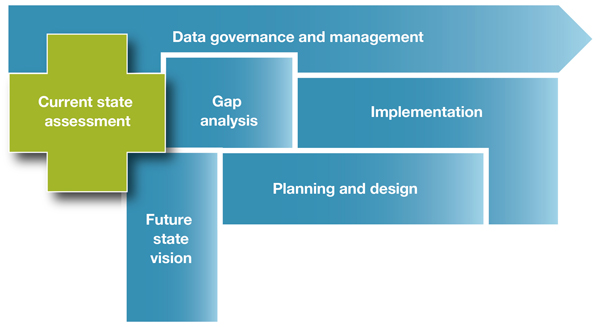
A good current state analysis is one that is produced in collaboration between the client organization and the consulting firm. It’s one in which the consulting firm actively facilitates the gathering of the many organizational functions engaged in carrying out that component of the operational model (including occasionally suppliers and customers), which results in the documentation of the (actual) existing manner of working. It makes use of the organizational functional expertise to determine what needs to be fixed and what special characteristics of the existing state ought to be preserved in the future state (to-be) solution.
Individual interviews with functional leaders, process observations, and workshops with functional leaders and operators are typically used to create a current state evaluation.
The facilitator, who is typically a very skilled consultant, can encourage lively discussion of the situation among all attendees while still showcasing industry knowledge and pertinent subject matter expertise (systems, process, organisational, etc). This is stacked on top of an awareness of and method of working within the organization’s culture that fosters buy-in for the present situation and the opportunities that have been discovered. A truly skilled consultant will be able to control the workshop and interview process in a way that gives the client the impression that they were the ones who discovered the opportunities. This results in the buy-in that is necessary for a successful deployment.
Clients frequently make the error of assigning ‘available’ individuals to work on the current status evaluation rather than the ‘appropriate’ resources. Actual experts from the client organization must participate in assessments of the current status. employees with some experience in their field. They are respected by their peers and are experts in the operational model area that is being evaluated. Similar to this, consulting firms frequently make the error of using less priced junior and inexperienced consultants to document the existing situation.
For me, a successful current state assessment is one in which all functional individuals who took part in the documentation of the present situation and potential areas for development are confidence enough in the outcomes of the As-is (Current State) workshop(s) that they are ready to:
• Sign the final version of the current state and opportunities working paper (brownpaper).
• Where one or two of the functional leaders agree to present the current state and opportunities identified to other employees of the organisation through a formal event (town hall meeting) where all employees are invited to review, comment and ask questions about the current state and opportunities being presented by their (respected) colleagues.

Exercise 1.1: Classroom Trivia

Course Manual 2: Analysis Tools
Prior to performing an internal analysis, you must choose the instruments you’ll employ. There are numerous frameworks and tools available, and each one has its advantages and is best suited for a certain task. For firms to have a successful growth strategy, internal analysis’s involvement in analytical growth is crucial.
We’ve created a list of some of the most well-liked and successful frameworks, along with explanations of what they’ll help you do, to assist you in making the best decision.
GAP analysis
GAP analysis is an evaluation tool that allows organizations to identify performance deficiencies and internal weaknesses.
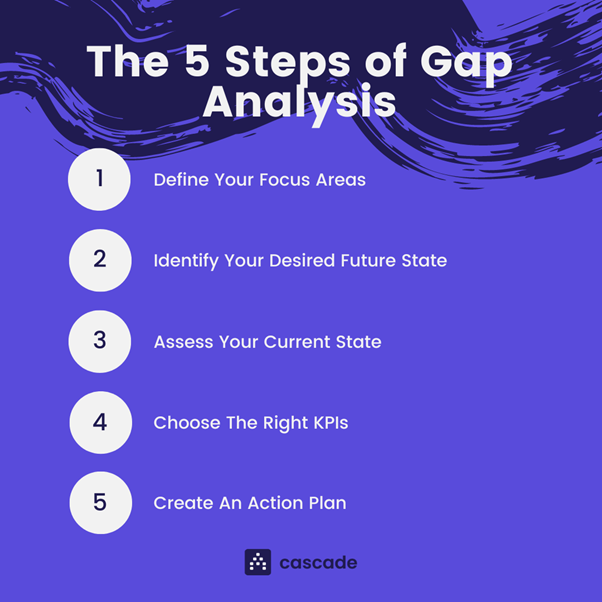
It is an easy-to-use framework. It assists in making comparisons between the present organizational state and the intended future state. It makes it simpler to develop a set of steps to close those gaps by assisting you in recognizing and comprehending the gaps between the two states. To hasten the expansion of your business, some of these steps can involve combining with or buying out another company.
GAP analysis aids management in determining whether their organization is operating at peak efficiency and, if not, why. It also aids in identifying problems with resource management, planning, production, etc.
The benefits of using the GAP analysis methodology
GAP analysis is a superior framework for fine-tuning a single process (or a chosen few), rather than the organization as a whole, whereas other internal analysis methods, such as SWOT analysis, allow a more thorough evaluation of the internal environment.
Strategy evaluation
A strategy evaluation examines the outcomes of the application of a strategic plan.
It’s helpful to periodically evaluate your approach to make sure that everyone is aware of it and following it. You might want to carry out such an assessment every six months, once a year, or following the implementation of a revised business strategy. It really depends on how many adjustments you’re attempting to make.
Looking back at the objectives of your strategic plan and evaluating how effectively your strategic management activities performed in accomplishing them are both part of the strategy evaluation process. If your attempts to grow organically were unsuccessful, perhaps this is a situation where M&A would be advantageous.
The benefits of using the Strategy Evaluation Framework
Strategy evaluation compares the effectiveness of your strategy implementation process to “business as usual.” The best strategic strategy in the world won’t help you if it isn’t put into action. By means of an acquisition or merger, use this framework to synchronize your strategy with the corporate culture.
SWOT analysis
One of the more well-known and frequently applied business analysis frameworks is SWOT analysis.
It is well-liked for its effectiveness and simplicity (it includes both an internal and external analysis). The four components of the SWOT matrix are the source of its name:
• Strengths (internal)
• Weaknesses (internal)
• Opportunities (external)
• Threats (external)
SWOT analysis can help you find a profitable market niche and increase your market share. It enables businesses to find outside opportunities they may take advantage of while also pinpointing internal causes of problems. It also aids in lowering the possibility of incoming threats.
Below is an example of a SWOT analysis in regards to acquisitive growth. It shows the strengths, weaknesses, opportunities and threats in relation to inorganic growth.
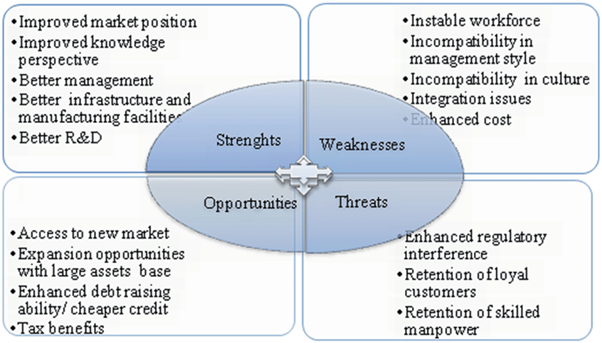
Here is a condensed Starbucks SWOT Internal Analysis example:
Strengths
• Global leader in coffee and beverage retailing.
• Strong brand equity and great brand recall.
• One of the largest coffee houses globally, which allows it to price its products for the middle-income group.
Weaknesses
• Heavy dependence on coffee beans.
• Criticized in the past for procuring coffee beans from impoverished third-world farmers.
• The price is still costly for many working consumers.
Opportunities
• Should expand to the tier-II cities of the emerging countries in order to further increase its customer base.
• Should expand its product portfolio to venture into the full spectrum food and beverage business.
Threats
• Profitability is always at the mercy of the rising prices of coffee beans and the supply network.
• Strong competition from the local coffeehouses and specialty stores that offer similar products at a cheaper price.
Then, Starbucks or any other corporation can utilize this research to create tactical options that will support the achievement of its objectives.
Why choose the SWOT analysis framework
Understanding their distinctive talents and sources of competitive advantage, which can help them compete in their specific marketplace, aids firms in setting themselves apart from rivals. If you are having trouble expanding in your present market, acquisitive expansion might be helpful in this situation. Greater financial sturdiness results from mergers and acquisitions for both parties engaged in the deal. Increased economic clout can result in more market share, increased customer sway, and diminished competition danger. Larger businesses are typically more difficult to compete against.
VRIO analysis
The VRIO framework is a great tool for assessing an organization’s internal environment.
• Valuable
• Rare
• Inimitable
• Organized
The framework can be extremely valuable for firms wanting to stay ahead of the competition because it is clear to grasp and utilize. Due to this, the tool has become a popular option for many businesses wishing to examine their internal environment.
The foundation for classifying a firm’s resource as a competitive advantage is whether it fits inside the framework’s dimensions.
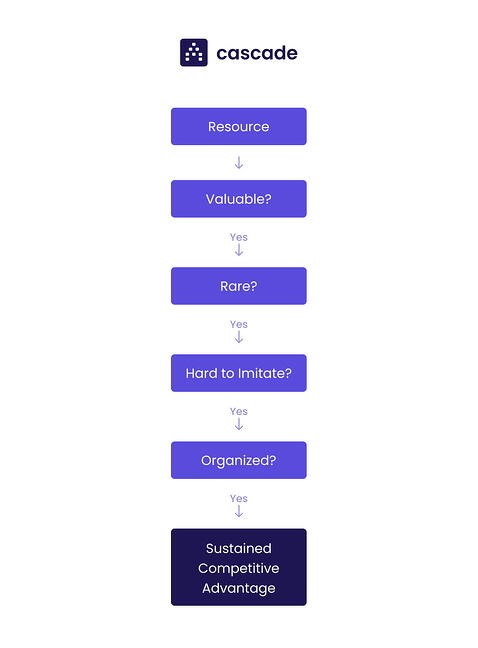
It examines internal resources within an organization and groups them according to the overall benefit they provide. A framework called VRIO can assist you in developing long-term competitive advantages.
It enables you to recognize your distinctive capabilities and turn them from temporary competitive advantages into long-term success drivers.
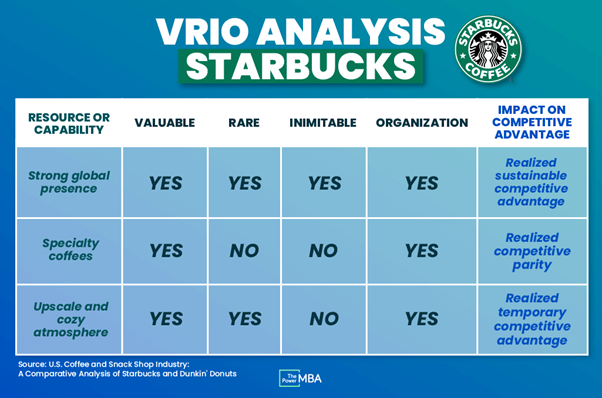
Why choose the VRIO analysis framework
VRIO analysis is the tool you need if you want to create a plan that capitalizes on your company’s competitive edge. You will gain a greater grasp of your resources and the value that your company adds. As previously noted, if your organic growing strategies have failed, expanding your firm inorganically may be your greatest option for locating your niche or competitive advantage.
McKinsey 7S framework
The McKinsey 7S Framework is another well-liked and tried-and-true technique.
Organizations wishing to assess the degree of process and departmental alignment should use McKinsey 7S. The model may evaluate the gaps and inconsistencies between an organization’s present state and a desired future state.
You are prompted by McKinsey 7S to examine seven internal factors that must be in harmony for your organization to succeed. They are as follows:
• Strategy
• Structure
• Systems
• Shared Values
• Skills
• Style
• Staff
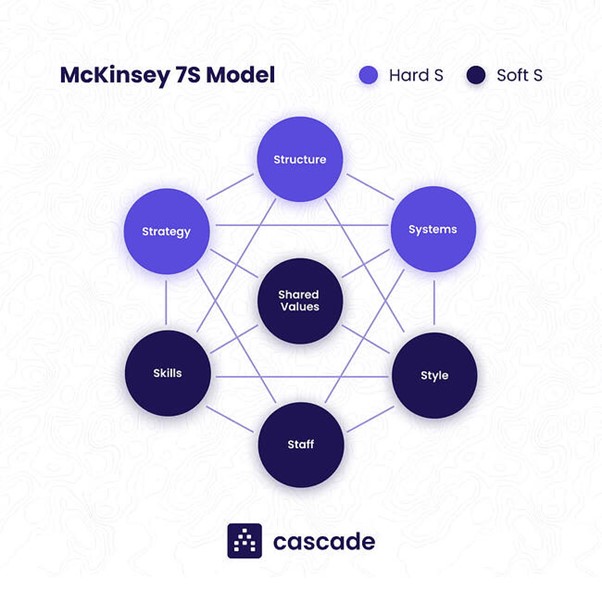
The McKinsey 7S framework: why use it
This approach offers a truthful assessment of the internal alignment inside the firm. It looks at a variety of internal factors, including the workforce, leadership skills, and process effectiveness as well as the company’s culture.
Core competencies analysis
Organizations can outperform the competition by defining their distinct advantage with the use of the core competencies analysis.
The analysis’s fundamental concept is to pinpoint the company’s core capabilities, or the resources, expertise, and knowledge that it has integrated to offer a distinctive value to its clients. An organization can put strategies that are precisely geared toward its advantages and added value once it has determined its core competencies.
Why utilize this framework?
This form of analysis, in contrast to others, places more emphasis on intangibles than on tangible resources. It emphasizes distinctive benefits that are also tactically sound.
Even for seasoned companies, entering a new market can be difficult. A merger or acquisition can save businesses a significant amount of time, effort, and money in comparison to beginning from scratch, even though opening a subsidiary or branch is always an option. This is particularly true for companies who are prepared to enter a foreign geographic market. International markets can be extremely challenging to break into. Therefore, it is more practical for the majority of businesses to combine with or purchase an existing local company that already has a solid clientele.

Are internal and external analyses related to one another?
Analyzing the internal and exterior environments is similar to yin and yang. A picture that is partial and skewed is created when one is done without the other.
Evaluation of your market, the state of your sector, and the external environment reveals prospective opportunities and challenges. Organizational shortcomings and strengths are highlighted through an evaluation of the internal environment, the company’s resources, and its competencies.
Combining the two results offers you a more comprehensive understanding of the state of your firm. If you want to develop a successful corporate growth strategy that considers both internal and external issues, you’ll need both.
What are Porter’s Five Forces?
A strategic framework called Porter’s Five Forces helps to identify and examine five factors that have an impact on a company’s profitability in any given industry. These are the five forces:

1. Threat of new entrants
2. Bargaining power of suppliers
3. Bargaining power of buyers (customers)
4. Threat of substitutes
5. Competitive rivalry
A key component of strategic analysis, Porter’s Five Pressures helps businesses determine how to balance competing forces to maximize profitability.
Companies should place themselves where the forces are weakest, take advantage of changes in the forces, and shape the forces to their advantage based on the framework (Porter, 2008). A speedy growth in your company’s market share may be possible through an acquisition. Growth by acquisition can be useful in acquiring a competitive edge in the market, even though competition can be difficult. Market synergies are accomplished through the method.
Advantages of Porter’s 5 Forces Model
The advantages of Porter’s 5 Forces model are:
• Organizations can learn how profit is divided among the five forces.
• It enables organizations to identify which players are in control and set rules.
• It provides company strategists with insight and a baseline to evaluate the company’s strengths and weaknesses.
• It provides a holistic overview of any industry and helps strategists identify the most important factors that can affect their position in the industry.
• It helps strategists to think more comprehensively about the industry and discover non-obvious opportunities that can also attract higher investments and affect the company’s future growth.
PESTEL Analysis
An analytical framework known as a PESTEL analysis is frequently used to assess the business environment in which a firm operates. Political, Economic, Social, and Technological (PEST) analysis was the term used in the past to describe the framework; more recently, the framework’s scope was expanded to include environmental and legal considerations.
Management teams and boards apply the framework in their corporate risk management planning and strategic planning processes. PESTEL research is likewise a well-liked tool in the financial analyst community, where elements may affect model assumptions and financing choices, and among management consultants who assist their companies in creating innovative product and market efforts.
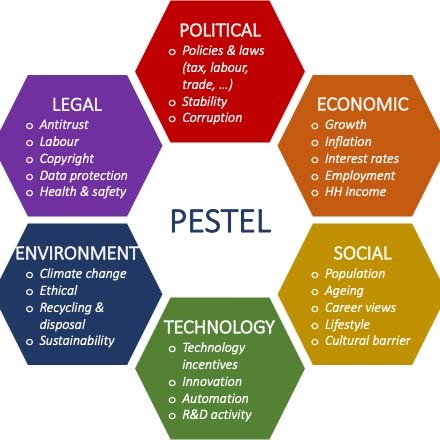
Other industry- and firm-level frameworks can incorporate key PESTEL study findings.

SWOT Analysis example: The Coca Cola Company
Strengths
• Product diversity – The Coca-Cola Company’s extraordinary product diversity across many categories is one of its greatest strengths. In actuality, Coca Cola has over 500 brands spread across 200 businesses. They get greater market dominance as a result, as well as more diverse skills and less overall competition.
• Market share – Compared to many of their rivals, they have a very strong position with a market share of 43% in the soft drink sector. This also implies that it would be very challenging to compete with Coca-Cola given its virtually limitless resources.
• Brand recognition – Coca-Cola is among the most well-known brands in the world, which gives them a significant competitive edge. Additionally, it implies that any new product or brand they invest in will quickly become well-known.
• Secret recipes – last but not least, the business takes great satisfaction in using a proprietary formula to create its trademark beverage, Coca-Cola. This indicates that it will be challenging for rivals to produce a similar product.
Weaknesses
• Health trends – The company’s inability to adjust to current health trends is one of its main vulnerabilities. Soft and sugary drinks are gradually being replaced with healthier options as people become more aware of the bad diet they eat and the quantity of sugar they consume.
• Sugar substitute – The inability of the corporation to improve the quality of its product without compromising its well-known taste is another health-related drawback. For years, Coca-Cola has actively searched for healthier sugar replacements without success.
• Current positioning – Coca-and Cola’s its soft drink’s current positioning is both a blessing and a burden. Fortunately, everyone is familiar with the brand and the goods it sells. Every company aspires to have this level of brand recognition.
However, this shortcoming results from the fact that Coca-Cola has already developed a brand for itself that is challenging to alter. And it’s definitely not the most optimistic one, given its sweet drinks made with unidentified substances.
Opportunities
• Health trends – The Coca-Cola Company has a significant opportunity to grow its market share if it pays close attention to and appropriately addresses current health trends. and obtain a larger share of the soft drink market. especially if they are able to locate a sugar alternative that is nutritious.
• Few major competitors – due to the dominance of the brand and the small number of big rivals for these specific product categories, Coca-Cola can quickly launch new goods with the appropriate marketing plan.
Threats
• Healthier alternatives – despite the company’s considerable dominance in the soft drink industry, many new, healthier options are entering the market. As individuals become more concerned with their health, they are beginning to prefer alternatives such flavored waters, smoothies, organic beverages, green juices, and so forth.
• Negative press and media attention — Despite The Coca Cola Company’s stellar marketing methods and outstanding brand recognition, it frequently receives bad press for being harmful. In-depth studies, YouTube videos, and even articles from reliable sources like The Telegraph could have detrimental long-term effects.

Exercise 1.2: Strengths, Weaknesses, Opportunities and Threats (SWOT).

Course Manual 3: Identify Stakeholders
Important stakeholder types
Some of the most typical categories of important company stakeholders are listed below:
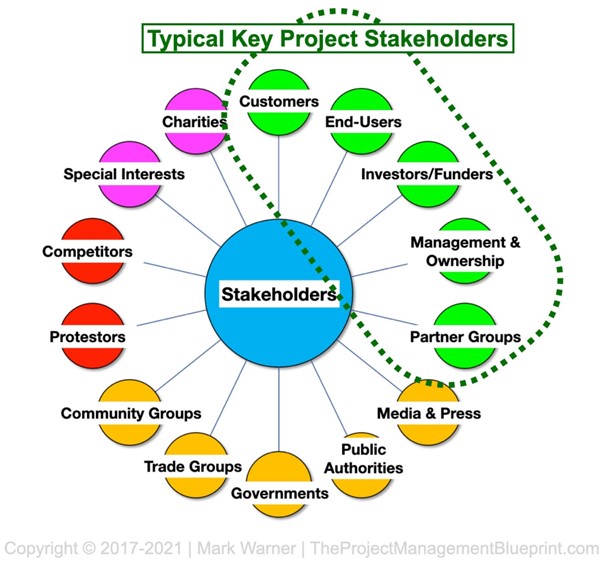
Employees
The success and operations of a firm can have an impact on its employees’ wages, job security, and other factors. When an employee’s employer has a significant impact on both them and the organization, they are considered a key stakeholder. For instance, project managers may have a significant amount of influence over the accomplishment of a company’s aims and activities, making them critical stakeholders.
The Impact of Acquisition and Merger on Employees
Companies can get stronger through mergers and acquisitions if they can increase their customer base, lessen competition in the market, and provide value that exceeds what each firm could provide on its own.
It’s crucial to consider how a merger and acquisition would affect employee performance before you enter into any agreements. In the middle of what may be described as a turbulent transformation, leaders must find strategies to sustain employee engagement, motivation, and contentment.
Despite their inherent advantages, mergers and acquisitions can have a stressful effect on personnel. Business leaders can reduce some of the disadvantages that come with mergers and acquisitions by managing the impact on staff performance.
When weighing the benefits and drawbacks of mergers and acquisitions, the effect they have on personnel is unquestionably one of the riskiest variables.
No matter how many additional assets a firm has acquired or how much money it is saving as a result of the merger or acquisition, poor personnel management can bring it crashing down.
Let’s examine some of the impacts of mergers and acquisitions on worker productivity as well as strategies for motivating and retaining staff in the face of change.
• As employees watch their co-workers laid off, they might face uncertainty.
• Employees from the two organizations may compete instead of working together.
• Employee morale may suffer as a result of merging two corporate cultures.
• Employee motivation may drop as frustration with new roles and new co-workers or management increases.
You should take on these difficulties head-on as a manager or business owner. Being upfront and honest at every stage of the process is the greatest way to lessen the effect that mergers and acquisitions have on the workforce.
Avoid leaving employees in the dark about their future; instead, communicate about new positions and layoffs as soon as possible to reduce ambiguity.
Customers
Customers can be impacted by the nature and scope of a company’s offerings, making them one of your stakeholders. If a consumer helps develop or carry out a new business project, they might be one of your major stakeholders. For instance, some companies offer particular target customers free samples in return for frank reviews or invite them to participate in focus groups.
If your clients are authorities in your industry, they could also be important stakeholders. For instance, if dentists publicly praise your toothpaste product, such dentists could be very important to the success of that product line. Similarly, if your company’s toothpaste line performs well, the dentists who give your product positive reviews may also see an improvement in their business.
Which is preferable, customer acquisition or customer retention? Actually, that is a deceptive statement because both are critical for sustainability and growth in different ways.
However, a lot of businesses devote the majority of their effort and money to acquisition. Retention-boosting initiatives are frequently postponed or completely ignored. However, for some business models, retention gives a far larger return on investment from advertising spend and is frequently much more affordable than its competitor.
What is customer acquisition?

Customer acquisition is the process of acquiring new clients, to put it simply. It entails drawing potential customers to your firm and then convincing them to purchase your good or service.
How growth is fueled by acquisition and retention
Acquisition and retention work similarly to a bird’s two wings, without which it is difficult to fly. In the same manner, to succeed in the subscription industry, you must first attract clients before keeping them.
Of course, growth is fueled by both acquisition and retention in different ways. For illustration:
Acquiring expands your clientele
It should go without saying that a business has no reason to exist if there are no clients to serve. To start your business, you needed to get at least a few clients. You may now increase your customer base and find more business prospects thanks to the continual process of customer acquisition.
Customer lifetime value increases with retention.
The projected value of a customer over the term of their engagement with your business is known as their lifetime value (CLV). It goes without saying that repeat clients are nearly always more beneficial to your business than one-time customers. By encouraging them to do business with you repeatedly, a solid customer retention plan enables you to optimize the lifetime value (LTV) of your clients.

Investors
Investors frequently play a vital role in your company’s success because they immediately impact your personal or corporate finances. The success of your company might also be directly impacted by the investors’ continuing financial backing.
All investors are likely to be significant stakeholders for a smaller or medium-sized business. The major investors are probably those that your business depends on the most financially, especially for larger companies with dozens or hundreds of investors.
Organic vs. Inorganic Growth Investment Analysis
Most investors would choose to invest in company B if it were growing at a rate of 25% as opposed to firm A’s 5% rate of growth. The underlying premise is that firm A has a lower rate of return because it is expanding more slowly than company B.
But there’s also another scenario to take into account. What if Company B acquired its rival for $12 billion and saw a 25% increase in revenue? In actuality, company B’s revenues were actually decreasing by 5%, which is why company B decided to buy its rival.
Firm B may be expanding, but there seems to be a lot of risk involved, whereas company A is expanding by 5% without making an acquisition or needing to incur more debt. Even though company A expanded considerably more slowly than company B, it may still be a better investment. Although some investors might be willing to accept the added risk, others choose the safer investment.
In this case, firm A, the more secure investment, saw a 5% organic sales increase. The expansion was brought about by an increase in demand for the business’s current products and didn’t involve any mergers or acquisitions. Revenue for Company B fell by 5%, which represents a slowdown in organic growth. In general, growth increased as a result of purchases made using borrowed money. Growth for Company B is entirely dependent on acquisitions rather than its own business model, which might not be good for investors.
Company leaders
Key stakeholders are typically corporate executives. The executives of a firm make important choices that affect daily operations, long-term objectives, and development initiatives. Executives and the business may be impacted by these choices.
Every CEO and corporate leader hopes to provide growth, but for many, it eludes them. Only one in eight businesses between 2010 and 2019 experienced yearly revenue growth of more than ten percent, while around a quarter of businesses see no growth at all. But there is a way to expand steadily and profitably, and it all comes down to “choice.”
A crucial group of execution enablers, including operational model and resource allocation, ecosystems, M&A, joint ventures and alliances, and functional competencies, are prioritized by leaders who opt for growth in order to support their goals.
Do you, as a leader, consciously decide to develop? Or do you only pretend to have growth goals and lose heart if you don’t see immediate financial gain?
Decision-making in every facet of the business is influenced when sustainable, equitable, and profitable growth becomes a deliberate, firm choice. Growth becomes an organization’s lifeblood, sustaining the culture, boosting aspirations, and igniting a feeling of mission. Over a ten-year period, growth leaders produce 80 percent more shareholder value than their rivals. Growth attracts talent, encourages innovation, and generates employment in addition to producing profit for shareholders.
Competitors

Although they might be a challenge for your organization, rivals are frequently significant stakeholders. A competitor may have an impact on the strategic choices or day-to-day operations of your company if they provide comparable goods or services to the market. For instance, your company might work on product or service development, reduce prices, or change your sales strategies to help set your company apart from the competition.
Government agencies
Your country’s or region’s political system has an impact on how you run your business. Taxes on businesses, workplace safety standards, and financial protections are governed by rules and regulations created by government bodies. Your local government can additionally have rules specific to your sector of business. For instance, medical practitioners frequently have to abide by special healthcare laws.
Vendors
To complete their tasks and projects, many firms rely on vendors. Similar to how these suppliers rely on your firm for financial support, Suppliers, distributors, and contractors for your company are examples of vendors. They might provide raw materials, technology, or business loans to your organization.
Communities
The neighborhood in which a firm operates and makes decisions might have an impact. For instance, a company’s reputation both locally and internationally may be impacted by the thoughts of the local community.
Businesses can have an impact on the neighborhood where they are located. A local business may bring financial stability, new job opportunities, and economic growth to its community.

How to recognize important stakeholders
The five steps to identifying your company’s main stakeholders are as follows:
1. Examine your shareholders
Make a list of all the company’s stakeholders. This group could include:
• Customers
• Investors
• Company leaders or executives
• Creditors, such as banks
• Employees
• Government agencies
• Department managers
• Vendors
• Business owners
• Regional or national communities
• Potential customers
• Professional organizations in your industry
• Suppliers
• Distributors
• Supervisors
• Labor unions
• Shareholders
• Industry trade groups
• Competitors
• Agencies that oversee regulations in your industry or nation
2. Recognize the rationale behind selecting your key stakeholders.
Identifying important stakeholders for your entire firm may be necessary at times. These general essential stakeholders frequently include business owners, top executives, significant creditors, investors, and any governmental organizations that provide funding for your projects.
Sometimes you might also wish to figure out who the main players are in a particular project or company endeavor are. These lists of key stakeholders frequently diverge, even if there may be some overlap between the general key stakeholders and the key stakeholders for specific projects. Employees, such as department heads or project managers, are more likely to be key stakeholders in a project. Additionally, specific target customer or associated vendor groups are more typically included in a project’s key stakeholders.
3. Analyze how they will affect your operations.
Determine which of your stakeholders has the most influence over your firm, whether it is on a particular project or your business overall. Consider the following in regard to each stakeholder as you go over your list of stakeholders:
• If they make or could make a fundamental difference to your business
• If you can specify what you want from the stakeholder
• What you hope to gain from your business’s relationship with the stakeholder
• How they have affected your business in the past
• If the stakeholder could help your business develop or grow
• If the stakeholder exists in multiple categories, such as if they are both an investor and executive
• If another stakeholder could easily perform the stakeholder’s responsibilities
4. Find out what they need in terms of your business.
Consider not only how each stakeholder may impact your company but also how the stakeholder may impact your company. Write out each stakeholder’s requirements in regard to your company, such as:
• Why they are interested in this project or your business as a whole
• What they expect for the project or entire business
• What role or influence they have over operations
• How frequently you need to contact or send them updates
• How important their satisfaction with the project or business is
5. Set your list’s priority.
Review the people on your list of stakeholders. Determine which stakeholders and who your business most significantly impacts. The amended list represents your principal stakeholders.

Advantages for major stakeholders
Your company’s key stakeholders can support its growth and operation in a number of ways. Key stakeholder benefits vary depending on a variety of variables, including their particular function, expectations, and whether they are project-specific or general key stakeholders. The following are some of the typical ways that important stakeholders might help your company:
• Minimize risks: Stakeholders can offer various perspectives on your business operations or projects. Their unique viewpoints can help your business reduce the effects of business risks or potentially avoid those risks altogether.
• Provide resources: Stakeholders frequently provide businesses with resources necessary to the company’s operations or goals. These resources may include financial support, project materials, technology systems or human resources.
• Develop or grow business: Key stakeholders often help make crucial decisions about a company’s development opportunities, expansions or structural changes. They have a personal interest in seeing your company grow and succeed.
• Help operations run smoothly: Some potential key stakeholders, such as employees or department leaders, influence the day-to-day operations of your company. These stakeholders play important roles in making sure regular business tasks and assignments function productively.
• Align operations with a strategic vision: Key stakeholders understand the long-term goals of your company. Their knowledge of the company’s overall objectives can help ensure that your particular business operations or projects work towards the ultimate vision for the company.
Internal vs. external key stakeholders
Important parties may be internal or external. An individual who works for your business directly is an internal stakeholder. Employees, firm owners, investors, and board members are internal stakeholders. However, external important stakeholders are those who are impacted by your company but do not directly work for you. Distributors, regulatory organizations, customers, and creditors are examples of external stakeholders.
To identify whether your stakeholder is internal or external, consider the following factors:
Interest levels in your business
The success of your company’s internal key stakeholders affects them personally and financially. Although they rarely have a personal stake in your organization, external stakeholders may profit financially from it. For instance, even though your suppliers profit from your business, their lives are unaffected by your operations. However, because they spent their own money in your business, your investors are more likely to be impacted by it financially and personally.
Impact on your business
Internal stakeholders have an impact on a company’s daily operations. Board members make important choices concerning operations, employees carry out vital everyday activities, and department managers supervise projects and tasks.
However, external stakeholders hardly ever have an impact on your company’s regular business. While your customers, for instance, have an impact on your company’s finances, they have little influence over the routine decisions that your staff or company executives make.
Influence of your company on the stakeholder
In comparison to external stakeholders, your organization has significantly more sway over internal stakeholders. For example, workers depend on your company to give them secure employment and consistent income. However, distributors have other revenue streams and staff support programs.

Stakeholders vs. shareholders
Despite being a subset of stakeholders, stockholders are not the same as stakeholders. People who own stock in a firm are called shareholders. Because they don’t have a direct connection to your organization but do have a financial investment in its success, shareholders are a form of external stakeholder.
The majority of stakeholders, however, have a more substantial financial interest in a company’s functioning. For instance, investors have decided to contribute money to help a business achieve its long-term objectives. As another illustration, even if a distributor probably has other clients, their financial performance still has something to do with your particular business. However, a shareholder can rather easily transfer their shares to another business or cash them out. Shareholders may decide to change their financial relationship with your firm at any time, despite the fact that they probably want it to flourish.
The Five Stakeholder Groups in M&A
Different groups must participate in the M&A process at various phases of the deal. the following five M&A stakeholder groups:
• C-suite
• Business unit leadership
• Corporate development
• Transaction lead
• External advisors
It is crucial to know who is seated in the aforementioned groups before engaging in any M&A activity.
The C-Suite
The Investment Committee (“IC”) will be led by the CEO in conjunction with the other members of the C-suite. The decision-making process for any deal ends here. The IC retains final decision-making authority and accountability for each and every transaction’s success or failure.
The IC is in charge of making sure that in the other groups, the proper individuals are seated in the appropriate places. As the process progresses, they aid the various groups in maintaining discipline and focus. If someone doesn’t help keep the teams in sync, the M&A negotiation process can soon become chaotic. The IC is this driving force that promotes collaboration and a laser-like focus on the goal.
The IC will be crucial in the early stages of the M&A process. They will develop the post-transaction entity’s vision and make sure the other groups are constituted effectively. The IC may not be as involved in day-to-day activities after the process is under way. They must, though, remain accessible to make crucial choices and guarantee that the other groups are cooperating to achieve the same objective.
The Business Unit Leadership
Once a deal is finalized, the newly acquired firm will start functioning as part of the buyer’s company. This frequently takes the form of working with an already-existing unit. Early on in the process, the Business Unit team should be involved to offer strategy advise, such as when it would be wise to pursue M&A activity and when it might be better to hold off.
The business unit team should play a significant role in the due diligence and integration planning phases of the M&A transaction. Given their unique expertise in the sector and Target Co., they ought to be able to help spot warning signs and spot potential synergies if the deal closes.
It could be challenging for SMBs to have a committed, full-time business unit team. Employees frequently have to wear several hats, and the time demands may divert them from their regular daily work. The IC must convey to all parties the significance of the transaction. Business unit members risk creating issues that cause them trouble in the future if they rush through diligence or integration planning so they can return to their regular tasks. The team should adopt the philosophy of “measure twice, cut once,” and, most crucially, they should be aware of the IC and C-unwavering suite’s support for them.
The Corporate Development Team
From the beginning to the end of the M&A process, the corporate development team is involved. With the express purpose of closing deals, a dedicated team may exist for serial acquirers. The corporate development team may be formed as needed and dispersed after the deal is closed for smaller firms.
The typical duties of the corporate development team include target identification, oversight of the due diligence procedure, and bid/negotiation with the target.
Members of this team must be knowledgeable about the target, the market, and the benefits of doing business with your organization. In an M&A transaction, sellers take into account a number of non-financial reasons. Problems may arise if the seller believes you are not the proper buyer despite the reasonable price.

The Transaction Lead
Realizing synergies is a frequently stated justification for conducting an acquisition. “1 + 1 = 3,” a common formula. Make sure your transaction lead is involved at the appropriate moment if you are pursuing a transaction in the aim of obtaining such synergies. The Lead’s role is to assist with deal closure and integration.
Think again if you believe that your agreement is complete once the paperwork is signed and the wire is received. The synergies that motivated you to pursue the deal might be made or broken throughout the integration process. Your lead must be involved in the transaction as soon as possible. Ideal candidate for the position would have previous transaction experience. If this is your first time going through the M&A process, choose a member of your team who is well-organized and has excellent management and execution skills.
The External Advisors
Even though you and your business are probably very talented, the M&A process won’t give you all the information you need. None of them do. CPAs, attorneys, and other deal makers could be some of your outside advisers. Ask for their help to make sure you are heading in the proper direction. Ask your advisors to participate from the beginning of the process till close. They can assist you in seeing warning signs, traps, and, more fortunately, good possibilities.
Will it be slightly more expensive to retain your outside consultants for the duration of your deal? Yes.
It will be less expensive than a contract that is defective and badly executed and that you later regret.
Conclusion
Discipline and having the right personnel in the right positions are necessary for running an effective M&A deal process. If you are fresh to the world of mergers and acquisitions, I would suggest that you seek out outside help and learn as much as you can from successful deal makers.
It is very simple for smaller businesses to overlook certain steps in the process or to make incorrect assumptions when they are starting out on this path. Create a strong transaction team, get independent counsel, and always remember to take something away from each experience. Maintaining a transaction playbook will allow you to review the lessons you’ve learnt from past M&A adventures when you go on your next M&A adventure.

Case Study: How Unilever effectively communicates with it’s stakeholders
Unilever explains how they must collaborate closely with all of its stakeholders in order to fulfill their purpose and expand their business, including their employees, shareholders, governments and regulators, suppliers, customers, scientists, NGOs, communities, and peer businesses (often through trade associations). The multi-stakeholder model used by Unilever and how it is intended to provide value to all stakeholders are both explained in the Compass.
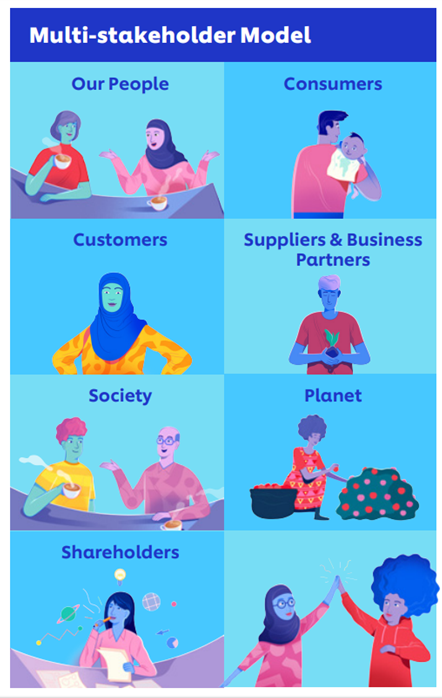
Transparent and responsible
They are steadfastly committed to conducting themselves ethically. Unilever strives to be open and truthful with their stakeholders in whatever they do.
The greatest standards of conduct are required in order to uphold their reputation and foster confidence. The standards that Unliever expects of all of its employees are outlined in their Code of Business Principles and Code Policies, which include one of the four code themes, “Engaging Externally,” which addresses topics like ethical marketing, political activism and donations, and interactions with the government, regulators, and NGOs. They also demand the same morals and conduct from those with whom they work.
How Unliever engages with their stakeholders
Unilever, a multinational corporation with products sold in almost 190 countries, engages in daily interactions with a broad spectrum of stakeholders. A overview of how they interact with some of their most significant stakeholder groups is given below.
Shareholders
Open and efficient communication with their shareholders is important to Unilever. Through quarterly results broadcasts, conference presentations, meetings, and calls, they communicate directly with shareholders about many areas of business performance and consumer trends.
On a variety of topics, senior executives and their Board have direct conversations with shareholders. Unilever, for instance, discussed innovation and non-animal testing methods with investors in 2021. Unilever presented their Climate Transition Action Plan to their shareholders for a vote as part of their engagement efforts in 2021.
Their people
148,000 talented individuals work with Unilever in more than 100 nations, contributing their talents and time in offices, factories, R&D facilities, and tea estates. Their success depends on maintaining their interest and keeping them informed.
Unilever offers their employees numerous opportunities to voice their opinions to them. Their yearly UniVoice survey is an important resource for gauging employee attitude. The UniVoice employee survey was completed by almost 90,000 workers in 2021. Unilever maintained extremely high levels of employee engagement (82% in offices and 83% in factories), placing them in the top percentile when compared to industry norms.
In order to provide their workers with direct access to their leadership team on a regular basis, Unilever holds biweekly “Your call” sessions with their CEO and ULE members. During these sessions, the leadership team responds to queries on pressing topics. Unilever often hosts virtual town hall meetings in each market to interact with employees about issues and subjects that are pertinent to that location.
Unilever hosts virtual “Compass Live” events, inviting key senior leaders from across their business to engage with and inform their employees on the Unilever Compass strategy and their progress throughout the year. This helps to keep their employees informed and engaged about their Compass strategy.

Exercise 1.3: Blindfold

Course Manual 4: Core Competencies
What strategic advantages does your business have over the competition? Find out what core competencies are and how to identify them before you decide on a merger or acquisition.
• Business core competencies are your company’s unique abilities, products and services that give it a competitive advantage in your industry and market.
• Personal core competencies are akin to the skills you search for on résumés when hiring new employees for your company.
• There are viable strategies for identifying your core competencies and acting on them, but you should be careful not to misidentify your core competencies.
Although no two companies are alike, some are less similar than others. The more distinctive ways your firm is from those of its rivals, the more probable it is to draw in customers. These distinctive characteristics are linked to key competencies, and when you correctly recognize and utilize these traits, your organization can succeed.
Core competencies: what are they?
Core competences are the distinctive goods, services, abilities, and knowledge that provide a company an edge over rivals. In other words, a company’s core capabilities are advantages over rivals that they cannot realistically match or offer.
An important business technique for demonstrating your value to both new and devoted customers is identifying your company’s core competencies, which include its core goods and most appealing competitive advantages. Knowing your company’s core capabilities will help you promote your company more effectively and expand it by bringing in new clients.
Key takeaway: Your core competencies are what set you apart from the competition in your industry (including products, talents, services, capabilities, and more).
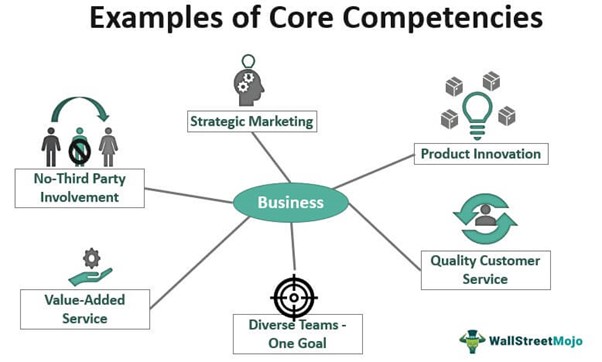
Examples of key business competencies
You might have pondered which of your goods or services you could put among your core competencies when you first read the definition of core competencies above. It’s okay if you weren’t able to think of any right away because fundamental competencies can also include talents and abilities. Here is a list of typical core skills before we move on to some real-world examples of corporate core competencies that aren’t products and services:
• Consistently high quality
• Incomparable value
• Ceaseless innovation
• Clever, successful marketing
• Great customer service
• Formidable size and buying power

Let’s see an illustration of a leader who possesses each of these essential qualities in order to clarify.
• Consistently high quality: Google remains the world’s leading search engine and one of the most-used email, calendar and cloud storage platforms because the quality of its software remains consistently high, no matter the tool being used. Whether you’re using Google Photos to access your beloved memories, Docs to create and edit text or Maps to get around, you’re likely turning to Google for its ease of use, modern look and feel, and extensive organization options.
• Incomparable value: Many companies use Dropbox for quick and simple file sharing not only because it makes these tasks easier but because its price is widely seen as incredibly reasonable for its services. For a massive amount of cloud storage, offline file access, e-sign tools and watermarking features, business owners pay less than $20 per month.
• Ceaseless innovation: QuickBooks has dominated the accounting software industry for decades because it constantly adds new tools and features that other platforms just don’t have. The brand’s ceaseless innovation is the crux of its competency model and a major reason it has long been seen as the first accounting software choice for businesses of all sizes.
• Clever, successful marketing: Chances are good that no matter where you live, you have an abundance of department stores to choose from when you need all manner of items. Despite the competition, Target has continued to expand in large part because its brand is undeniable. Marketing images of employees in red shirts, its branded mascot Bullseye the white bull terrier, its familiar fonts and its consistent red-and-white motif have caught the eyes of customers – and sellers – for decades.
• Great customer service: Amazon is arguably the most omnipresent brand in the world, and its success comes in large part from its unparalleled ability to provide excellent customer service. Given that Amazon’s online marketplace lacks one defining core product and is instead a sea of options that fulfill myriad wants and needs, the company’s strategic planning has long involved an unflagging focus on customer satisfaction.
• Formidable size and buying power: Part of why McDonald’s has been able to expand its dominance not just in the U.S. market but also internationally is its size and buying power. The company is so large, and has such massive buying power, that it can easily afford to open new franchise locations wherever it pleases. It also has enough buying power and a large enough supply chain to purchase food at such low prices that it can sell meals at highly competitive prices.
Even tiny organizations can establish key capabilities during their business evaluation stage, despite the fact that these instances involve large corporations.
Important fact: Not all of the six key core skills are products or services. The majority of well-known brands have developed to their current status by honing at least one of these fundamental abilities.

Personal core competencies examples
You may not be aware of it, but as a business owner, you evaluate each potential applicant’s personal core qualities whenever you seek for new staff. Every ability a job applicant claims on their resume is a personal core competency, and odds are excellent that you’ll bump them to the top of the list when you find someone whose personal core competencies align with your organization’s goals.
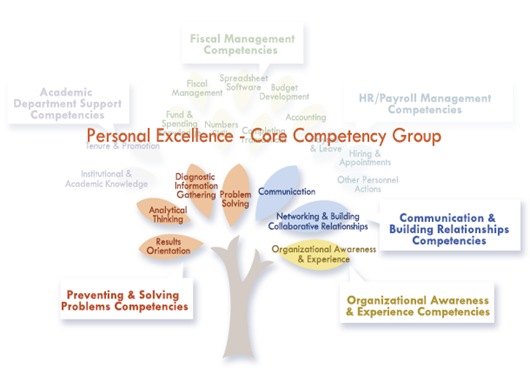
Following are a few instances of typical personal core competencies:
• Strategic planning
• Excellent organization skills
• Leadership and personnel management
• Project management
• Attention to detail
Exceptionally sector-specific talents can also be included in personal core competencies. For instance, if you work in information technology (IT), you might be particularly skilled in a certain computer language or have specialized experience dealing with a particular group of clients. In terms of recognizing essential talents, the last illustration links into a crucial point: You might be able to determine your competitive advantages by considering the people you work with.
Key takeaway: Think of your core competencies as the abilities and distinguishing characteristics you look for in candidates for positions at your firm.
How to determine your core strengths as a business
Let’s revisit the prior illustrations of corporate core skills. You’ll remember that each of these situations involved a major corporation. Don’t let this tendency prevent you from establishing your company’s core capabilities if you run a small firm. Instead, use the procedures below to determine your company’s core skills during the business evaluation stage:
1. Take a look at your clients and customers.
Does your company target a certain consumer base or kind of company within your sector? For instance, some IT graduates go on to deal with special needs pupils whose electronic learning resources must be altered to decrease any potential learning obstacles. Working with clients who have disabilities might be a core strength of a business with a good reputation for offering these services.
2. Turn to the mission statement for your business.
Did you found your business to fill a void that none of your rivals had? One of your core competencies is offering that good or service to that clientele, therefore take a look at your mission statement to recall why and for whom you started your company.
3. With your team, go over your main competencies.
Find out from your staff what they believe your business does particularly well, both in comparison to its rivals and overall. After that, compare their responses to yours. You can identify your core competencies based on the overlap. If you own a restaurant, for instance, and are trying to find out how to thrive in a market that is struggling, get together with your staff to determine the foods and cuisines that are the most popular, and then list those as prospective core strengths.
4. Inspect your core competencies to make sure they are indeed core competencies.
Here’s something crucial to bear in mind: Just because you name something your firm excels at doesn’t mean it automatically qualifies as a core competency. Let’s take the eatery as an example once more: What if your neighborhood’s other eateries are renowned for serving the same dishes as your most popular offerings? Given that your competitors can undeniably duplicate and provide these meals, you might not be able to classify them as core competences in that instance.
Labeling something as a core strength when it ultimately isn’t one can cause your business strategy to change in favor of concentrating on a less lucrative good or service.
5. As required, outsource.
No business can complete all of its critical activities internally. Consider outsourcing or acquiring other business requirements if you are having trouble prioritizing the goods and services that best set your firm apart so you can concentrate on honing your core strengths. For instance, outsourcing your marketing activities can free up time for you to properly design and create the furniture if your company’s primary skill is providing the highest-quality handcrafted furniture in your region. M&A is important during this process since it enables you to concentrate on your core competencies while using a merger or acquisition to work on the other competencies you don’t have time to develop.
6. Test out your fundamental competencies.
Change your business plan to concentrate on your core competencies once you have identified them. Your core strengths have probably been recognized if you find more clients coming to your business, particularly if they are switching from your competitors to you. If not, it’s time to start over, and spending the time to identify what sets your company apart from others is never a bad thing.

Exercise 1.4
• Did everyone agree?
• Where there any surprises?
• Where there any similarities between brands?
• Has this changed your perception of your own core competencies?

Course Manual 5: Market Differentiation
There is more competition among various brands and companies. Many new channels are now available on the market thanks to the development of technology that may be used to develop products or promote services that stand out from the competition. Because more companies are employing the same concept or making the same product, the difference between being original and creative is gradually closing. One of the main reasons why many organizations fail is a lack of innovation or distinctiveness.
Every company needs to understand that differentiation is one of the key success factors that today can help a company succeed. It is crucial for a business to differentiate itself from its rivals in order to make sure that its price is reasonable and worthwhile. If you can’t achieve accelerated growth organically and your firm merely needs that extra competitive edge, these responses will then direct you toward looking for expansion via purchase or merger.
For instance, if a business was successful in the US producing unique products for a particular group of endmarkets and desired to expand, it would first determine whether its objectives could be fulfilled organically. If they are unable to, it is likely because they lack one of the following: a) the ability to access new market segments or geographic areas; b) the ability to utilize their unique strengths in new markets; c) the ability to build new capabilities; and so on.
Through this approach, a business focuses its acquisitive growth tactics to essentially close any strategic gaps that are almost impossible to close organically. For instance, a US-based industrial product company might have created a number of distinctive goods and services that are successful in their current markets, but they might discover that as their share increases and the markets cycle, it becomes more difficult for them to experience sustainable growth. Let’s say that as a result of their strategy work, they locate a new region or market where they may leverage their competitive advantage and expand a whole new source of revenue. This methodology or strategy would assist them in locating this opportunity and concentrating on the skills they must develop, such as new goods, distribution channels, brand awareness, technical proficiency, etc. In this case, it might be to buy a company that is similar to it and integrate their skills into it. Or perhaps all that is needed is the acquisition of distribution channels that fit specific requirements, allowing them to enter and dominate the new market by channeling their current products via them. Another illustration would be the requirement for new items to break into this new market, which might then become the target of acquisitions.

Example: The purchase of a geographic expansion
Banco Santander, a Spanish bank, has likewise chosen a roll-up strategy that places a focus on geographic expansion. At the time its acquisition frenzy started, Spain had a population of less than 40 million people, but Banco Santander did not allow this constrain its expansion ambitions.
It turned to the markets in Latin America and then Europe, where it had an edge due to ties to those regions’ economies and cultures.
Banco Santander’s purchases in Argentina serve as a prime illustration of an acquisition (or series of acquisitions) to enter a new geography.
It began by acquiring a number of small bank organizations in Argentina before expanding to other countries. They acquired Banco del Hogar Argentino in 1963, followed by Banco Mercantil de Rosario y de Santa Fe and Banco Comercial eIndustrial de Córdoba in the following four years. It became Argentina’s largest private banking organization in 1996 after acquiring Banco Tornquist, a country with more banking customers than Spain, according to Statista.

How to Dramatically Differ from the Competition
1. Know your client better than anybody else. More than any of your rivals, gain a thorough understanding of their operations, structure, and problems. I refer to this as their “agenda” of important needs, priorities, and objectives. When you do, you won’t be a commodity anymore. Because they are familiar with us, our histories, our priorities, and our needs, most individuals hardly ever fire their personal doctor or accountant. They are more valuable to us than the next doctor or accountant you see on the street, who may have a fancy degree but knows nothing about us.
2. Be Fresh. You need to put on your own oxygen mask before you can help others, or “The Chinese phrase for crisis combines the characters for chance and danger (although that’s not even true),” or “What would it take for us to win your business?” I don’t know about you, but I’m oh-so-tired of platitudes. Hearing these expressions is like hearing a 1970s FM radio hit for the 10,000th time; they are uninspiring.
Keep it new. Be unique. Provoke people. Take your experiences, choose a subject that interests your clients, and distill your thoughts into four or five sharp points to present to them. Consider the opposite: Is there a “best practice” or technology that is now popular? Tell your clients why it might not be suitable for them or endure long. Not dull and boring, yet sounding new.
3. be regarded as having fame and respect. You will stand out just by having the impression that you are well-known and a leader in your field. The finest possible representation of yourself and your experiences is therefore required. But tread carefully in this area. Many people exaggerate while screaming in an effort to show their competence. Nowadays, it appears like everyone is a best-selling author, a recognized authority, etc. However, the Internet is like a busy restaurant: As it gets busier, it becomes more difficult to be heard. Everyone then starts speaking more loudly. But that makes it increasingly harder to hear, which causes the level to keep going up until people are yelling out in vain to be heard. Establish your reputation gradually. Create compelling arguments for the top three to five problems your clients are facing in your field of expertise. Publish and share brief white papers, blog posts, articles, and other materials to get your ideas in front of clients. Consistency is essential: You have to keep turning the flywheel of building your reputation. If you maintain your regular routines over time, it will continue to grow and become more difficult to stop.
4. Have a Special Process for Relationships. The actual method you choose to communicate with and maintain your relationship with clients is one approach to set yourself apart from the competition. The client may feel that “working with them is different” as a result of this. By the way, the client doesn’t have to wait till they hire you to notice a change; it can start with the way you handle the company development process. You can carefully plan, standardize, and engineer a variety of customer interactions, including:
• Telling versus asking: The way you balance advocacy and inquiry in your conversations, and the kinds of careful, thought-provoking questions you ask
• Speed of response: How quickly to you get back to your client with things you’ve promised? How quickly do you answer your emails and phone calls (even if to say you’re tied up with a client but will thoughtfully respond the next morning)?
• Collaboration: How you involve them in the upfront problem-solving and solution development around your products and services
• Education: How you create opportunities to transfer your capabilities to the client’s own people
• Meeting management: Using an efficient and effective process to make meetings more productive and collaborative
• Follow up. For example, what if you conducted a formal check-in with all clients, three or six months after concluding an engagement?
The possibilities for structuring a series of client interactions that are consistent and bear your distinctive stamp are virtually endless.
5. Develop a Personal Style. If you develop a few little habits and communication styles, they will come to represent you. I used a tiny motor scooter to get around when I was living in Rome. I utilized a soft Land’s End blue canvas bag to carry my paperwork as I traveled about the city seeing my clients because it’s tough to transport a hard leather briefcase on a scooter. I unintentionally established a style that my Italian clients considered to be quite appealing (so they told me). Like them, I was dressed in custom-made Italian wool suits, but instead of having my own chauffeur or hailing a cab, I was scootering around Rome while toting that cheap, even dowdy, but in their eyes, “cool,” Land’s End bag.
Perhaps your particular style is to always dress nicely, regardless of how informal the situation or to always dress informally. My late co-author Jerry Panas used distinctive stationery and frequently sent handwritten notes to his recipients. You would smile as soon as you opened those lovely black letters in your mailbox and realized that Jerry had written to you.
5. Give Life to Their Ideas. There has been a lot written about how to encourage more creativity in huge organizations because it is such a broad topic. However, many top executives will tell you that their issue is not coming up with new ideas, but rather taking some of the concepts they already have and doing a wonderful job of commercializing them. I adore coming up with new ideas, and I know that many top executives feel the same way. If you can distinguish yourself from the competition by demonstrating to a client how to take a notion they already have—but which hasn’t taken off—and turn it into a reality, you will stand out from the crowd.
6. Display Your Genuine Care. Your clients operate their companies and organizations around-the-clock. This is what keeps their careers alive. They are aware of your concern for YOUR company—of course they are. Do you, however, actually respect and care for THEIRS? Or, as the saying goes, is it just another job for you—another day, another dollar? Another factor that distinguishes the personal physician or personal accountant from the individual who comes to your house only once to unclog your sink is this. Customers like working with advisers and service providers who are passionate about what they do and their staff.
Take a true interest in their company, including its background, operations, clients served, merchandise offered, personnel hired, etc. Be enquiring. Spend some time learning about their business “off the clock.” Talk to a handful of their consumers or clients. Learn about the organization’s ideals and principles.
7. Be seen as well-connected. Your opinion of someone you meet for the first time or make a new friend can change depending on who you think they hang out with. Clients will view you objectively; do your professional and social relationships add to or diminish the value of your personal brand? Never undervalue the potential strength of this effect.
8. Build a Better Relationship. I suppose I had to put this on my list. It goes beyond simply being “liked” more than the next individual. Here are just two of the many great advantages that a solid connection may bring: First off, it helps you achieve the first item on my list, which is to know more about your client than your rivals. Second, it forges a personal bond with a customer, enhancing their commitment to you. Keep in mind that we don’t genuinely support someone unless we develop a personal connection with them.
You don’t have to be an expert at each of these nine techniques. Choose a few things you want to do this year.

As an illustration, consider purchasing technology.
Although Google (or Alphabet, as it is now officially known) has closed hundreds of smaller add-on technology acquisitions, it completed what is regarded as its best acquisition nearly 20 years ago.
Google was able to make its initial foray into the mobile phone industry thanks to the $50 million acquisition of Android in 2005.
It would be an understatement to say that the acquisition was a success because, as of 2020, more than 70% of mobile devices throughout the world ran the Android operating system, and this number is expected to rise in the coming years.
The Increase in Niche Technology Purchases
From the Industrial Revolution through the internet boom of the late 1990s and early 2000s, the technology industry has had more than its fair share of economic upswings.
The technology’s exponential development was what propelled these times of fast expansion. However, this was not enough to guarantee profitability for the various businesses running in these times. Many of the companies that were prosperous recognized the most pressing issues of the day and then employed the most advanced technology to offer the best solution.
Today’s prosperous technology companies follow the same tenet, taking the time to consider the problems that humanity faces on various levels and putting into practice the most alluring and efficient technological solutions to these problems. When LinkedIn realized that businesspeople desired their own social network where they could freely discuss industry-related topics with their peers, it adopted this tenet.
Acquisitions are frequently the faster solution if funding is available. While identifying a problem remains the necessary first step, the difficulty now is to locate and purchase an organization or team that is already well on its way to developing that solution, as opposed to developing a marketable answer. An example is Facebook’s multi-billion dollar acquisition of WhatsApp. Another example is LinkedIn’s acquisition of Lynda.com and Slideshare.
Rapid Access to New Markets
Pursuing this inorganic strategy aims to accelerate growth and open up a higher level of profit. Even if Facebook and WhatsApp are at the “large numbers” end of the industry, this acquisition approach may be used anywhere. A clever business strategist can focus on producing highly profitable new services or products that would otherwise take years to bring to market due to the lead time of technological development by purchasing companies to accelerate problem-solving endeavors.
By avoiding the inevitable delays associated with creating new technology from scratch, this strategy enables businesses to devote more time to analyzing industry trends.
From here, the business has two options: either it will concentrate on finding the “Next Big Thing” in its industry, or it will use technology to streamline and possibly automate a portion of its operations without taking away from its core offerings.
The three primary industries are explored here, illustrating the areas where the potential for using technology acquisitions to solve issues is being realized and creating new revenue streams.
Pharmaceuticals
The pharmaceutical industry is one where technology is frequently and clearly seen in action. Large research organizations are increasingly able to automate their routine research and testing processes because to the development of robotics. By eliminating the possibility of workers coming into touch with dangerous materials, this greatly increases safety and frees up these knowledgeable and well-trained teams to focus on new initiatives and advancements.
The leader in this field’s advancement is Julie Huxley-Jones, chief of automation at GSK’s R&D platform technologies. The Financial Times cited her as saying: “We’re really trying to accelerate our use of automation across R&D and capitalise on the major technology changes that have happened in recent years.
“We can go from doing something at the scale of human control down to repeating that experiment thousands of times smaller using robotics and therefore we can make more out of those samples.”
Manufacturers and developers of robotics are popular acquisition targets for big pharmaceutical companies. The option to purchase an operational robotics company is an appealing strategy to allow businesses of the size of GSK to jump up a level, work faster, pursue new markets, and profit sooner. While businesses the size of GSK might have the resources to invest in the development of their own robotic systems, the need to deliver a new drug to market ahead of the competition will typically take precedence for internal resource allocation.

Energy
At the moment, the energy sector is investing heavily in technology related to safety. On a bigger scale, it goes without saying that considerable progress is still being made in the search for the most effective ways to produce and access new energy sources. But the issue of how to enhance and optimize daily operations in a safe manner is receiving significant efforts. Drones are being used to conduct safety inspections at power plants, which is one technological advancement in this area.
Drone ‘brains’ are being developed by businesses like Blue Bear Systems Research, and their technology is being used to great effect for nuclear power plant inspections.
Years have been spent perfecting the intricate technology that powers these drones, which already integrates the expertise of multiple teams and firms. Acquiring a small company like Blue Bear might be a great way for energy corporations to streamline internal business processes and reduce labor expenses by delivering their own safety assessments via drones.
Retail
Although it came a little later than other industries, automation is quickly becoming a crucial technology requirement in the retail sector. Leading companies like Ocado are investing heavily in automated picking and packing technology, which should result in a decrease in the requirement for warehouse labor.
The company has submitted a funding request for the 2020 Horizon project of the European Union in order to support the continued development of its automated systems, but progress is expensive and slow.
Ocado has a reputation for struggling to turn a profit because it took the company 15 years to achieve its first full-year net surplus. It will be fascinating to see if, if it receives finance, it decides to continue tech development internally or takes a more assured tack and considers purchasing an existing technology firm that has already put in the effort and established these automated processes, saving a lot of time in delivery.
Amazon has successfully completed this with a number of tech startups over the years. It acquired Evi, a Cambridge-based software business with a focus on natural language and artificial intelligence that is sometimes referred to as a “answer engine,” in 2012.
Prior to its formal launch in 2007, Evi underwent several years of development and was first known as True Knowledge. When Amazon acquired Evi in 2012, it received immediate access to technology that had taken years to develop, allowing the retailer to concentrate on figuring out the best way to meet the demands of its consumers since the fundamentals had already been established.
Make the Right Inquiries
The biggest earnings will always result from giving the finest answers to the appropriate queries, regardless of the industry. Until recently, providing a cab firm with the ideal management and communication system could earn a corporation a considerable profit. With Uber already revolutionizing the market, the question of “what is the most efficient way to run a taxi company?” is now hardly worth asking. The upcoming introduction of driverless autos heralds yet another change.
Pablo Picasso most likely had little knowledge of mergers and acquisitions, but his works of art caught a fundamental aspect of mankind, and he frequently remarked on subjects with a stunning depth of understanding. Consider his technological observation:
“Computers are useless. They can only give you answers.”
The artist’s joke cuts through the clutter to reveal the secret to achieving significant financial gains from technology: regardless of how intelligent and automated the machines we build may be, they still require us to recognize the initial problem that has to be solved. Pick the correct problem to tackle, and you’ve already completed the most crucial stage in maximizing your income. This is the secret to generating millions from technology.
Businesses can expedite the delivery of a problem-solving strategy through acquisitions, which helps them build market value. The necessity to identify the ideal issue to address persists, but if you can purchase a company and apply the technology it has developed over time to quickly address an urgent need, you may have found your next significant source of income.

Exercise 1.5: One year from now

Course Manual 6: Mission/Vision Statement
More than a mission statement: How the 5Ps embed purpose to deliver value
We’ve all witnessed it: businesses with the “it” factor, an excitement and fire that enlivens staff, enthralls clients, and gleams for investors. It goes beyond the brand’s cozier fleece, better ice cream, or even innovative technology. And it goes well beyond a mission statement. Its objective. What would the world lose if your company vanished? is addressed in purpose. It identifies a company’s fundamental purpose and the beneficial effects it has on the world as a result. Successful businesses are motivated by a mission, and they strive harder and accomplish more as a result. Competitors ponder how and where they may sprinkle on some of that magic.
If that is what you anticipate—a purpose that is readily added to your mix—prepare to be let down. Purpose cannot be approached in a shallow manner. In reality, it can cause a lot of damage, exposing your business to claims of deception or “purpose-washing,” alienating clients or driving them away completely, and negatively influencing staff members throughout your entire organization. When a solution is a patch job, poor results will result.
However, the converse is also true: organizations that have a sincere, lived mission exude authenticity and prosper by doing good. The value proposition is understood by customers, suppliers, partners, investors, and potential M&A targets. Senior leaders make strategic decisions when allocating money and resources. Employees also continuously consider their purpose and regularly incorporate it into their decision-making. Creating those dynamics is difficult. Leaders must integrate purpose across the entire organization. Your company’s “superpower”—its distinctive capacity to produce value—must be connected to your company’s purpose, as we’ve previously explained. ESG and purpose are not the same thing; purpose is the driving force behind your business.
We outline a framework in this course manual that businesses may utilize to assist realize their goals, avoid any pitfalls or negative consequences, and help create genuine value. The 5Ps are the name given to this structure.

Life Is Good: To spread the power of optimism
Although it’s difficult to resist smiling when you see positive T-shirt phrases like “Seas The Day” and “Forecast: Mostly Sunny,” the Life is Good brand is about more than just encouraging positivity.
There are a ton of T-shirt companies in the world, but Life is Good’s mission statement stands out because it goes beyond just making cute clothes: it’s to convey the power of positivity.
If you’re not familiar with the firm’s public charity, you might find its mission a little unexpected: How can a T-shirt company promote optimism? The answer from Life is Good is provided below the fold, along with a video, connections to the company’s community, and information about the Life is Good Kids Foundation. We truly appreciate this mission statement’s difficult-to-balance combination of lofty ideals and concrete goals.

A framework for purpose: The 5Ps
When conducting your business evaluation, creating a goal statement or starting a purpose effort is rather simple. Most organizations have at some point attempted to identify their purpose, and many believe it is crucial to make sure that the company’s purpose is ingrained in all it does. Leaders are aware that’s not simple, though. Maybe for this reason businesses declare purpose changes so frequently. An effective analogy is transformations; over 70% of them fall short of their stated objectives, largely because they fail to alter—and sometimes even refuse to consider altering—employee mindsets and behaviors. Your organization’s purpose should be systemic, logical, and emotional at the same time. It should connect with its members and guide their decision-making. Five key components are essential:
1. Portfolio strategy and products: the goods and services your business offers, as well as the decisions you make about “where to play” and “how to play” in order to best serve your clients
2. People and culture: the talent your company employs, as well as talent management
3. Processes and systems: the methods you use to verify that behavior throughout your value chain is consistent with your purpose; the operational procedures you modify to fulfill purpose-related targets.
4. Performance metrics: the goals and rewards you use to gauge your organization’s progress, your goals and objectives, and the manner you design and disperse rewards to achieve your goals.
5. Positions and engagement: how you match your affiliations and positions outside of your firm to constantly carry out the goal that your business has established.
The display below shows these components.
Exhibit
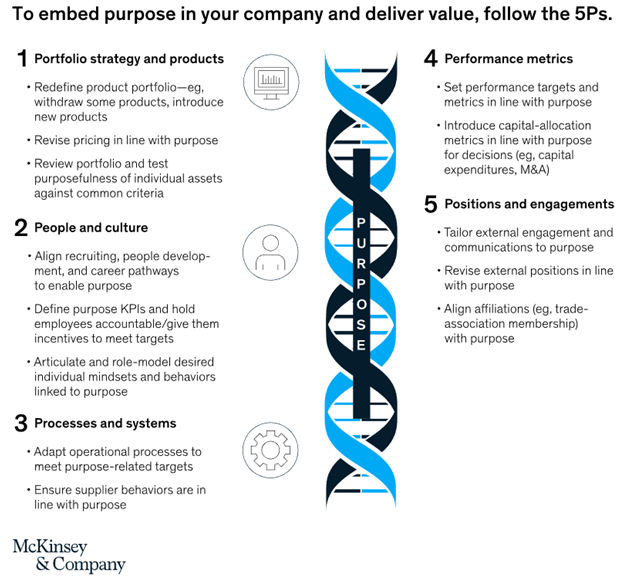
Over time, these five levers consistently increase purpose, but they must be diligently and frequently changed. Don’t fool yourself; there may be difficult choices to make and frequently difficult trade-offs as well. In every situation, begin by identifying the sources of your company’s strength and focus on its weaknesses. Then, programmatically develop your purpose infrastructure.
1. Portfolio strategy and products
There are two steps to demonstrating purpose in the goods and services you provide. First, check that the goals of your organization and your business portfolio are compatible. Almost all businesses can find ways to actively and purposefully modify their business mix, even though most won’t be able to start from scratch in terms of the markets and industries in which they compete. Second, after selecting your portfolio, fill out its businesses with goods and services that align with the goals of your firm and eliminate those that don’t. Avoid approaching your mission with an attitude that says, “This is the hand I’ve been dealt.” Of course, the endowment of your business counts, but you have more freedom than you may think in deciding what your business does and how it can contribute to society.
Think of bp. Since its establishment in the extractive industries more than a century ago, the erstwhile British Petroleum has been an energy firm. However, bp has continued to rethink what an energy firm may be despite being restricted by its past. The company has made a sharp pivot, adopting “reimagining energy for people and planet” as its mission; it has not only exited its petrochemicals businesses but also announced a plan to significantly scale up its low-carbon energy businesses (such as bioenergy, hydrogen, and electric-vehicle charging) and shrink its legacy oil and gas businesses by 40% by 2030. This will put the company on a path to becoming a net-zero carbon emitter by 2050 or earlier.
2. People and culture
People and culture may just as easily be regarded the first lever for embedding purposes as they are the second. Human beings are the source of purpose. Your supporters—all of your stakeholders, in fact—are your sources of strength and a strong deterrent to being untruthful. Employee emotion is thus frequently the most powerful factor undermining false claims of purposefulness. Consider organizations that are digitally native and have strong, “change the world” mission statements, but they nevertheless get called out for having “bro cultures” or for exploiting labor sourced from jail systems while marketing aspirational messages. In other instances, businesses that have promoted diversity have subsequently come under fire for discriminatory practices on the job.
Purposeful organizations embrace, rather than stifle, the human condition’s search for meaning. According to Mckinsey study, people at organizations with a purpose are four times more engaged at work, which is a significant source of competitive advantage. Think about Best Buy. The consumer electronics shop was changed by its former CEO Hubert Joly to a model where customer service, fueled by the human touch, would be the differentiator. Under his leadership, the business moved to heavily invest in employee training, offer employee discounts to encourage its own people to buy, use, and then recommend products to others, and advance Geek Squad, vivacious employees who assist customers in choosing, installing, personalizing, and supporting Best Buy products. That reaffirmed Best Buy’s mission to improve lives via technology and contributed to the company’s improvement in both customer and employee satisfaction.
Your employees can serve as your best progress indicators. Recent investigations into the banking sector are rife with instances of workers providing early warning signs of improper behavior, product misselling, and flawed product design. Many of these signs were either purposefully disregarded or received no attention. To effectively integrate purpose, you must make sure that your employees have the proper procedures and tools, supported by a “speak up” culture, to discover shortcomings.

Patagonia: We’re in business to save our home planet
The company’s dedication to protecting the environment and preserving the earth is shown in Patagonia’s mission statement. The creators behind the business think that using products that last for generations or can be recycled so the components in them remain in use is one of the most direct methods to reduce ecological problems.
The corporation supports hundreds of environmental organizations throughout the world by giving time, services, and at least 1% of its sales in the name of this cause.
Consider including in your mission statement both the value you hope to provide to a larger cause and the advantage you provide to customers if your firm has a comparable emphasis on expanding its business and giving back.
3. Processes and systems
Processes and systems, the third lever, tackles a fundamental “how” of your business model: the operational initiatives, rewards, and governance frameworks a company depends on to generate value and achieve its goals. To maintain (or start) the purpose engine running, you need reliable systems. Of course, certain factors will depend on the industry and the firm. Food companies, for instance, can find and buy healthier foods from farmers and more environmentally friendly packaging materials from packaging providers. However, most businesses may include best practices, from cafeteria composting to paid leave for community service, regardless of industry.
Your system and process initiatives should follow suit, with careful consideration of both the present and the future. Consider Microsoft’s approach to reducing carbon emissions. The company already worked to be carbon neutral (a goal it achieved in 2012), but has since set even higher goals: by 2025, Microsoft expects to use only renewable energy at its data centers, buildings, and campuses; and by 2030, the company plans to electrify its entire global campus operations vehicle fleet. By 2030, the company has declared it will be carbon negative. While some businesses track carbon to produce little but significant “carbon-adjusted” financial reporting, Microsoft already charges its business divisions an internal carbon fee. The money from the evaluation is invested in additional carbon-reduction initiatives within the company and donated to environmental causes all over the world.
4. Performance metrics
Purpose can and should be properly measured. In actuality, this entails establishing the KPIs that relate to the purpose of your business, monitoring them over time, and motivating your organization to achieve purpose-related goals. What is measured, as Peter Drucker famously said, is controlled. The opposite is likely even more accurate: whatever you want to manage needs to be assessed, and consistently. Companies mix purpose metrics with ESG criteria far too frequently. While necessary, ESG reporting standards from independent bodies like the Sustainability Accounting Standards Board (SASB) and the Global Reporting Initiative (GRI) should never become the “tail” that wags the purposeful company’s dog. The specific metrics you track and measure should be driven by your internal sense of purpose. Your business is approaching purpose backwards if it starts with ESG reporting and then “backs into” one.
Since purpose is who and what your company is, it should guide not only daily operations but also allocation choices like capital investments and M&A as well as company-wide transformation projects. For instance, a number of energy corporations now link executive compensation to emissions. To use another example, a major retail bank was implicated in a national scandal involving other financial institutions in the nation that involved various regulatory violations. The bank’s underlying mission, its relationships with the general public and with specific clients, and how to identify, assess, and enhance its purpose-based performance were all seriously considered as a result of the intense negative publicity. Improving customer outcomes was one of the goals.
Purpose can appear to be orthogonal, especially at the beginning of a purpose-focused effort, and it is reasonable to claim that this may have been the case in the past. However, purpose will feel more at ease if employees and other stakeholders are often presented with purpose-based metrics, such as the percentage of employees from underrepresented groups or contracts with minority suppliers or customers. It becomes accepted practice.
5. Positions and communications
What is true within your business should also be true outside of it: purpose should be ingrained in how your organization informs the public and interacts with them. Charges of “purpose washing” are most likely to surface within this “P,” which makes sense. Artificial purpose statements ring hollow, and stakeholders can tell when something is fake. Two-thirds of respondents to the Edelman Trust Barometer, for instance, agreed that “[a] strong reputation may encourage me to test a product, but unless I come to trust the firm behind the product, I will quickly cease buying it.” Additionally, more than half of respondents think that every brand has a duty to take an interest in at least one non-commercial societal issue.
A significant opportunity for many businesses to take a much more visible stand on the “S” aspect of ESG and reinforce their social license to operate is presented by the growing ascendance of the belief-based consumer. One approach to achieve this is to think about the trade associations your company supports—or possibly no longer ought to. For instance, Royal Dutch Shell and bp both conducted in-depth examinations of the groups they were supporting and finally withdrew from a number of trade associations because they were seen to be at odds with the goals of the companies. Another option is to increase corporate giving and philanthropy while integrating these initiatives into your business strategy. By doing so in an authentic manner that is connected to your company’s superpower and visible to people around you, you may fortify your company’s ties to the community and enhance your social standing. For instance, General Mills partners with its employees in the communities where they live and work to share food expertise through its 150-year-old philanthropic foundation. In addition, “Project Ugnayan,” a private-sector collaboration working with hundreds of local businesses to help feed millions of people in the Greater Manila area, is led by Philippines-based conglomerate Ayala Group.
Purpose bridges the gap between walk and speak by making your company’s stances, communications, and external engagement logical extensions of your business model. Purpose can provide your company a competitive edge, but it must be sincere and integrated into your company’s business strategy. The 5Ps offer a framework to assist businesses in systematically and comprehensively integrating purpose. It enables businesses to find valuable resources, spot weak spots, and profit from doing good. The secret to a successful expansion process is ensuring that all upcoming mergers and acquisitions fit within your culture and mission.

Exercise 1.6

Course Manual 7: Mapping Future State
Determining what you want to buy is the first step in programmatic deal sourcing. Often, it is simpler to say than to do. Diverse stakeholders have a variety of pressing strategic aims, alluring target companies, opinions about market shifts, and other inputs that together provide strong justifications for moving in different ways.
An M&A Blueprint must be created in order to bring clarity to the M&A Program and get everyone on the same page. It must specifically state how M&A will support business strategy and direct methodical transaction sourcing. Iteratively analyzing corporate goals, determining which goals can best be met through M&A, and selecting the right companies to purchase are all steps in the process of creating an M&A strategy
Key considerations to go through:
1. Market trends – how are customer preferences, competitors evolving
2. Future state – desired future offering, capabilities and financial results
3. Bottlenecks – things that are difficult, risky or slow to achieve organically
4. M&A feasibility – if/where M&A is the best way to achieve the results
5. Ideal target profile – the kind of companies we would like to acquire
Finding the important parties to involve in the process is the first step. The CEO, business line/unit heads, and occasionally members of the senior leadership team are included in this.
Market Trends
It is advised to examine important organic growth bottlenecks first, then market trends and the desired future state (Offering, Capabilities, and Financial Results), before concluding with M&A feasibility research and creation of the ideal target profile.
It’s important to record the unprocessed responses and opinions, summarize them, and share the summaries with the important stakeholders at each stage, whether you collect these inputs through one-on-one interviews, surveys, or strategy workshops.
Some of this data may have already been continuously gathered for product management or general strategic planning. This offers you a head start, but it’s a good idea to talk about and question the prevailing presumptions as well.

Case Study: Nokia
Nokia was the first company in the world to build a cellular network. Nokia was the global leader in mobile phones in the late 1990s and early 2000s.
How they failed to innovate: The corporation misjudged its brand’s strength and assumed it could enter the smartphone competition late and still win. Nokia ultimately chose to compete with Android in 2008, one year after the first iPhone was released, but it was too late. Their products were insufficiently competitive.
Consider that you are the M&A vice president of the imagined DentX chain of dental offices. Following discussions with the CEO and SVP of commercial operations and distribution of a survey to regional managers, the following (simplified) main market trends can be outlined:

Future State
Based on this assessment of market trends, we work with the key management team to create a new vision for the future of what DentX’s offering to customers should be like and the capabilities required to provide that experience. The CEO also makes it very apparent that a major financial objective is to speed up our revenue growth from 12% to 30% because doing so would result in a premium valuation for growth companies if we ever choose to go public through an IPO.
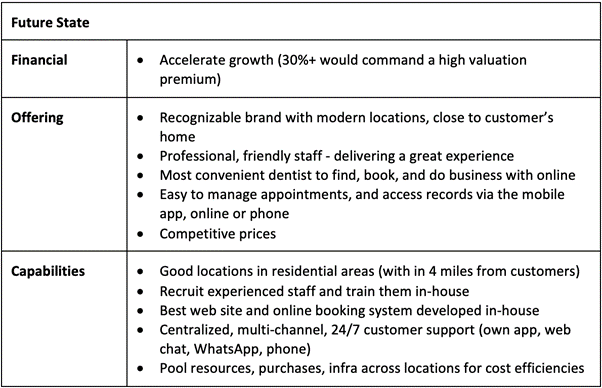
In order to complement the analysis above, it is a good idea to look at the suggested acquisition targets in order to reverse engineer the desired new offerings and capabilities from those. This is especially useful if you already have an M&A pipeline full of different acquisition ideas suggested by the stakeholders.
DentX is already well ahead of most rivals when it comes to web marketing, having an online reservation system, and having a 24/7 customer service center because it is a mid-sized chain of 30 clinics with a web-savvy CEO. There is a competent internal team devoted solely to that. Finding suitable locations for new clinics, procuring licenses and contractors for necessary repairs, and employing qualified personnel appear to be major bottlenecks.
These are where we get our replicable strengths and growth bottlenecks.

This sounds like a chance for value generation through mergers and acquisitions! By rebranding them (with our well-known brand), utilising our web marketing engine, integrating them into our online reservation system, pooling resources, etc., we might purchase tiny clinics in desirable areas and add tremendous value. essentially building on our transferable strengths.
To further refine the ideal profile for companies to purchase, an examination of the risks and problems associated with acquiring this kind of companies should be used. For instance, past M&A deals or common sense may indicate that integrating multi-clinic chains would be more challenging than integrating single-location clinics. Additionally, clinics located in markets with multiple competitors (from which to gain market share) have higher revenue potential than those located in markets where there is only one competitor.
An illustration of hazards or problems found when purchasing dental clinics:

M&A Themes
We can determine our main M&A Themes from the aforementioned analysis. This includes what skills we are gaining and the kinds of businesses that are most qualified to provide that value (at a high level):
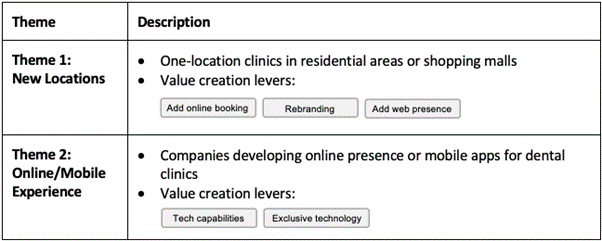
We can immediately spot value development possibilities and categorize potential organizations based on relevant levers by identifying the major value creation levers:
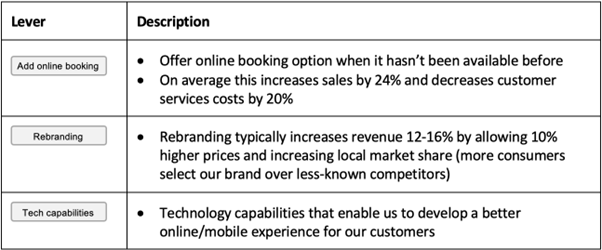
We must ascertain how well these topics match M&A on the basis of this
M&A Feasibility
Even if we may have a strong desire to own certain businesses, it may not be prudent for us to do so. Unrealized value creation potential that has not been completely taken into account in the company’s valuation must exist. Each subject needs to be examined to determine whether it can be used to create value through mergers and acquisitions.
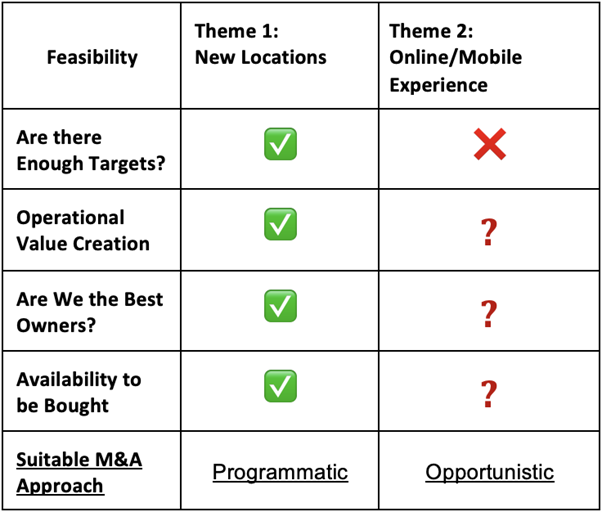
Key considerations for M&A feasibility analysis:
● Are there enough potential, suitable acquisition targets
● Can we create enough value to be the best owners/acquirers for these companies
● Are enough companies likely to be available to be bought
The acquisition of new locations works well as an M&A theme in our example because there are many available suitable targets, there are obvious operational value creation opportunities, the targets are more valuable to us than the market values them at, and many of the targets are probably available for purchase. This implies that we can use a programmatic way to repeatedly obtain and integrate them. Finding this type of opportunity and scalable model can make M&A a key component of the growth strategy for the entire business.
On the other hand, there aren’t many businesses creating the technology that will allow dental clinics to provide online services, and those that do are probably more profitable when they sell the technology to numerous customers. Therefore, while we will keep an eye on such entities and may strike a transaction when the time is right, acquiring such businesses is not a model that can support our M&A strategy in the long run.
The programmatic strategy, as opposed to the opportunistic method, allows for a high degree of predictability in terms of financial projections and expansion through M&A.
Example of a dashboard comparing opportunistic deals vs programmatic M&A:
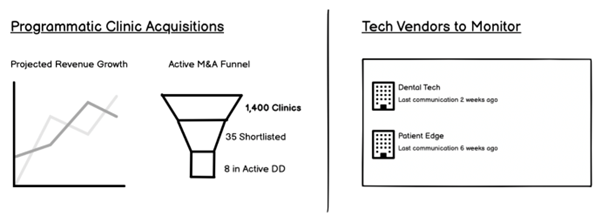
An example of a written feasibility analysis for the theme “New Locations”.
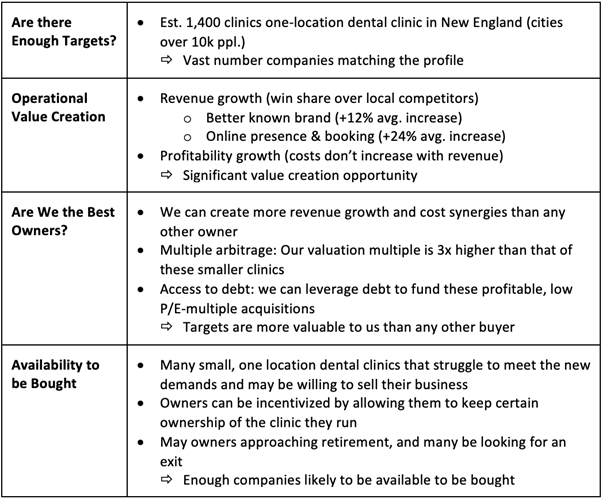
M&A Program Why, How, What
Finally, this enables us to sum up the high-level goal (why), methods of adding value (how), and what we acquire for our M&A Program.
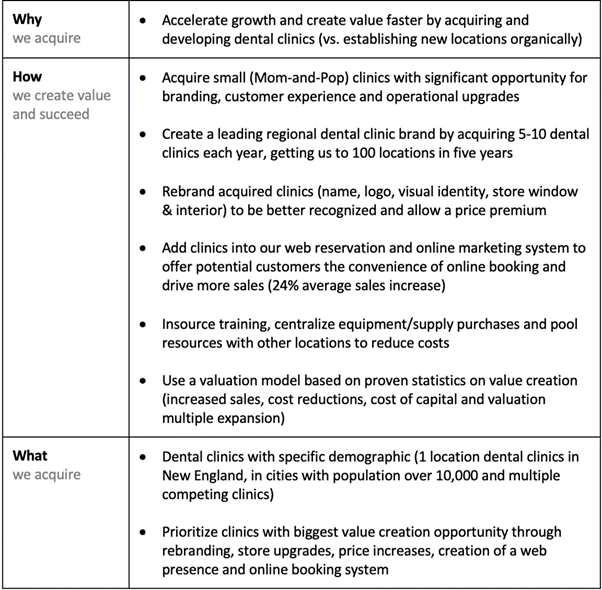
Ideal target profile
An ideal target profile outlines the precise characteristics of the type of business we are looking to acquire. The profile ought to outline the most important qualities as well as the allowable range of deviation. Deal sourcing uses this profile to identify such businesses and assess possible targets. We can even create a target score system for evaluating target fit objectively when we have a clearly defined ideal target profile.
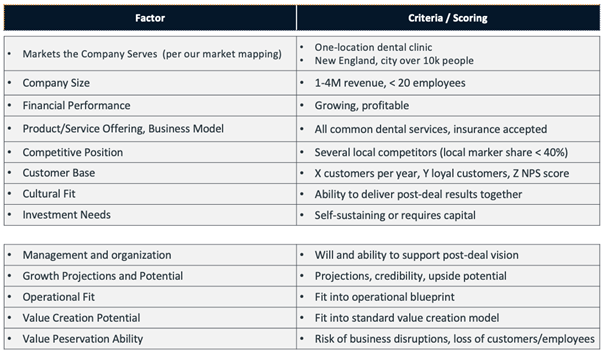
Conclusion
Programmatic M&A and the overall success of an M&A program depend on having a clear M&A Blueprint. It gives you the ability to standardize every aspect of your deal sourcing, due diligence, and integration strategy in a way that is scalable and yields the most predictable outcomes. The most effective business development strategy to increase shareholder value has been demonstrated to be programmatic M&A, developed on a clear Blueprint.

Exercise 1.7

Course Manual 8: Set Department Objectives
Employees are frequently motivated to aid a business in achieving its aims through workplace objectives. A subtype of workplace objectives, departmental objectives can also include individual or team goals while still contributing to the organization’s overarching goals. You might want to read more about the factors to take into account to make the objectives for your department effective before creating them. We go over what departmental objectives are, how to write them, how they differ from team objectives, and give examples of them from various industries in this course manual.
What is a departmental objective?
An endpoint that you want your department to achieve is known as a departmental objective. These goals could be a smaller component of a bigger organizational or departmental goal. Objectives can be precisely defined and measured. You can quickly evaluate whether a department is meeting its objectives since they are measurable.
Departmental objectives enable you and your department to define your expectations in addition to offering predetermined success markers. When you consistently have a set of goals in mind, you can frequently decide what to do in novel or ambiguous circumstances. This is due to the fact that your ultimate goal is to constantly strive to accomplish your aims. If you find that specific departments are lagging behind in particular areas and that prior strategies haven’t worked, you can think about acquiring another company to introduce you to new and more strategic approaches to handling various circumstances.
Departmental objective vs. team objective
Because a team is a subset of a department, department objectives can influence team goals. This indicates that teams are ultimately working for the same departmental objectives even though they may have diverse work focus areas. For instance, a health clinic’s quality control division would aim to raise patient satisfaction by 10% based on survey results. Teams focusing on decreasing patient wait times, enhancing healthcare workers’ bedside manners, and enhancing facility cleanliness may exist within this department. Although these teams have various goals, their overall goal is to increase patient happiness.
Important considerations for developing departmental objectives
When establishing the goals for your department, take into account the following:
Understand the organization
Departmental objectives typically support the goals and development of an organization, much as various team goals might assist a department’s goals. Understanding the organization’s general objectives is crucial to ensuring that the departmental objectives complement those of other departments and advance the organization’s overall aims.
Additionally, being aware of the organizational structure might be useful when considering outside influences that might affect the goals of your department. It would be helpful to know what other teams and departments are accessible to help with when sourcing materials and producing your prototype, for instance, if you’d want to create a departmental aim to design and test a new prototype.
Understand the industry
It can be beneficial to take into account what other businesses in your field are doing, as the goals of your department typically support those of the organization. This is due to the possibility that those outside companies will collaborate with or compete against your business.
It can be useful to know how successfully other companies in your field sell to the same customers if, for instance, you want to set a goal to sell a particular number of products to a new customer demography. Because you’ve never sold to this customer base before, you might expect a quick increase in sales. Alternatively, you might think that a rival is already a major player in the market, in which case you might decide to change your goals. You might choose to merge with or buy a business that already dominates this market, etc.

How McDonald’s dominates the fast-food industry
One of the largest fast-food chains in the world is McDonald’s. McDonald’s routinely uses market and industry research to satisfy its customers in order to maintain its dominance in the fast food sector.
In their market research strategy, McDonald’s uses the following four essential questions:
1. Which products are performing well?
2. What prices are most affordable for the consumers?
3. To effectively advertise, what are consumers reading and watching?
4. Which restaurants are most attended, and why?
These inquiries will allow McDonald’s to determine whether or not its client base is growing.
If not, it modifies its approach to satisfy customers and perform better than its rivals.
McDonald’s also solicits user input to modify their product offerings.
For instance, several McDonald’s customers expressed worry about the lack of organic and nutritious food options on the menu.
As a result, McDonald’s introduced nutritious foods to the menu, such as apple slices, after considering the input. It even started a marketing push to show that the chicken in its nuggets and patties is real meat.
Use SWOT to brainstorm objectives
SWOT analysis can be used to find areas with the potential for development and expansion that could make for worthwhile departmental goals. Finding your department’s strengths, weaknesses, possibilities for development or improvement, and threats to success is the goal of a SWOT analysis. You can create a list of goals for the people or teams in your department to work toward after doing a SWOT analysis.
Use SMART when describing your objectives
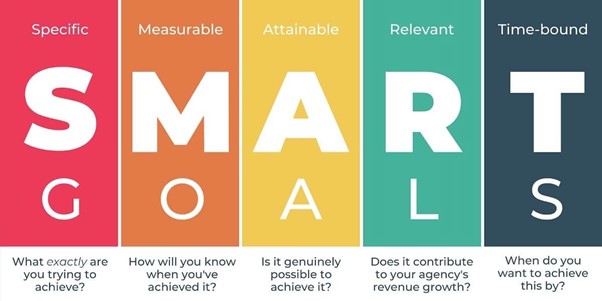
You can frequently test your objective using the SMART model to make sure it’s a suitable fit for your department. Following the SMART guidelines, each departmental goal comprises the following:
Specific: This implies that you make the goal very apparent. A target like “sell more shirts this year” is less specific than “raise profit from sales of green sweatshirts by 15% by October 1.”
Measurable: To do this, you must be able to quantify your outcomes. Sell more shirts doesn’t have a clear definition of success, however increasing sales profit by 15% is a measurable goal that the department either hits or misses.
Attainable: In other words, the department can realistically accomplish the goal. For instance, increasing profits to 15% may not be feasible if they have historically climbed by 0.5% per quarter, but if they have increased by 12% in the most recent three quarters, 15% or more may be feasible.
Relevant: This entails establishing a purpose that is significant to the department as well as the organization overall. Increasing sweatshirt sales earnings in a company that specializes in garment sales is perhaps more important than concentrating on growing the company’s shoe line.
Time-bound: This indicates that the goal must be accomplished by a certain date. This is crucial because it frequently inspires the department to work hard to achieve the goal and gives a deadline to judge whether or not department members succeeded in achieving the goal.
Consider both short-term and long-term goals
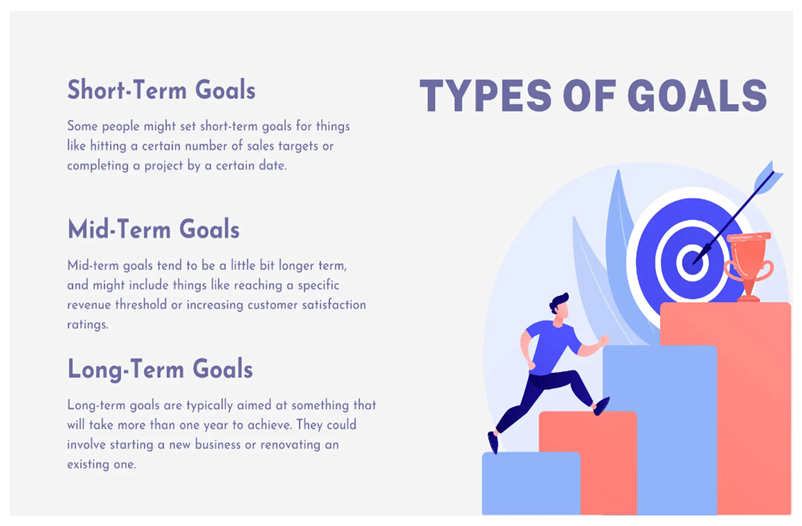
It can be beneficial to consider the organization’s overall needs for the current quarter or year as well as the next five or more years while creating departmental targets. While certain goals can help advance toward longer-term growth and achievement, others can concentrate on more pressing requirements. For instance, a short-term departmental goal would be to convince two big stores to carry and market the company’s cushions. Finding and evaluating potential locations for a new manufacturing plant can be a goal with a longer-term emphasis if the organization expects to start producing and selling mattresses.

Amazon’s emphasis on long-term objectives:
The founder of the company, Jeff Bezos, resigned from his position as CEO in July 2021, exactly 27 years after Amazon was incorporated on July 5, 1994. He now serves as Executive Chair. Andy Jassy, the longtime CEO of Amazon Web Services, the company’s wildly successful cloud division, succeeded Jeff Bezos, whose ownership in Amazon made him the richest man alive. When announcing his resignation, Bezos said, “When you look at our financial outcomes, what you’re truly seeing are the long-run cumulative consequences of invention.” “At the moment, I think Amazon is at its most creative ever, making this transition the best time ever”.
On July 16, 1995, a little-known Seattle company created a website boasting that it was the “earth’s biggest bookstore,” more than 25 years ago. Although that might have sounded a little arrogant at the time, two and a half decades later the aforementioned company, Amazon, is not just the largest bookstore on the planet but also very possibly the largest retailer overall.
If Bezos has become (in)famous for anything during his tenure as CEO, it is his unwavering commitment to long-term success. Bezos has long ignored his detractors, but his decision to forego short-term gains in favour of long-term growth has paid off handsomely, turning Amazon into a trillion-dollar business and earning him the world’s richest man.
Amazon has developed a market-leading cloud computing business under Bezos’ direction, solidified its position as the top online retailer in many regions of the world, and become a significant force in digital media and consumer technology. All of that was made possible by the corporation by diligently reinvested most of its earnings until eventually the profits were too high to spend. If the financial performance of Amazon truly represents “the long-run cumulative results of creation,” then there must have been some worthwhile discoveries along the way.
Set a reasonable number of objectives
Three to five departmental goals are typically a decent number to set. Consider making your key endpoints your objectives rather than developing goals for every phase of a process or your everyday tasks. In this manner, any group or person can choose the method of achieving the goal that works best for them.
Departmental objective examples
Here are seven illustrations of objectives for various departments:
● For a museum’s fundraising division: Raise $250,000 in charitable contributions before to the start of a new exhibit’s construction in six months..
● For the human resources division of a chain of supermarkets: By the end of the year, source 45% of the managerial staff through internal promotions.
● For the curriculum division of a school district: nine months before the start of the next school year, choose new fourth-grade textbooks.
● For the technology division of a city library: Create and release an app within a year that will allow users to rent books digitally.
● For the adult cat adoption division at an animal shelter: Raise adoptions by 10% during the following three months.
● For a clothing retail chain’s design division: At the next board meeting in six months, suggest three fresh showroom layouts.
● For the delivery division of a private postal delivery service: Cut damaged package rates by 10% in four months.

Exercise 1.8: The Winning Lottery Ticket

Course Manual 9: Prioritizing Tasks
How to break down projects into tasks
Here are five steps you can follow to break down a project into smaller tasks:
1. Identify the project
Reviewing this possible acquisitive growth business assessment’s specifics, including its goals and important components, is the first step in splitting a project into smaller tasks. Once you have a complete understanding of the project, you can start compiling a list of the tasks that must be accomplished.
You can divide jobs in a variety of ways, depending on the sort of project, including portions, phases, by time, by subject, or by complexity. To avoid forgetting any tasks while working on the project, it may be helpful to undertake a final check of your project’s specifics before you start the identification process.
2. Prioritize tasks
Consider creating a prioritized list of the tasks you’ve discovered after that. Try to make a spreadsheet or use a task management smartphone app to arrange your tasks in chronological order after determining each priority. Keeping the above in mind, prioritize tasks as follows:
• Some tasks may require more time than others to complete.
• Certain tasks might be more critical to the overall success of the project than others.
• It’s often essential to complete certain tasks before starting new ones.
• Some tasks may require more attention to detail and focus than others.
3. Create a schedule
Calculating how much time you have to work on a project is useful when making a schedule. Consider previous projects you’ve worked on that featured comparable activities when attempting to estimate the time it could take to finish each one, or seek opinion from peers on time estimates. When making your schedule, it could be useful to take unforeseen setbacks or adjustments into account.
Planning your project backwards in time, starting with the deadline and allotting a time frame for each day you might need to finish the project, may be advantageous. Setting aside time to check for faults and make required corrections is also beneficial.
4. Set milestones
Setting up milestones will help you monitor how close your project is to being finished in relation to your deadline, depending on the size of your project. Consider dividing your responsibilities into monthly, weekly, or daily milestones for larger projects. Each milestone can be specified in terms of a project’s many phases or classifications.
For instance, if you’re working on a project that requires you to create a slideshow presentation for stakeholders, it can be useful to establish a deadline for finishing that presentation and track your progress toward finishing the project as a whole as you complete each job. This may increase your motivation and assist you in keeping your focus.
5. Adjust tasks
It’s critical to recognize when problems develop or whether a task is taking longer than anticipated because projects might change as they advance. Before a project starts, it can be helpful to identify potential obstacles and designate a backup plan for each. Try to stay proactive by recognizing the issue and resolving it as soon as possible when issues emerge or priorities change. Although you can’t always prepare for unforeseen events, you can estimate how long it will take for a setback to be resolved when you are first planning.

Why break down projects into tasks?
In order to increase production, it is crucial to divide up the jobs inside a project. Procrastination can be overcome by segmenting a project into tasks. Since not all projects entail the same duties, setting priorities appropriately is frequently beneficial. You can meet deadlines while still delivering high-quality work using this technique. Here are a few strategies for segmenting different task types:
Break down in phases
People who work in the software development industry, for instance, can benefit by breaking a huge project down into parts. This enables these experts to successfully complete each stage of a project and meet their deadlines on schedule. For instance, a software development project’s life cycle often entails working in a number of phases, including requirement gathering, software design and development, integration and testing, deployment, and maintenance. After you have evaluated each stage, you can identify your department’s weak points and start to determine where an acquisition or merger might be advantageous.
Break down into categories
What is the Eisenhower Matrix?
The Eisenhower Matrix is a productivity, prioritization, and time-management paradigm that enables you to prioritize a list of tasks or agenda items by first classifying them based on their relevance and level of urgency.
This method, also known as an Eisenhower Decision Matrix, Eisenhower Box, or Urgent-Important Matrix, involves creating a four-box square with the axes Urgent and Not Urgent and Important and Not Important on the y-axis. After that, arrange your list of items into one of the four boxes, with the Urgent-and-Important box in the upper left necessitating that you take urgent action.
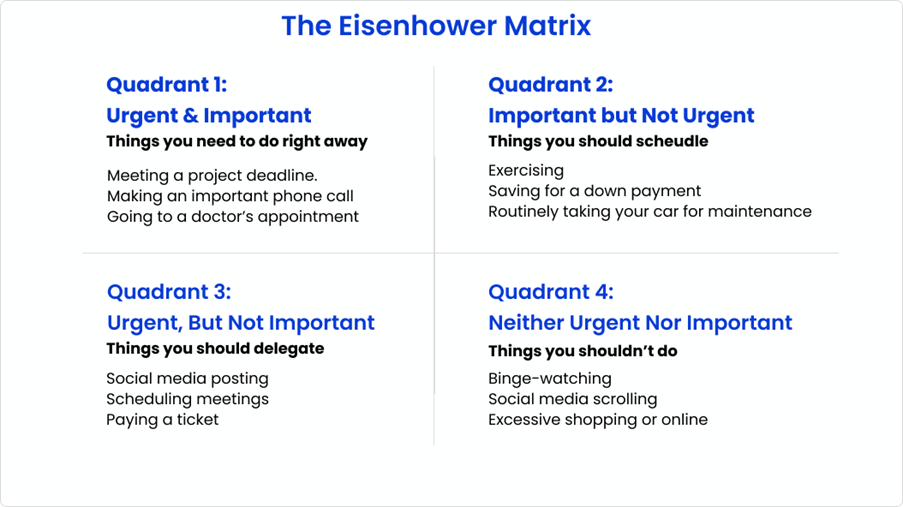
1. Urgent and important
Look over your list of tasks and mark the ones that are most urgent and important. Try to identify three to five tasks that must be accomplished immediately since they are so urgent. Try posing these queries to yourself if you need assistance: What must you do immediately? What tasks must be completed within the next 24 hours?
Consider the obstacles preventing you from moving on to the next phase of your business acquisition assessment. What has to be done in order for you to receive more information or be able to act?
Things that are so crucial that finishing them first prevents you from doing anything else should be on this list of tasks.
2. Time sensitive but less important
Next, go over your to-do list and choose the items that, while time-sensitive, aren’t as vital as the first three to five “urgent and important” jobs. These tasks still need to be completed in order to reach your objectives, and they have a set time frame. Try to limit this second group’s activities to seven to ten.
When creating this list, it’s important to steer clear of “busy work” in general. To prevent burnout and free up time for strategic, higher-level operations, this type of activity should be delegated or automated as much as possible.
3. Important but not time sensitive
Even though they may necessitate more time and effort than those urgent and crucial tasks, these tasks are equally as significant as those in the first group. This could entail revising your business plan, creating a plan for launching a new product, or making plans to hire additional personnel.
4. Not important and not urgent
This collection of jobs should be regarded as “like to have” tasks. While it would be good to find time for these, they are not necessary for success.
Whatever method you use to carry out your daily responsibilities, prioritizing what is most essential to you can help you gain a deeper understanding of how you operate and how you may improve your effectiveness.
Break down in parts
For more generic activities, like cleaning a house, breaking projects down into segments might be useful. This enables you to efficiently clean each room in your home. For instance, it could be helpful to divide a cleaning effort into phases, starting with the biggest or messiest rooms first, moving on to smaller or less dirty areas, and concluding with minor cleaning duties throughout the entire house.

Tips for breaking down projects into tasks
Here are some tips you can follow to effectively break down a project into smaller tasks:
Avoid overlapping tasks
Compare each step in your timetable and think about whether you can combine any steps to prevent having tasks overlap. Additionally, focusing on and finishing one task at a time is beneficial. When one work is finished, think about beginning another. Step by step completion of each assignment might assist you avoid confusion or mistakes in your work.
Reward yourself
After finishing a task or reaching a goal, it can be beneficial to treat yourself. Giving yourself and your team rewards can increase confidence and spur you on to complete the next task or milestone. Another way to feel relieved is to physically mark off each work that has been accomplished on a project’s schedule.
Use technology
There are many task management software packages available to make the process of finishing a project easier, even though you can manually generate spreadsheets or outlines. Software for managing tasks is available as desktop versions or apps for smartphones. To find free or inexpensive task management software, think about doing some web research.

Case Study: Focusing on what’s important
A radio host – an older man, was speaking on air to a listener called Tom, and was telling a story in which he named “A thousand marbles”.
“Well, Tom, it sure sounds like you’re busy with your job. I’m sure they pay you well but it’s a shame you have to be away from home and your family so much. Hard to believe a young fellow should have to work sixty or seventy hours a week to make ends meet. Too bad you missed your daughter’s dance recital.”
He continued, “Let me tell you something Tom, something that has helped me keep a good perspective on my own priorities.” And that’s when he began to explain his theory of a “thousand marbles.”
“You see, I sat down one day and did a little arithmetic. The average person lives about seventy-five years. I know, some live more and some live less, but on average, folks live about seventy-five years.” “Now then, I multiplied 75 times 52 and I came up with 3900 which is the number of Saturdays that the average person has in their entire lifetime.
Now stick with me Tom, I’m getting to the important part.”
“It took me until I was fifty-five years old to think about all this in any detail”, he went on, “and by that time I had lived through over twenty-eight hundred Saturdays. I got to thinking that if I lived to be seventy-five, I only had about a thousand of them left to enjoy.”
“So I went to a toy store and bought every single marble they had. I ended up having to visit three toy stores to round-up 1000 marbles. I took them home and put them inside of a large, clear plastic container right here in the shack next to my gear. Every Saturday since then, I have taken one marble out and thrown it away.”
“I found that by watching the marbles diminish, I focused more on the really important things in life. There is nothing like watching your time here on this earth run out to help get your priorities straight.”
“Now let me tell you one last thing before I sign-off with you and take my lovely wife out for breakfast. This morning, I took the very last marble out of the container. I figure if I make it until next Saturday then I have been given a little extra time. And the one thing we can all use is a little more time.”
“It was nice to meet you Tom, I hope you spend more time with your family, and I hope to meet you again here on the band.
You could have heard a pin drop on the band when this fellow signed off. I guess he gave everyone a lot to think about. One listener rang afterwards and said they had planned to work on the car that morning, and then was going to meet up with a few colleagues to work on a not-so-important work task. Instead, they went upstairs and woke their wife up with a kiss. “C’mon honey, I’m taking you and the kids to breakfast.”
“What brought this on?” she asked with a smile.
“Oh, nothing special, it’s just been a long time since we spent a Saturday together with the kids. Hey, can we stop at a toy store while we’re out? I need to buy some marbles.”

Exercise: one, a few, a lot

Course Manual 10: Set KPIs
The truth is that numbers matter no matter where you work in today’s data-driven environment. The use of key performance indicators, or KPIs, is one of the most popular methods for interacting with data and figures.
Key performance indicators, or KPIs in their full form, are quantifiable values that show how successfully a business is fulfilling its main goals.
KPIs are crucial because they provide a benchmark against which to measure your performance going forward. KPIs make it obvious whether or not you are succeeding in your objectives.
By using KPIs, you may define objectives, plan a course of action to achieve them, and assess your progress as you go.
Differences between OKRs and KPIs
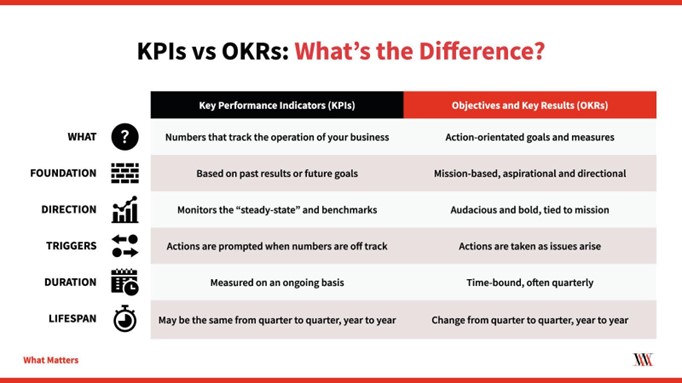
OKR is a framework for setting goals. Each OKR has a goal that must be accomplished as well as a set of metrics called key results that will gauge success in achieving the goal.
KPIs identify the elements required for success in an organization.
Let’s now examine more closely how these two ideas interact:
OKRs encompass KPIs
Consider that acquiring new clients is one of your objectives. You might obtain the important outcome: By the end of Q1, increase the acquisition of new customers by 50%.
Because “new customer acquisition” is the KPI for this particular KR, we stress it. One aspect that could impact your business’ success is new client acquisition.
Here are some additional OKR examples:
● For Q1, raise gross profit margin to 30%. Gross profit margin is a KPI.
● In Q3, raise business revenue to $5M. (KPI) (Company revenue)
As you can see, KPIs are inextricably linked to KRs.
In light of the foregoing, there are a few general ideas that you might wish to bear in mind when using OKRs and KPIs.
Not all of your KRs will include numbers
You could find that some KRs don’t explicitly include a KPI or metric. You’re more likely dealing with a milestone goal in this situation, such as releasing a new marketing system or any other similar ideas that can be evaluated on the basis of completion but are unrelated to a specific figure. In those circumstances, the milestone target is still a crucial step that will ultimately help the KPIs succeed.

Acquisition KPIs: The Right M&A KPIs and metrics to prevent failure
Challenges and complexity are typical characteristics of mergers and acquisitions. That’s just how the game works. Business has always involved mergers and acquisitions, but they did not become commonplace until the end of the 19th century, when an intense period of mergers and acquisitions known as the M&A waves occurred.
Mergers and acquisitions have changed from being primarily a US phenomena to being a defining characteristic of businesses across a variety of industries and geographies as a result of the M&A waves. And despite this growth, there is still a lot of misunderstanding about M&As. Evidence also shows that M&As rarely provide positive results because it has always been highly challenging for firms to execute them successfully.
Which raises the question, “Why do they at all?” Businesses continue to welcome M&A despite the contradictory facts, indicating that there is something to benefit from a successful M&A. Some mergers are necessary to tap into emerging demographic or geographic markets, broaden the range of available products, increase productivity, and make it easier to hire key executives like COOs and CEOs.
M&As typically occur to take over a competitor company or carry out long-term plans. Whatever the motivation for an M&A, it is crucial to measure the process in order to determine whether or not the intended business objectives were satisfied. KPIs, or key performance indicators, play a role in this. KPIs are quantifiable, enabling a business to assess its success or failure.
Because of this, organizations need to set up a number of clear objectives before every M&A. The KPIs that are created will specify the optimum performance outcomes anticipated from the M&A process.
So what are the metrics against which M&As are measured? How can success be measured when it comes to M&A?
When it comes to M&A, there are many different ways to gauge success. Whatever the strategy, there are a few crucial issues that must be resolved before success can be assessed. For illustration:
What metrics will your organization use to measure M&A performance?
The effectiveness of M&A can be evaluated in various ways. Even though there is no one solution that works for all firms, most have been known to use metrics like share price to gauge performance. Accounting actions like sales, profit totals, ROI, or ROA are some more often utilized metrics.
Over what time frame will M&A performance be assessed?
Most firms use short- to long-term windows that can last many days or years after a deal to gauge success when dealing with stock metrics.
Whose performance should be measured, the acquiring or the selling party?
It is crucial to remember that anytime an M&A occurs, the two parties entering the deal have different, perhaps even incompatible expectations. The targeted performance will target the 2 parties in different ways depending on the strategic justification that drove the transaction in the first place. This is due to the possibility that the acquirer’s definition of success may differ from the seller’s.
How will the acquisition’s performance be captured once the deal is finalized?
It could be challenging to isolate the purchased firm’s operating performance inside its new reporting structure once the deal is closed and the acquired business has become an integral part of the buying firm’s organization. The acquiring organization then needs to figure out how to gauge the acquired party’s post-deal M&A performance. Otherwise, it won’t be possible to identify what has to be changed or added in order to ultimately increase performance.
Common KPIs used commonly during M&A
KPIs for one business’ merger and acquisition will be very different from those for other businesses’ M&As, as was previously mentioned. Some KPIs might be more useful in certain industries than in others. For software organizations like app developers, monthly active users is a typical KPI, but it might not be helpful for, say, a manufacturing firm.
Knowing the appropriate KPIs for your M&A will offer you an advantage when it comes time to assessing the performance of your present endeavour. You should be familiar with a few typical KPIs, including:
Customer acquisition cost
The amount spent on sales and marketing to bring in a customer is referred to as the cost of customer acquisition. The percentage of customer acquisition costs will show how effective your marketing campaign was.
Customer retention rate
For the majority of firms, recurring business is essential. A company with a high client retention rate often offers a high-quality good or service, as well as an efficient customer care system.
Profit margin
A company’s long-term sustainability should be questioned if its profit margin is low or declining. A company with low margins is more likely to see a decline in sales or have a small market share. As a result, a company needs to be aware of how its profit margins compare to its revenue figures.
Overhead costs
Rent, insurance, utilities, and other fees of this sort are examples of overhead costs. Overhead costs are a crucial KPI to monitor because they reveal a company’s efficiency.
Employee turnover
One of those non-financial KPIs that shows how well a company is run is employee turnover. It may be essential to change the personnel policies that are ineffective if a company is thinking about M&A with a high turnover company.

Case Study
This video highlights what can be achieved by tracking just one KPI, in a supply chain operation

The 10 biggest mistakes companies make with KPIs
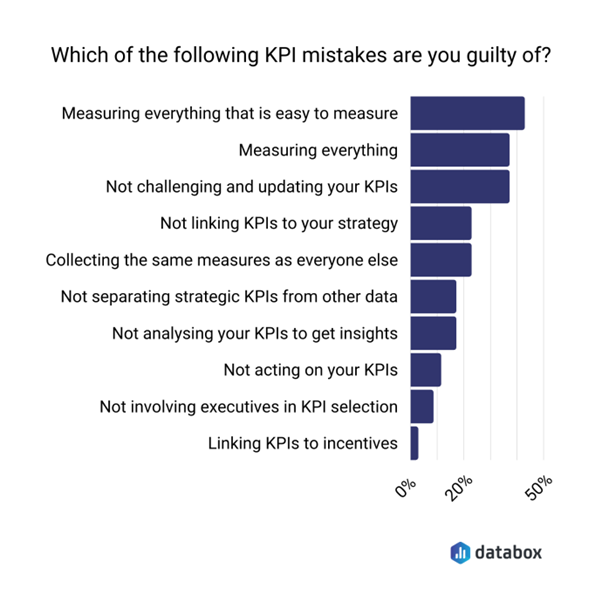
1. Not linking KPIs to your strategy
KPIs are only truly helpful if they support your plan and assist in making strategic decisions. Anything else is only decorative. You waste a ton of time and money collecting data that won’t help the business when KPIs are not connected to your plan.
If KPIs provide mission-critical data that is pertinent to your company’s operations, they are beneficial. Therefore, once you are aware of the goals you are working toward for your company, you should use those goals to guide the selection of the pertinent KPIs.
2. Measuring everything that is easy to measure
Sadly, there is frequently a discrepancy between what can be assessed and what should be measured. Consequently, measuring everything that is simple to measure, regardless of its importance to the business, is one of the major mistakes that people make when using KPIs.
3. Measuring everything that walks and moves
Assuming that a lot of information is preferable than none, there is also a temptation to measure anything that moves and walks. In actuality, too much knowledge can be just as useless as not enough. Additionally, it can seriously harm the company by squandering time, resources, and attention that would be better used elsewhere.
4. Collecting the same measures as everyone else
Another common mistake is for employees to create their KPIs by analyzing what other people are measuring. Consequently, a business leader may decide that KPIs are something she needs to take seriously but, rather than determining what data she actually needs, she will look at competitor businesses or perhaps discuss KPIs with other senior executives in order to compile a list of KPIs that everyone else is using.
This may also occur if a specific KPI or measure becomes widely used in leadership publications. You don’t necessarily need those KPIs just because everyone is talking about customer satisfaction surveys or employee engagement surveys. Your approach is the only factor that will determine if you invest in these kinds of measures.

5. Not separating strategic KPIs from other data
The majority of firms have an abundance of data and information, ranging from financial and sales data to customer and compliance data. The issue is that all the KPIs are frequently bundled together in one lengthy KPI report or confusing dashboard. Business decision-makers don’t have the time to sift through endless pages of KPIs to find the ones that are truly important. As a result, amid a sea of unimportant information, the ones that could actually guide strategy and enlighten decision-making are lost.
6. Hardwiring KPIs to incentives
In business, tying KPIs to rewards (such bonuses or salary raises) can be extremely risky because unintended consequences are so simple to produce. The real goal of a KPI is to inform internal stakeholders about where they stand in respect to where they aim to be. On a sea cruise, they serve as a compass. But as soon as those KPIs are connected to rewards, they stop serving as a tool for navigation and start serving as a benchmark that must be met in order to qualify for a bonus. And as soon as that occurs, those involved can start coming up with extremely original ways to manipulate the data or their behavior to make sure they get the reward.
7. Not involving executives in KPI selection
Designing certain KPIs may be of interest to those who are interested in numbers (the finance director, for instance), but most executives are not. Senior executives work on the strategy as a result, but assign someone else the task of choosing or creating the appropriate KPIs.
This is incorrect. Senior executives will not feel ownership of what is created if they are not involved in the KPI decision-making process. They won’t use the KPIs if they don’t feel like they own them. It is crucial that the senior team consider the KPIs, discuss the issues they are trying to resolve, and approve the KPIs they have selected. This makes sure that the strategy, the KPIs, and the questions those KPIs will answer are all connected in a strong, clear, and understandable way.
8. Not analyzing your KPIs to extract insights
Another typical error with KPIs is that no one within the company actually analyses the data to derive insights that are pertinent to the business. Nobody is analyzing the data to determine how it connects to corporate or industry benchmarks, how the statistic has evolved over time, or what it might signify for the firm.
Once more, this is frequently due to a disconnect between those making decisions and those who are reporting. The analysis is frequently conducted at lower organizational levels and reported to the top. Those at lower levels may only be providing the data; they may not grasp its importance. Additionally, individuals in charge handed off the design of the KPIs to others, so they are not responsible for how the data is shown. It’s crucial that someone with the appropriate authority examines the data and determines what it all really means for the company.
9. Not challenging and updating your KPIs
When the correct KPIs are chosen or created during the business assessment stage of acquisitive expansion, they are frequently never questioned or challenged in terms of their continued applicability, connection to strategy, or ability to assist the organization in addressing pressing issues. Make sure you are consistently gathering the appropriate data, doing it frequently enough, and using what you gather.
You should therefore not be averse to challenging your KPIs. If you don’t, it’s simple for KPIs to become into a “check box” exercise that allows managers to claim they have them rather than a real-time guiding tool that improves outcomes and performance. To ensure that you are only measuring what is actually necessary and that the KPIs are still relevant and in line with the new plan, you should review and update your KPIs whenever there is a change in strategy or corporate priorities.
10. Not acting on your KPIs
KPIs can influence strategy and support fact-based decision making within organizations, but only if those in the organization use them. Ultimately, if your KPIs aren’t used as intended, it doesn’t matter how well you linked them to your plan or even how well you captured and displayed the pertinent KPIs. You are wasting your time and energy if you aren’t leveraging your KPIs to guide your choices and motivate performance.
A well-crafted set of KPIs should give a clear indicator of current performance levels and assist your team in making decisions that will move the company closer to attaining its strategic goals. You can make sure your KPIs are created, implemented, and used exactly as they were intended to be used—to support the success of your business—by avoiding these 10 problems.

Exercise 1.10: Dog, Rice, Chicken

Course Manual 11: Create a Project Schedule
7 steps to create a project schedule
You should incorporate all project activities as you start to organize and create your project schedule. It’s typical for the project management scheduling procedure to seem a little odd to you at first. You can become more at ease developing your own method for developing project schedules by following these steps and using it each time you plan a project.
1. Set your project’s objectives. Note any important completion dates or deliverables that are necessary for this project to succeed.
2. Identify each participant. Make a list of everyone who must communicate with the project team, even if their only responsibility is to sign off.
3. Establish your ultimate deadline. Determine the deadline by which the project must be completed in full. When managing your calendar, make sure you include enough time to accommodate for conflicts or modifications that could occur.
4. List each action or duty. To make sure all of the bases are covered, take those milestones and deliverables you specified in the first stage and break them down into more manageable tasks and subtasks.
5. Each team task should be assigned to a team member. Establish who will be responsible for each task and its subtasks, and be clear about timeframes. Keep in mind that your coworkers probably have other tasks underway at the same time. Be aware of their workload to prevent them from feeling overburdened.
6. To determine the deadline dates for each task, work backward. Recognizing that delays are unavoidable, determine the length of time (start and end dates) for each activity. Sequencing is crucial to take into account as well because some tasks must be completed before others can begin.
7. Share your project schedule with your team after organizing it in a single tool.
Your project plan has been created successfully; now it’s critical to arrange it so that everyone can access it and use it. Your success will depend on your ability to find a tool that can assist you in doing both.
Your hands-on project management time will decrease if you have a precise project schedule in place, giving you (and your team) more time to focus on high-quality work.
You can arrange and organize your project using a project plan. It is also useful for monitoring development and making sure that schedules don’t change unpredictably.
What is a Project Plan?
A project plan is a comprehensive outline of the activities, materials, and managerial choices necessary to execute the project.
A project plan should at the very least include:
● Scope: What the features of the project will be. This includes what the project will accomplish, and might also define what isn’t in scope.
● Tasks: What your team will need to do to deliver these features. They might be high-level if you’re using an Agile methodology, or quite low-level and detailed.
● Schedule: How long the project will run. This is typically an estimate; some projects will instead set a hard deadline and cut down the feature list to fit instead.
● Resources: What your team will need in order to complete the project. This might include subject matter experts, data, computer processing power, and specialty machines.
● Budget: The expected cost of the project, which should include the team’s salaries and the costs of any extra resources.
● Stakeholders: The people who have a vested interest in the project. This could include departments external to the project team, as well as customers, managers, and CXOs.
● Communication: How you’ll communicate throughout the project, what you’ll communicate, who you’ll tell, and the people responsible for each part. This might include reports, presentations, emails, and demonstrations.
● Risk: The possible risks that the project might face. This could include external, consequential, personal, technical, or supply risks.

Case Study: Tesla
When establishing something new, conventional business logic dictates that you construct a ‘Minimal Viable Product,’ or MVP.
That is, you create a version of your product that is very minimal on functionality and focuses mostly on displaying your major competitive advantage.
It also implies that the first version of your product must usually be sold at a cheap starting price in order to compensate for its lack of features and attract attention.
Tesla, on the other hand, took the opposite approach. Tesla’s long-term aim has long been known: to become the world’s largest car company. They understand that in order to become the largest by volume, they must succeed in the lower-end consumer car area (price tag of US$30,000 or less).
However, Tesla did not prioritize this market. It did not develop a low-cost, low-featured version of their electric vehicle (and therefore benefit from economies of scale).
Instead, Tesla designed the most opulent, expensive, and feature-laden sports car they could afford. That automobile was the Tesla Roadster, and for context, the base model of the newest edition of the Roadster will cost north of US$200,000.
This was their first car, despite the fact that they knew they couldn’t achieve the requisite scale or efficiency to earn a profit (even at such a high price). However, such a vehicle was consistent with Tesla’s mission statement, which states that the firm’s goal is to “to create the most compelling car company of the 21st century by driving the world’s transition to electric vehicles.”
Today, Tesla is the most valuable car manufacturer in the world, dwarfing the competition.
Project Plan vs Project Charter
A project charter explains the rationale. It outlines the issues you’re attempting to resolve as well as the possible outcomes for your company should you fail to accomplish so. It serves as motivation and inspiration.
A project plan, on the other hand, explains the how. It describes the solution and everything you must do and have in order to get there.
Project plans and charters work together as a team. Make both for the greatest results.

How to Write a Project Plan
Scope
Establish which elements are “nice to haves” and which are vital to the project. Break down the larger project components into their smaller component features by starting at a high level with those parts.
For instance, you would require wheels, a car body, and an engine at the very least if you were building an automobile. You won’t have a car at the end of it without such features. These are your main elements, but you’ll need to delve deeper to truly combine them into a design that works. Your wheels, for instance, require axels and tyres. In addition to a fuel supply and a delivery system, your engine also needs an exhaust and cooling capabilities. A windscreen, windows, car seats, a steering column, speed control pedals, etc. are required for the car body.
Your scope should be sufficiently specific to allow you to limit scope creep, which is when a project’s features start to change and expand.
All parties involved must also accept it and sign off on it. The easiest method to tackle this crucial source of conflict in many projects is to make sure that your specs are exhaustive and that everyone knows and concurs with them.
Tasks
Your duties are your road plan to getting there, whereas your scope is like a destination. Outline the steps your team must take to implement your product features. Not only research and development work, but also testing, quality control, and documentation work should be included in this.
Instead of starting the project from the beginning, if you’re using an Agile methodology, you’ll probably generate these tasks at the beginning of each sprint.
Schedule
There are two main approaches to creating a project timetable, each with numerous variations. First, determine how long it will take to complete each and every task. Next, add up all of these times, add a safety net, and use this total as the project time. The second step is to set a deadline and determine which features and tasks can be finished in that amount of time. Whichever option you choose, you must remain watchful for scope creep and time blowouts.
Consider these factors when calculating how long a task will take to complete:
● Whether you have sufficient knowledge of the task to provide a precise estimate.
● an expert in the field’s estimation.
● who will be carrying out the assignment.
● The task’s risk factor, or how likely it is to have unanticipated consequences.
The above considerations should always be taken into consideration when making estimates. For instance:
● The task estimator provides a far too high or far too low estimate because they are unsure of the assignment’s specific requirements.
● Based on how long they expect a work to take, a management estimates a task they have never done.
● A task that was assessed by an expert who anticipated they would be finishing it is carried out by a relative novice.
● An employee finds out around halfway through a work that the software being used does not have the capabilities required to finish the task.
Resources
Imagination and strict control are both necessary when compiling a list of project resources. It’s simple to go beyond and use excessive amounts of resources, but it’s even simpler to do the reverse and obtain insufficient amounts. In order to combat both of these, brainstorm with the team that will be performing the work and then segregate the list of resources into those that are necessary, important, and nice to have.
Budget
The budget for a project might either mark the beginning or end of the planning phase. The timetable, scope, and resources may be managed to match the budget after it has been established. As an alternative, you might decide on the project’s timetable, scope, and resource needs before calculating its cost.
Stakeholders
Make a list of the departments and persons who are involved in the project. At crucial moments throughout the project, get their feedback. A communications strategy should be in place to keep stakeholders informed, involved, and supportive.
Risks
Risk is a component of any project. Identifying risks won’t make your project completely risk-free. However, carrying out a thorough risk analysis and mitigation process helps guarantee that you have a strategy in place to address any concerns that are most likely to arise.
When to Edit a Project Plan
A project plan needs to be revised when:
● The time line is altered.
● The timetable is incorrect.
● The focus shifts.
● You now have more information that could impact the plan; for instance, new risks have emerged as a result of legislative changes.
● Your team is updated.
The most important thing to remember is that each aspect influences the others. For instance, you must alter the project budget and timetable if the scope does. If it turns out that your timeline is incorrect, you must either alter the project’s scope or the personnel and resources assigned to it.

Project Charter
The project charter is a collection of documents that gives the project direction and incentive, serves as a working manual for the team and as a resource for the rest of the organization, and guides the team through the Plan-Do-Study-Act cycle (Deming wheel, Shewhart wheel). Use it as a manual for project management, achieving manufacturing deadlines, etc.
As it clearly describes the extent and business effect of the issue the Six Sigma team is trying to solve, it can also be a useful way of problem identification.
The planned goals and the criteria for success should be spelled forth in the project charter.
Project Charter Overview
Keep in mind that a project charter is a dynamic document. This will be updated as the project progresses.
“Any road will get you there, if you don’t know where you are going.” – Lewis Carroll
The Elements of a Good Project Charter
Problem Statement
A concise problem statement should be used to begin the project charter. The factors that negatively affect the business should be described in the problem statement using quantitative reasoning; these conditions will then need to be fixed through six sigma projects. The discrepancy between the desired and actual states is described in the problem statement. It accurately and without commentary or opinion characterizes the issue you are attempting to resolve or the opportunity you are attempting to seize.
In the problem description, do not suggest a cause, a solution, or place blame; it is not a good idea to jump to a solution. In the analyze phase, there will be a time for root cause analysis. During this stage of the define phase, have an open mind. A concise summary will do as a micro problem statement is a condensed version of the problem described in the charter.
Project Charter Goals and Objectives
The objective statement will now be continued. Here, in order to comprehend the advantages of what the project will give, we want to take the Problem Statement and transform it into objectives (things that must be accomplished in order to consider the project a success).
The opportunity statement and the goal statement should be connected as closely as possible. It is SMART and outlines the project’s goal to address a particular pain point (Specific, Measurable, Achievable, Relevant and Time-bound).
The aim statement has to mention the intended outcomes. Additionally, the project’s anticipated return should motivate you to commit the required amount of time, energy, and money to the attempt. It would be a good idea to mention the Critical to Quality elements here when you have finished creating your Critical to Quality tree and adding it to your appendix.
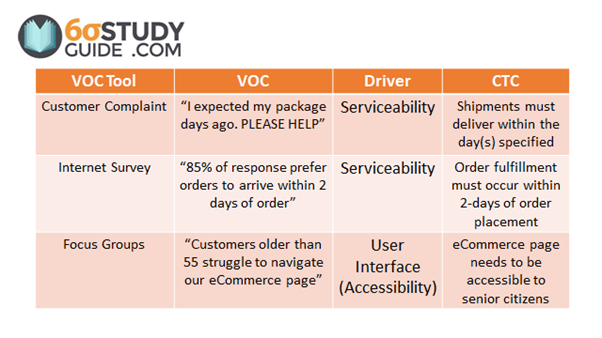
Business case
The next step is to take the information from the problem statement and the objectives and present a concise, clear case to management for the project’s benefits. Remember that despite the team’s pressing need for this project, it must compete for limited resources with initiatives from other teams within the department, division, or even corporate office. You want to provide management with a solid justification for investing resources in this project because no organization has the capacity to take on every project that has to be undertaken.
The financial foundation of a project that is directly tied to the problem statement is known as the business case. The business case is a succinct argument for why the project should begin. Typically, the first stage is to determine the demands of the project; nevertheless, it’s critical to keep in mind that they are distinct from the client’s wants.
Understanding the project’s relationship to the company’s overarching objectives is aided by the business case. In other words, it explains how the project affects the business’s strategic imperatives. There should be no project if there is no connection to strategy. The Six Sigma team is motivated by these links to complete the task. It’s crucial to connect to corporate strategy.
Project scope
The project’s boundaries are specified by the project scope. Understanding the beginning and end of the process is beneficial since it sheds light on the project’s limitations and dimensions. It makes an effort to outline the subject matter of the project deliverables. the project scope-creating team, including the team leader and champion.
Additionally, keep in mind that no organization has an insatiable thirst for budget, timeline, or scope. There is therefore always an opportunity to complete a second project to address issues that weren’t covered in the first. You may typically pick where to focus on the most important demands of the organization by identifying and designating the project scope.

Project Charter Milestones
Teams should make sure that each DMAIC phase has an end date and that everyone in the team agrees that the dates are appropriate given what the group wants to accomplish. Enumerate the tollgate meetings. The project sponsor or champion may set milestones in specific circumstances, but the team should concur that milestone dates are conceivable.
The team can review with their sponsors and offer a counter plan with reasonable justifications for why the original schedule would not be feasible if they believe that the due date won’t be met. Reverse engineering the tasks and activities required to fulfil all of the objectives using project management software will help you create schedules and guarantee that you have enough time to do everything that is required.
Stakeholders
Along with end users, the project charter includes significant stakeholders to help the team remember who and what they may affect. The list’s visibility during meetings decreases the possibility that the team will start working on modifications that can negatively affect other process owners and aids in directing the team to outside resources that can offer assistance, access, or information to areas linked to the project.
With the stakeholders, go over the project’s objectives and operational schedule. Be prepared to offer any information pertaining to them. They might have solutions to issues or better ideas on how to lower hazards. Stakeholders with a broad or in-depth understanding of the organization may occasionally be aware of problems and solutions that your team is not.
Constraints & Dependencies
Determine the project’s restrictions and dependencies, including certain global variables that must be true for the project to succeed and the effects if they are false. For instance, if the price of oil is less than $90 per barrel or if fewer than 50% of Americans support self-driving cars. Determine the elements that are both essential to the project’s success and show-stoppers. Are there conceivable occurrences that might completely undermine our endeavour, in other words?
Note: This list could include every item in existence. Focusing on the essential few that merit consideration is the best line of action.
Roles & Responsibilities of team members
When each member of the team has the right responsibilities and is aware of how those responsibilities relate to the team’s overall performance, the team functions at its best.
Possible Project Charter additions
Projects can occasionally result from earlier risk analysis work. If so, you should provide context by including them in the appendix. Include the budget or reference analysis as well, however it’s not required.

Exercise 1.11: Re-organize

Course Manual 12: Monitor Data over Time
Executing the Project Schedule
The apparent task after creating a project timetable is to carry it out. Giving the go-ahead to different teams is just one part of this; project management and tracking are also necessary to make sure that your objectives are met. You may employ devices like:
● Gantt chart
● Tracking Reporting and Corrective Action System (TRaCAS)
● Project responsibility matrix
● Commitment scale
● Stakeholder analysis
● Communication plan
● Documentation
● Burndown chart
An instrument for tracking projects is a Gantt chart, for instance. Using one, you may chart the development of your project and keep track of the connections between tasks. You will be able to immediately monitor the estimated project timeline blowout, for instance, if a few jobs take longer than anticipated.
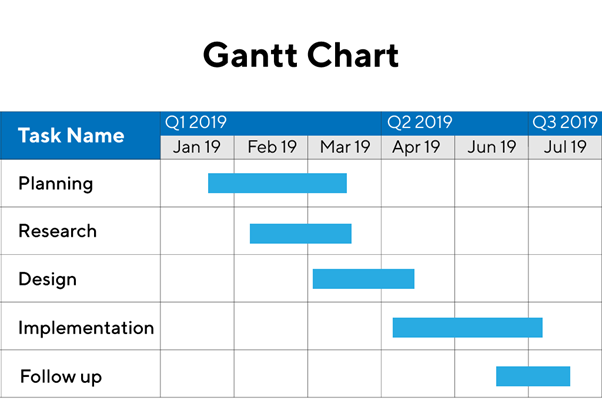
You can learn the tasks necessary for the present project via a Gantt chart.
● How much time you think the project will require.
● How much time you anticipate each task taking.
● When you anticipate beginning each work.
● Any dependencies are obligations that must be met before another task may be started.
Advantages
A few benefits of this style of chart for project management include:
● simple to comprehend
● A single activity is represented by each bar.
● The chart can be changed quite easily.
● can be built with only a few data points.
● displays work progress vs time.
● less complicated than a PERT chart or the Critical Path Method (CPM).
Disadvantages
It does, however, have a few drawbacks:
● DOES NOT demonstrate activity interdependence.
● It is not shown what happens if a task is started earlier or later.
● There is no method to show variances in the anticipated completion time.
● There are no task specifics mentioned.
● cannot be utilized to make predictions.
Part of Your Arsenal
The most important thing to keep in mind while weighing the benefits and drawbacks of Gantt charts is that you shouldn’t use them on their own. They work well for their intended function of tracking a project’s progress by charting task and phase completion. To get a complete picture of how your project is going, you’ll also need other tools.

Importance of Business Monitoring
Business monitoring is crucial to a company’s ability to carry out its everyday operations successfully. Businesses frequently need to deliver updates to stakeholders on their performance and advancement, and business monitoring approaches can assist experts in doing so. You can use company monitoring strategies to your advantage in the workplace more effectively if you recognize its significance.
In this course manual, we define business monitoring and go over a number of the reasons why it’s crucial for companies going through an acquisition phase.
What is business monitoring?
Monitoring a firm is keeping track of and evaluating its performance over time. To successfully manage and monitor progress during this process, goals and objectives are typically created. This process is frequently important for a corporation to implement because board members or other stakeholders may call for daily, weekly, or monthly performance reports. A company can employ the following key business monitoring techniques:
Process monitoring
You may determine whether you’re carrying out the steps necessary for a business to run smoothly by using process monitoring. Companies that share information regarding the implementation of new policies or operating procedures frequently engage in this type of business monitoring. This business monitoring procedure can also be used to communicate to the entire team how well the implementation processes went.
Progress tracking
Progress tracking keeps executives informed about departmental operations by concentrating on tracking a company’s progress toward achieving its goals. Many firms have goals and benchmarks to hit during specified time frames, such hitting sales targets or filling a certain number of positions. You can maintain efficiency while completing them by using progress tracking.
Performance monitoring
Any type of business needs to function at its best. Businesses typically have performance standards for their employees, and company monitoring may assist make sure everyone is able to satisfy those standards effectively. You have the chance to evaluate performance progress through performance monitoring, which gives you knowledge about how to better for upcoming jobs or projects.

Case Study: Uber
Uber is one example of a successful startup that uses business monitoring. Because of its ability to monitor client demand and alter its services accordingly, the ride-sharing company has swiftly become one of the most successful corporations in the world. Uber’s capacity to track consumer demand in real time enabled it to quickly capitalize on new markets and ensure that cars were always accessible when customers required them.

Case Study: Airbnb
Airbnb is another successful firm that employs business monitoring. Because of its capacity to assess client demand and change its offerings accordingly, the home-sharing platform has become one of the most popular businesses in the world. Airbnb records client preferences, feedback, and availability in order to give the best possible experience to customers. As a result, Airbnb has quickly established itself as one of the leading corporations in the home-sharing market.
The success of Uber and Airbnb shows how effective business monitoring can be for firms seeking success. Startups can boost profitability while simultaneously providing an exceptional customer experience by continuously monitoring client demand and modifying their services accordingly.
Why is business monitoring important?
Business monitoring is crucial because it affects a company’s bottom line and overall market success. Additional justifications for why business monitoring is crucial for a company’s expansion include:
Improves efficiency
Processes for business monitoring allow you to save time and effort. Business monitoring procedures frequently contribute to the development of operational business standards, giving you a foundation for particular tasks. These frameworks typically concentrate on improving efficiency so that staff members can complete jobs with the least amount of time and effort.
When a corporation uses performance monitoring, for instance, it can find a task that frequently takes too long to yield quantitative outcomes. The executives may modify this task’s processes until they are more effective, resulting in a reduction in time, using data from the process. The business might then implement this new procedure throughout other departments, standardizing the procedures for other crucial jobs.
Saves business costs
A business can function more cost-effectively by implementing business monitoring processes. You might find prospective financial hazards that could increase costs if they are not addressed over time as business monitoring attempts to spot problems before they become widespread. Additionally, you could learn how to lower operating expenses without lowering employee productivity. You might be able to reduce your post-production expenses by using a business monitoring method.
Lets you track resources
You can successfully track a company’s resources by using business monitoring. By creating business monitoring reports, you may learn what resources a company now has available for usage and what they could need in the future. As a result, business monitoring can assist in making sure a company has all the resources necessary to accomplish its objectives. For instance, you can utilize the business monitoring process to track the resources a company needs for each step of a project and purchase them in advance of each one.
Increases business operations visibility
Because they aid in your comprehension of how a business operates, it is crucial to continue to be aware of all business activities, their development over time, and specific processes. By using business monitoring procedures, you may better monitor or track activity across all departments, giving you greater visibility into all facets of the company. Departments can communicate about business operations more effectively thanks to this visibility.
Keeps you updated
Consistent business monitoring makes sure you’re always informed of how the company is performing. Depending on your demands, you can produce reports of business monitoring findings daily, weekly, monthly, or annually. These reports may contain a variety of significant data, such as sales produced during a given month, project progress made each week, or marketing efforts that were launched over the course of the year. You can also inform the entire crew of these updates so they are aware of both the company’s status and their own performance.
Gives you insight into management practices
The management operations of a firm can be improved with the help of business monitoring reports. For instance, you can typically find details regarding company accomplishments, costs, difficulties, development milestones, and possibilities for improvement. In order to more effectively accomplish organizational objectives or support their employees, management might use this information to develop new processes, strategies, policies, and budgets.
Helps you identify issues and solutions
Regularly monitoring a company’s operations might help you spot any potential problems before they arise. You can discover possible problems by comparing project results with accepted metrics by producing reports over specific time frames. You can create practical solutions quickly as a result. Key performance indicators (KPIs), for instance, may be used by a social media marketing firm to gauge the success of engagement on its profiles. Executives may be better able to determine which post types get the most engagement if they adopt a KPI business monitoring methodology.
Guarantees transparency
Public corporations often produce an annual financial report detailing their earnings, costs, and ownership information. To ensure open communication between a business and the general public, you distribute this yearly report to the federal government, investors, and stockholders. By consistently engaging in business monitoring activities, you can gather comprehensive information about the organization and use it to produce accurate, thorough annual reports.
To conclude
It should now be obvious why doing a business assessment is essential for your road toward acquisitive expansion. You can focus on the areas of your business that are having trouble by being aware of your strengths and limitations. You will be able to identify the precise areas where an acquisition or merger may benefit your firm, as was already discussed. Inorganic growth can be a clever approach to boost your company’s profits, help you rule your sector, and gain market dominance.

Exercise 1.12: Open Questions
Project Studies
Project Study (Part 1) – Customer Service
The Head of this Department is to provide a detailed report relating to the Business Assessment process that has been implemented within their department, together with all key stakeholders, as a result of conducting this workshop, incorporating process: planning; development; implementation; management; and review. Your process should feature the following 12 parts:
01. Current State
02. Analysis Tools
03. Identify Stakeholders
04. Core Competencies
05. Market Differentiation
06. Mission/Vision Statement
07. Mapping Future State
08. Set Department Objectives
09. Prioritizing Tasks
10. Set KPIs
11. Create a Project Schedule
12. Monitor Data over Time
Please include the results of the initial evaluation and assessment.
Project Study (Part 2) – E-Business
The Head of this Department is to provide a detailed report relating to the Business Assessment process that has been implemented within their department, together with all key stakeholders, as a result of conducting this workshop, incorporating process: planning; development; implementation; management; and review. Your process should feature the following 12 parts:
01. Current State
02. Analysis Tools
03. Identify Stakeholders
04. Core Competencies
05. Market Differentiation
06. Mission/Vision Statement
07. Mapping Future State
08. Set Department Objectives
09. Prioritizing Tasks
10. Set KPIs
11. Create a Project Schedule
12. Monitor Data over Time
Please include the results of the initial evaluation and assessment.
Project Study (Part 3) – Finance
The Head of this Department is to provide a detailed report relating to the Business Assessment process that has been implemented within their department, together with all key stakeholders, as a result of conducting this workshop, incorporating process: planning; development; implementation; management; and review. Your process should feature the following 12 parts:
01. Current State
02. Analysis Tools
03. Identify Stakeholders
04. Core Competencies
05. Market Differentiation
06. Mission/Vision Statement
07. Mapping Future State
08. Set Department Objectives
09. Prioritizing Tasks
10. Set KPIs
11. Create a Project Schedule
12. Monitor Data over Time
Please include the results of the initial evaluation and assessment.
Project Study (Part 4) – Globalization
The Head of this Department is to provide a detailed report relating to the Business Assessment process that has been implemented within their department, together with all key stakeholders, as a result of conducting this workshop, incorporating process: planning; development; implementation; management; and review. Your process should feature the following 12 parts:
01. Current State
02. Analysis Tools
03. Identify Stakeholders
04. Core Competencies
05. Market Differentiation
06. Mission/Vision Statement
07. Mapping Future State
08. Set Department Objectives
09. Prioritizing Tasks
10. Set KPIs
11. Create a Project Schedule
12. Monitor Data over Time
Please include the results of the initial evaluation and assessment.
Project Study (Part 5) – Human Resources
The Head of this Department is to provide a detailed report relating to the Business Assessment process that has been implemented within their department, together with all key stakeholders, as a result of conducting this workshop, incorporating process: planning; development; implementation; management; and review. Your process should feature the following 12 parts:
01. Current State
02. Analysis Tools
03. Identify Stakeholders
04. Core Competencies
05. Market Differentiation
06. Mission/Vision Statement
07. Mapping Future State
08. Set Department Objectives
09. Prioritizing Tasks
10. Set KPIs
11. Create a Project Schedule
12. Monitor Data over Time
Please include the results of the initial evaluation and assessment.
Project Study (Part 6) – Information Technology
The Head of this Department is to provide a detailed report relating to the Business Assessment process that has been implemented within their department, together with all key stakeholders, as a result of conducting this workshop, incorporating process: planning; development; implementation; management; and review. Your process should feature the following 12 parts:
01. Current State
02. Analysis Tools
03. Identify Stakeholders
04. Core Competencies
05. Market Differentiation
06. Mission/Vision Statement
07. Mapping Future State
08. Set Department Objectives
09. Prioritizing Tasks
10. Set KPIs
11. Create a Project Schedule
12. Monitor Data over Time
Please include the results of the initial evaluation and assessment.
Project Study (Part 7) – Legal
The Head of this Department is to provide a detailed report relating to the Business Assessment process that has been implemented within their department, together with all key stakeholders, as a result of conducting this workshop, incorporating process: planning; development; implementation; management; and review. Your process should feature the following 12 parts:
01. Current State
02. Analysis Tools
03. Identify Stakeholders
04. Core Competencies
05. Market Differentiation
06. Mission/Vision Statement
07. Mapping Future State
08. Set Department Objectives
09. Prioritizing Tasks
10. Set KPIs
11. Create a Project Schedule
12. Monitor Data over Time
Please include the results of the initial evaluation and assessment.
Project Study (Part 8) – Management
The Head of this Department is to provide a detailed report relating to the Business Assessment process that has been implemented within their department, together with all key stakeholders, as a result of conducting this workshop, incorporating process: planning; development; implementation; management; and review. Your process should feature the following 12 parts:
01. Current State
02. Analysis Tools
03. Identify Stakeholders
04. Core Competencies
05. Market Differentiation
06. Mission/Vision Statement
07. Mapping Future State
08. Set Department Objectives
09. Prioritizing Tasks
10. Set KPIs
11. Create a Project Schedule
12. Monitor Data over Time
Please include the results of the initial evaluation and assessment.

Project Study (Part 9) – Marketing
The Head of this Department is to provide a detailed report relating to the Business Assessment process that has been implemented within their department, together with all key stakeholders, as a result of conducting this workshop, incorporating process: planning; development; implementation; management; and review. Your process should feature the following 12 parts:
01. Current State
02. Analysis Tools
03. Identify Stakeholders
04. Core Competencies
05. Market Differentiation
06. Mission/Vision Statement
07. Mapping Future State
08. Set Department Objectives
09. Prioritizing Tasks
10. Set KPIs
11. Create a Project Schedule
12. Monitor Data over Time
Please include the results of the initial evaluation and assessment.

Project Study (Part 10) – Production
The Head of this Department is to provide a detailed report relating to the Business Assessment process that has been implemented within their department, together with all key stakeholders, as a result of conducting this workshop, incorporating process: planning; development; implementation; management; and review. Your process should feature the following 12 parts:
01. Current State
02. Analysis Tools
03. Identify Stakeholders
04. Core Competencies
05. Market Differentiation
06. Mission/Vision Statement
07. Mapping Future State
08. Set Department Objectives
09. Prioritizing Tasks
10. Set KPIs
11. Create a Project Schedule
12. Monitor Data over Time
Please include the results of the initial evaluation and assessment.

Project Study (Part 11) – Logistics
The Head of this Department is to provide a detailed report relating to the Business Assessment process that has been implemented within their department, together with all key stakeholders, as a result of conducting this workshop, incorporating process: planning; development; implementation; management; and review. Your process should feature the following 12 parts:
01. Current State
02. Analysis Tools
03. Identify Stakeholders
04. Core Competencies
05. Market Differentiation
06. Mission/Vision Statement
07. Mapping Future State
08. Set Department Objectives
09. Prioritizing Tasks
10. Set KPIs
11. Create a Project Schedule
12. Monitor Data over Time
Please include the results of the initial evaluation and assessment.

Project Study (Part 12) – Education
The Head of this Department is to provide a detailed report relating to the Business Assessment process that has been implemented within their department, together with all key stakeholders, as a result of conducting this workshop, incorporating process: planning; development; implementation; management; and review. Your process should feature the following 12 parts:
01. Current State
02. Analysis Tools
03. Identify Stakeholders
04. Core Competencies
05. Market Differentiation
06. Mission/Vision Statement
07. Mapping Future State
08. Set Department Objectives
09. Prioritizing Tasks
10. Set KPIs
11. Create a Project Schedule
12. Monitor Data over Time
Please include the results of the initial evaluation and assessment.
Program Benefits
Marketing
- Sales models
- Business growth
- Business strategy
- Customer loyalty
- Enhanced performance
- Improved responsiveness
- Opportunity analysis
- Supplier evaluation
- Corporate goals
- Market analysis
Management
- Engaged workforce
- Increased trust
- Heightened teamwork
- Productive meetings
- Idea generation
- Increased revenue
- Role clarity
- Role distinctions
- Tasking formula
- Effective communication
Finance
- Cost-effective
- Return on investment
- Budget friendly
- Financially sustainable
- Profitability enhancement
- Self-financing
- Performance improvement
- Cost savings
- Controlled growth
- Calculated risk
Client Telephone Conference (CTC)
If you have any questions or if you would like to arrange a Client Telephone Conference (CTC) to discuss this particular Unique Consulting Service Proposition (UCSP) in more detail, please CLICK HERE.
























